Mybatis框架
- Mybatis
- {} 解析为一个 JDBC 预编译语句(prepared statement)的参数标记符,一个 #{ } 被解析为一个参数占位符;而${}仅仅为一个纯碎的 string 替换,在动态 SQL 解析阶段将会进行变量替换。
- {} 解析之后会将String类型的数据自动加上引号,其他数据类型不会;而${} 解析之后是什么就是什么,他不会当做字符串处理。
- {} 很大程度上可以防止SQL注入(SQL注入是发生在编译的过程中,因为恶意注入了某些特殊字符,最后被编译成了恶意的执行操作);而${} 主要用于SQL拼接的时候,有很大的SQL注入隐患。
Mybatis
环境:
- JDK 1.8
- Mysql 5.7
- maven 3.6.1
- IDEA 2020.2
回顾:
- JDBC:https://blog.csdn.net/m0_46153949/article/details/107231974
- Mysql:https://blog.csdn.net/m0_46153949/article/details/107116168
- Java基础:https://blog.csdn.net/m0_46153949/article/details/106167213
- Maven:https://blog.csdn.net/m0_46153949/article/details/109265177
- Junit:https://blog.csdn.net/qq_40794973/article/details/89032870
SSM框架:配置文件的。 最好的方式:看官网文档;
1、简介
1.1、什么是Mybatis

- MyBatis 是一款优秀的持久层框架
- 它支持定制化 SQL、存储过程以及高级映射。
- MyBatis 避免了几乎所有的 JDBC 代码和手动设置参数以及获取结果集。
- MyBatis 可以使用简单的 XML 或注解来配置和映射原生类型、接口和 Java 的 POJO(Plain Old Java Objects,普通老式 Java 对象)为数据库中的记录。
- MyBatis 本是apache的一个开源项目iBatis, 2010年这个项目由apache software foundation 迁移到了google code,并且改名为MyBatis 。
- 2013年11月迁移到Github。
如何获得Mybatis?
-
maven仓库:
<!-- https://mvnrepository.com/artifact/org.mybatis/mybatis --> <dependency> <groupId>org.mybatis</groupId> <artifactId>mybatis</artifactId> <version>3.5.7</version> </dependency>


1.2、持久化
数据持久化:
- 持久化就是将程序的数据在持久状态和瞬时状态转化的过程。
- 内存:断电即失。
- 数据库(Jdbc),io文件持久化。
- 联系于生活:冷藏、罐头。
为什么需要持久化?
-
有一些硬盘里的对象,不能让他丢掉!!!
-
内存太贵了。
1.3、持久层
Dao层,Service层,Controller层….
- 完成持久化工作的代码块
- 层界限十分明显。
1.4 为什么需要Mybatis?
- 帮助程序猿将数据存入到数据库中。
- 方便
- 传统的JDBC代码太复杂了。简化。框架。自动化。
- 不用Mybatis也可以,更容易上手。
- 优点:
- 简单易学。
- 灵活。
- sql和代码的分离,提高了可维护性。
- 提供映射标签,支持对象与数据库的orm字段(Object Relational Mapping)关系映射。(1)
- 提供对象关系映射标签,支持对象关系组建维护。(2)
- 提供xml标签,支持编写动态sql。(3)
最重要的一点:使用的人多!
Mybatis学完后,学Spring ---> SpringMVC ---> SpringBoot
2、第一个Mybatis程序
- 思路:搭建环境-->导入Mybatis-->编写代码-->测试!
2.1、搭建环境
搭建数据库
CREATE DATABASE mybatis;
USE mybatis;
CREATE TABLE USER (
id INT ( 20 ) NOT NULL PRIMARY KEY,
NAME VARCHAR ( 30 ) DEFAULT NULL,
pwd VARCHAR ( 30 ) DEFAULT NULL
) ENGINE = INNODB DEFAULT charset = utf8; //引擎,字符集
INSERT INTO USER ( id, NAME, pwd )
VALUES
( 1, 'subei', '123456' ),
( 2, '哇哈哈', '952741' ),
( 3, '欣杰克', '854362' );
新建项目
- 新建一个普通的maven项目
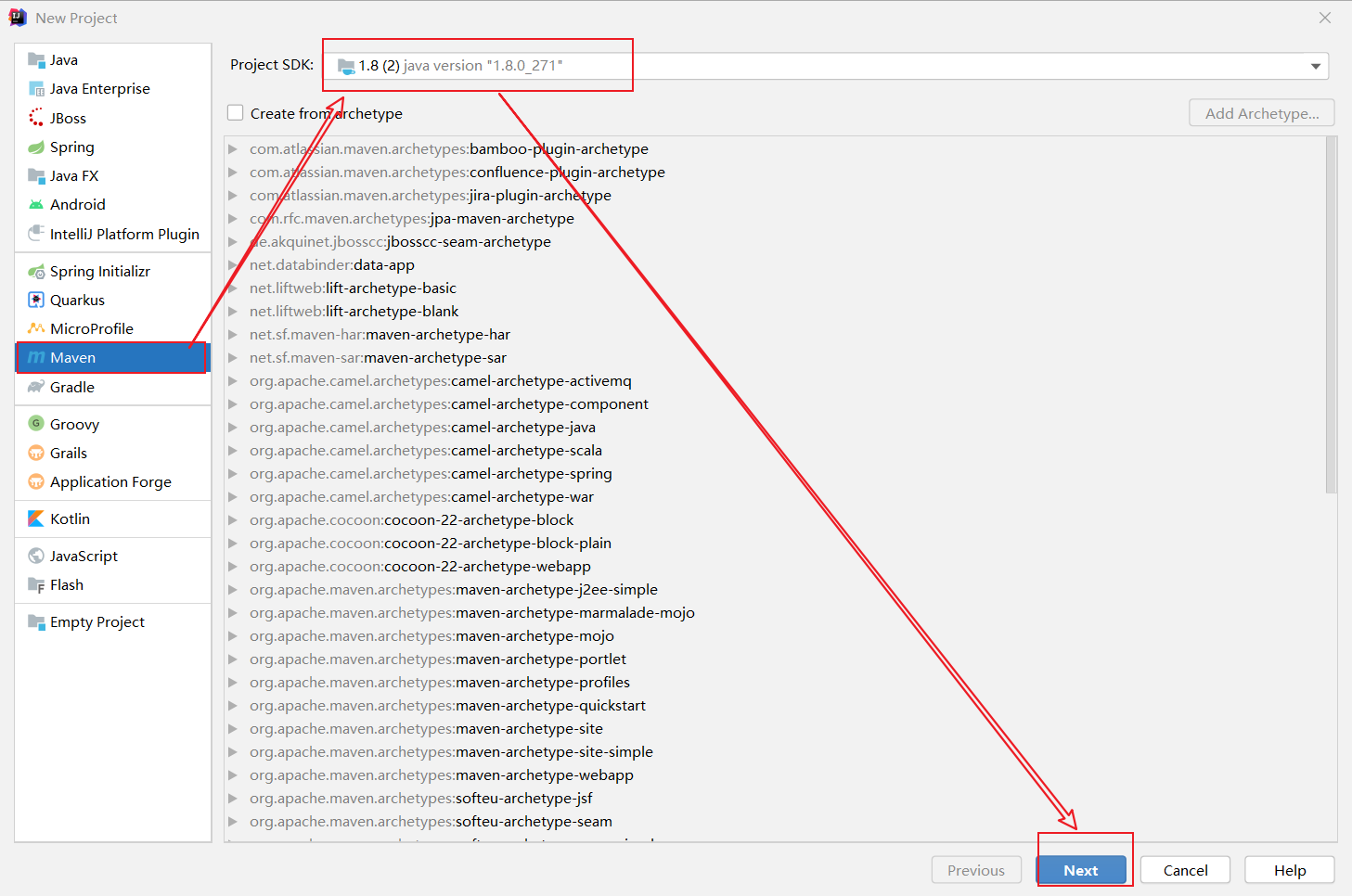
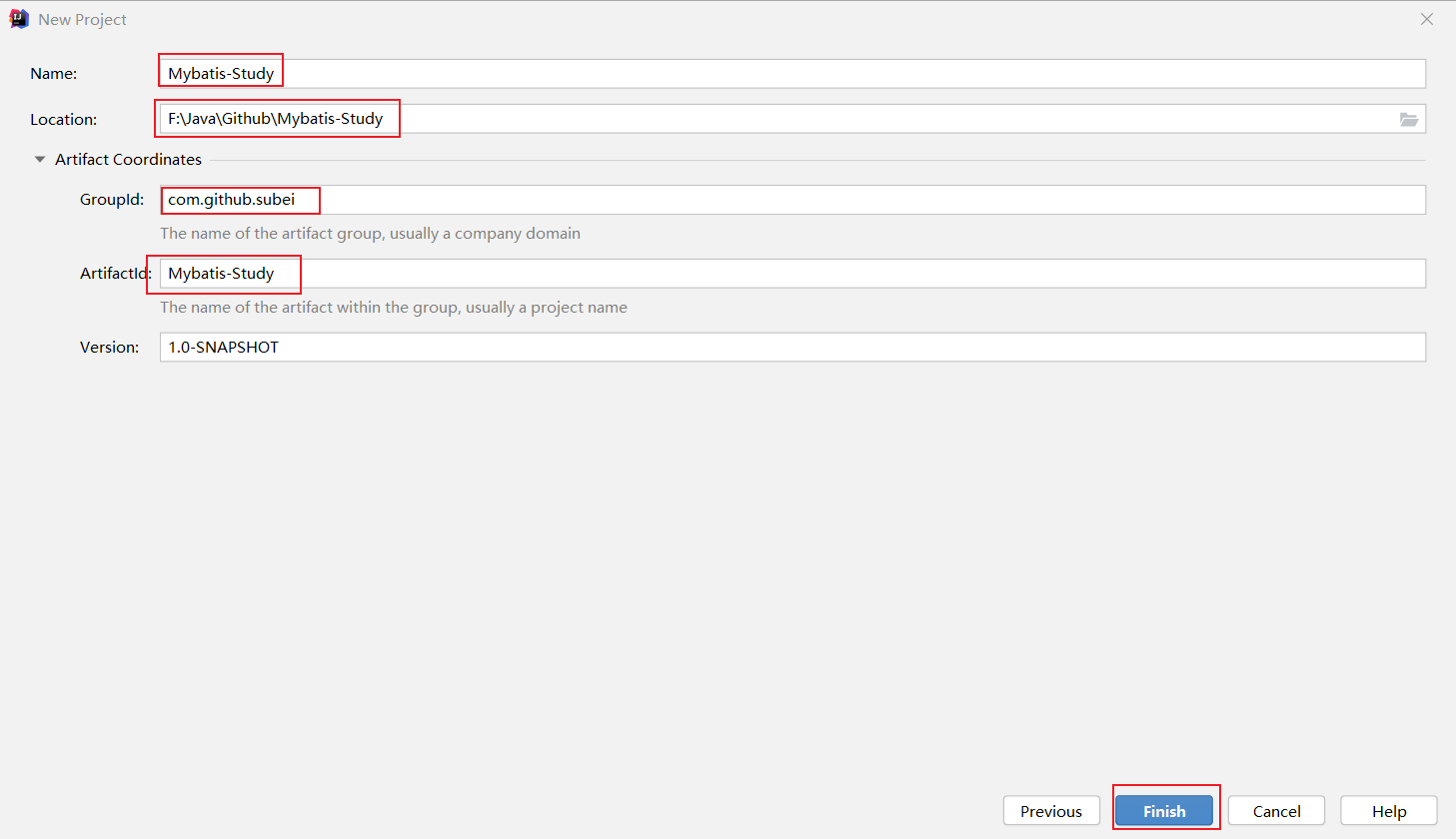

- 删除src目录

-
导入maven依赖
<!-- 导入依赖 --> <dependencies> <!--mysql驱动--> <dependency> <groupId>mysql</groupId> <artifactId>mysql-connector-java</artifactId> <version>5.1.47</version> </dependency> <!--mybatis--> <dependency> <groupId>org.mybatis</groupId> <artifactId>mybatis</artifactId> <version>3.5.2</version> </dependency> <!--junit--> <dependency> <groupId>junit</groupId> <artifactId>junit</artifactId> <version>4.12</version> </dependency> </dependencies>
2.2、创建一个模块
Mybatis 3.5.4 中文官方文档:https://www.yuque.com/nizhegechouloudetuboshu/library/zsd0mk
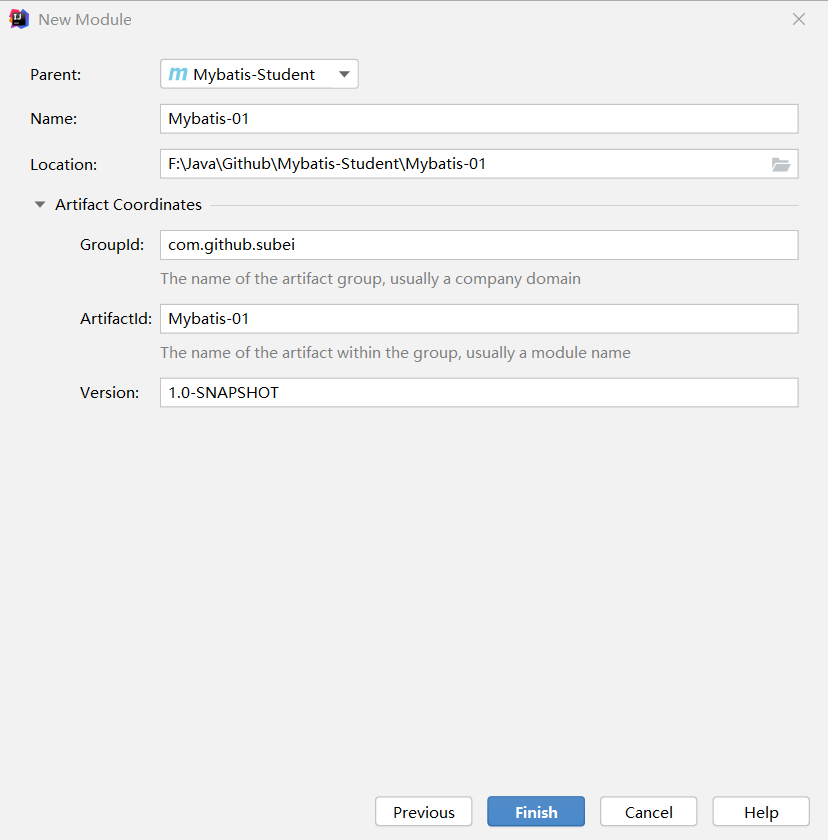
-
编写mybatis的核心配置文件——mybatis-config.xml
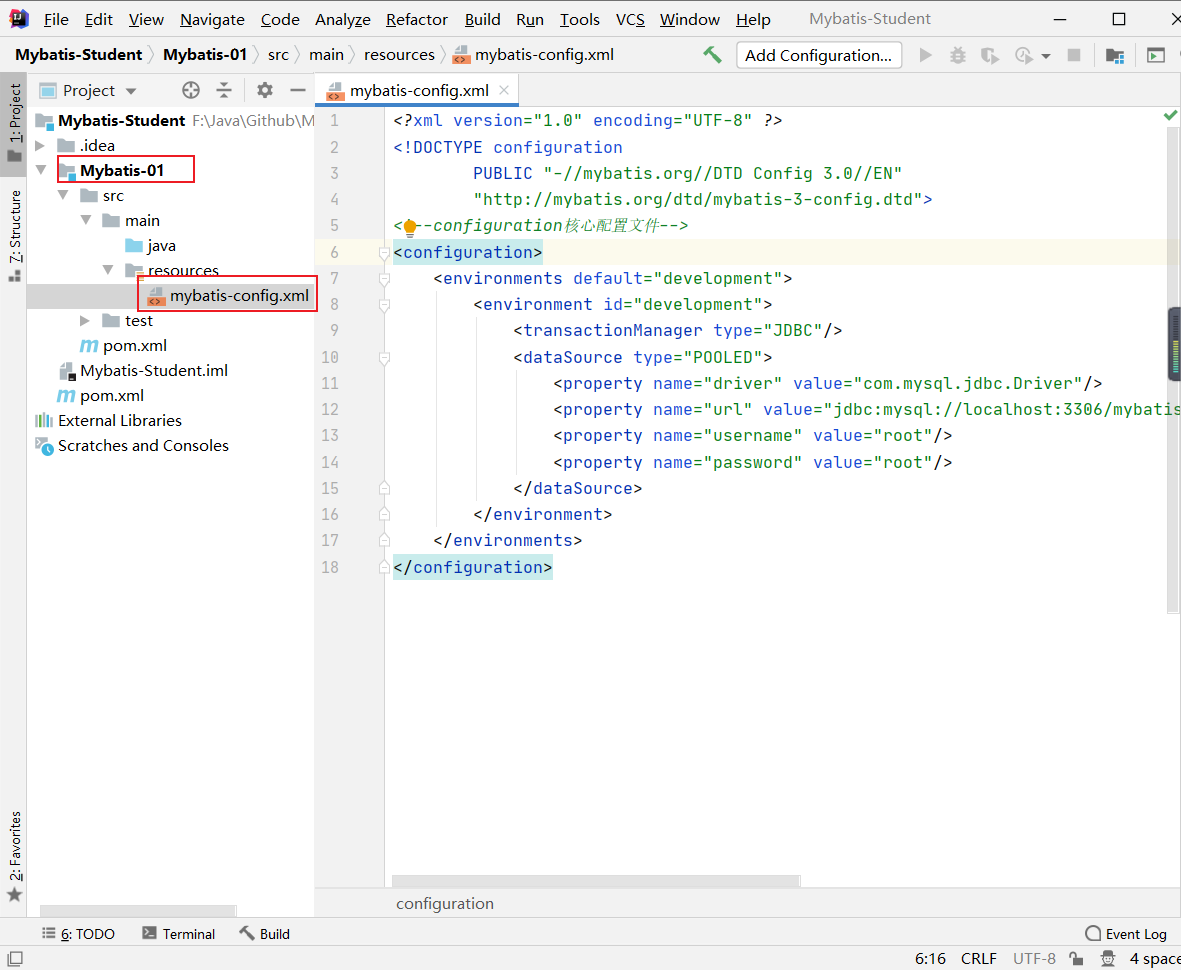
<?xml version="1.0" encoding="UTF-8" ?> <!DOCTYPE configuration PUBLIC "-//mybatis.org//DTD Config 3.0//EN" "http://mybatis.org/dtd/mybatis-3-config.dtd"> <!--configuration核心配置文件--> <configuration> <environments default="development"> <environment id="development"> <transactionManager type="JDBC"/> <dataSource type="POOLED"> <property name="driver" value="com.mysql.jdbc.Driver"/> <property name="url" value="jdbc:mysql://localhost:3306/mybatis?useSSL=true&serverTimezone=UTC&useUnicode=true&characterEncoding=UTF-8"/> <property name="username" value="root"/> <property name="password" value="root"/> </dataSource> </environment> </environments> <!-- 每一个Mapper.xml都需要在mybatis核心配置文件中注册! --> <mappers> <mapper resource="com/github/subei/dao/UserMapper.xml"/> </mappers> </configuration> -
编写mybatis工具类,MybatisUtils.java
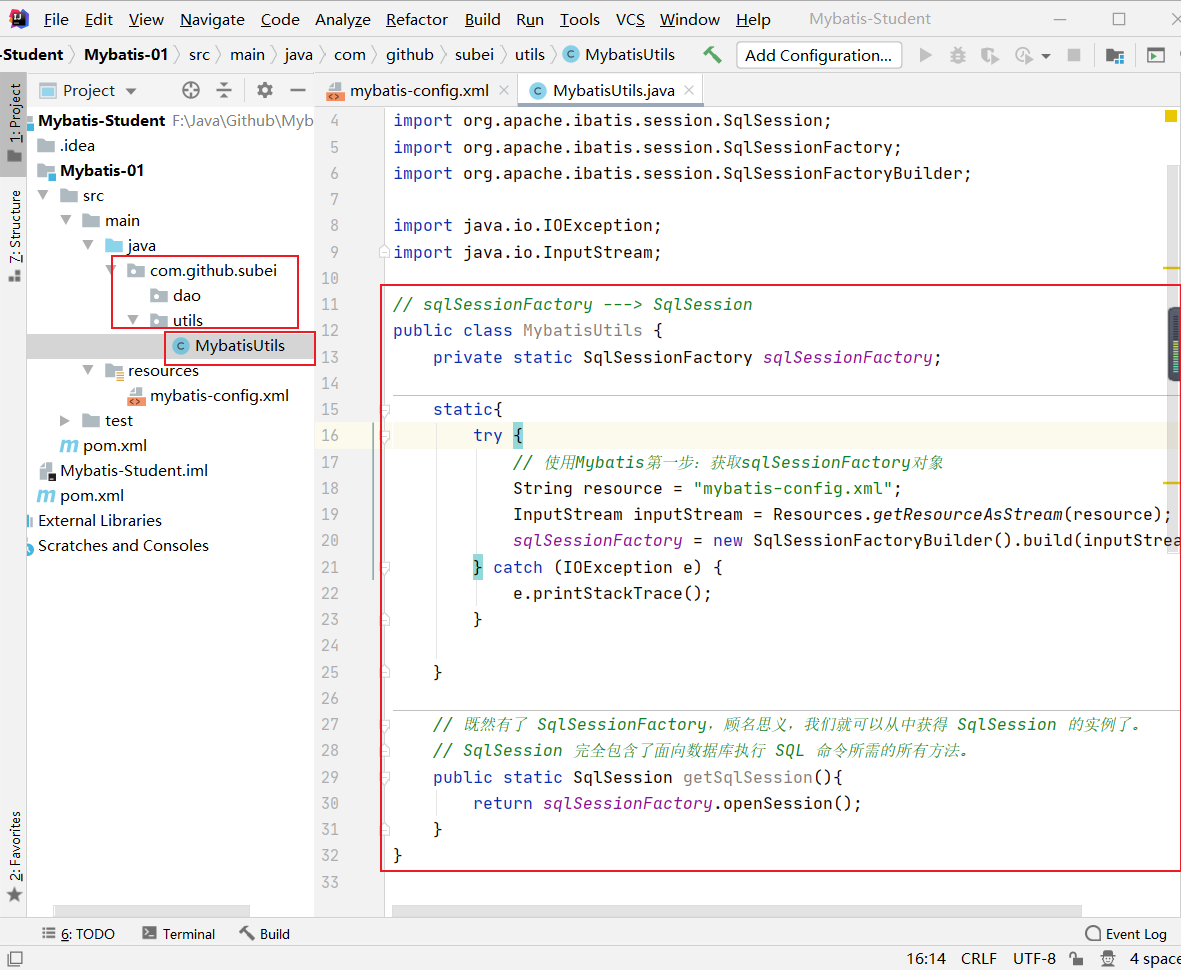
package com.github.subei.utils; import org.apache.ibatis.io.Resources; import org.apache.ibatis.session.SqlSession; import org.apache.ibatis.session.SqlSessionFactory; import org.apache.ibatis.session.SqlSessionFactoryBuilder; import java.io.IOException; import java.io.InputStream; // sqlSessionFactory ---> SqlSession public class MybatisUtils { private static SqlSessionFactory sqlSessionFactory; static{ try { // 使用Mybatis第一步:获取sqlSessionFactory对象 String resource = "mybatis-config.xml"; InputStream inputStream = Resources.getResourceAsStream(resource); sqlSessionFactory = new SqlSessionFactoryBuilder().build(inputStream); } catch (IOException e) { e.printStackTrace(); } } // 既然有了 SqlSessionFactory,顾名思义,我们就可以从中获得 SqlSession 的实例了。 // SqlSession 完全包含了面向数据库执行 SQL 命令所需的所有方法。 public static SqlSession getSqlSession(){ return sqlSessionFactory.openSession(); } }
2.3、编写代码
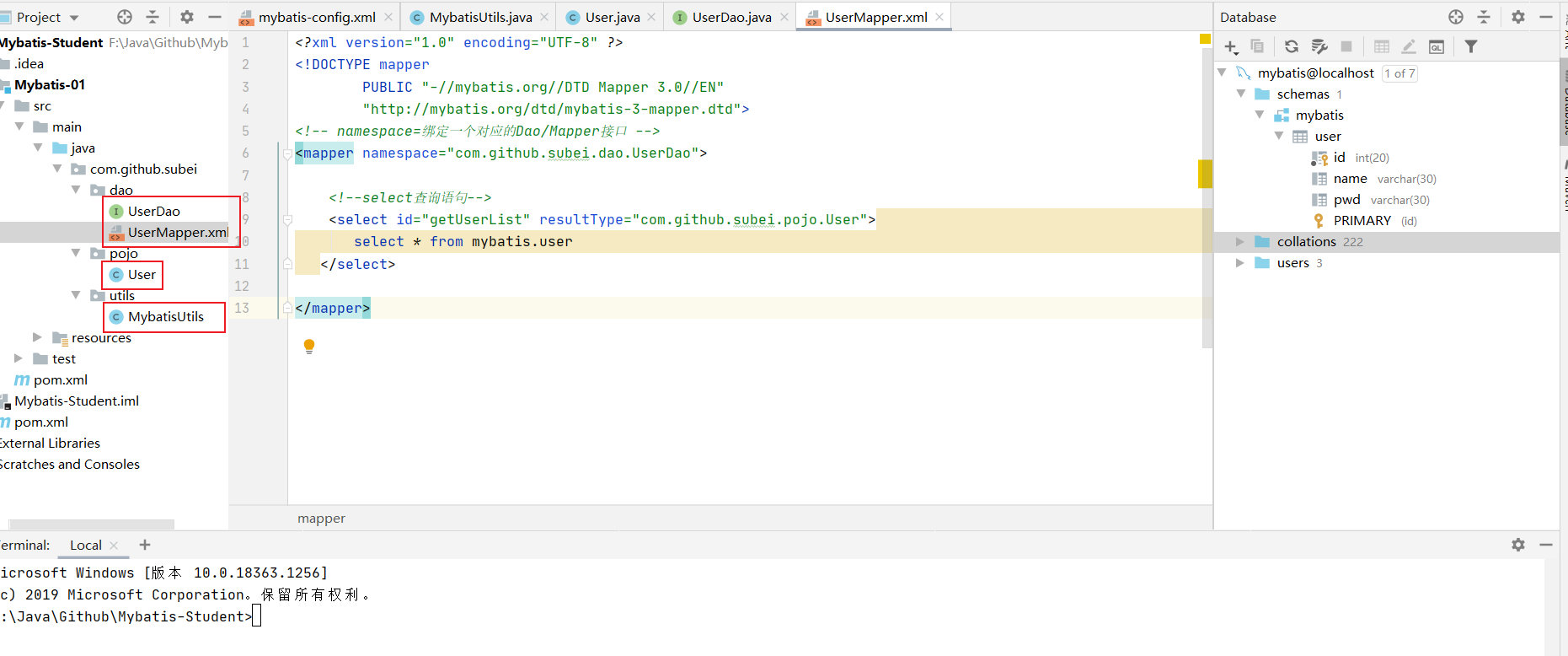
-
实体类
package com.github.subei.pojo; // 实体类 public class User { private int id; private String name; private String pwd; public int getId() { return id; } public void setId(int id) { this.id = id; } public String getName() { return name; } public void setName(String name) { this.name = name; } public String getPwd() { return pwd; } public void setPwd(String pwd) { this.pwd = pwd; } public User() { } public User(int id, String name, String pwd) { this.id = id; this.name = name; this.pwd = pwd; } @Override public String toString() { return "User{" + "id=" + id + ", name='" + name + '\'' + ", pwd='" + pwd + '\'' + '}'; } } -
Dao接口
package com.github.subei.dao; import com.github.subei.pojo.User; import java.util.List; public interface UserDao { List<User> getUserList(); } -
接口实现类由原来的UserDaoImpl转变为一个 Mapper配置文件.
<?xml version="1.0" encoding="UTF-8" ?> <!DOCTYPE mapper PUBLIC "-//mybatis.org//DTD Mapper 3.0//EN" "http://mybatis.org/dtd/mybatis-3-mapper.dtd"> <!-- namespace=绑定一个对应的Dao/Mapper接口 --> <mapper namespace="com.github.subei.dao.UserDao"> <!--select查询语句--> <select id="getUserList" resultType="com.github.subei.pojo.User"> select * from mybatis.user; </select> </mapper>
2.4、测试
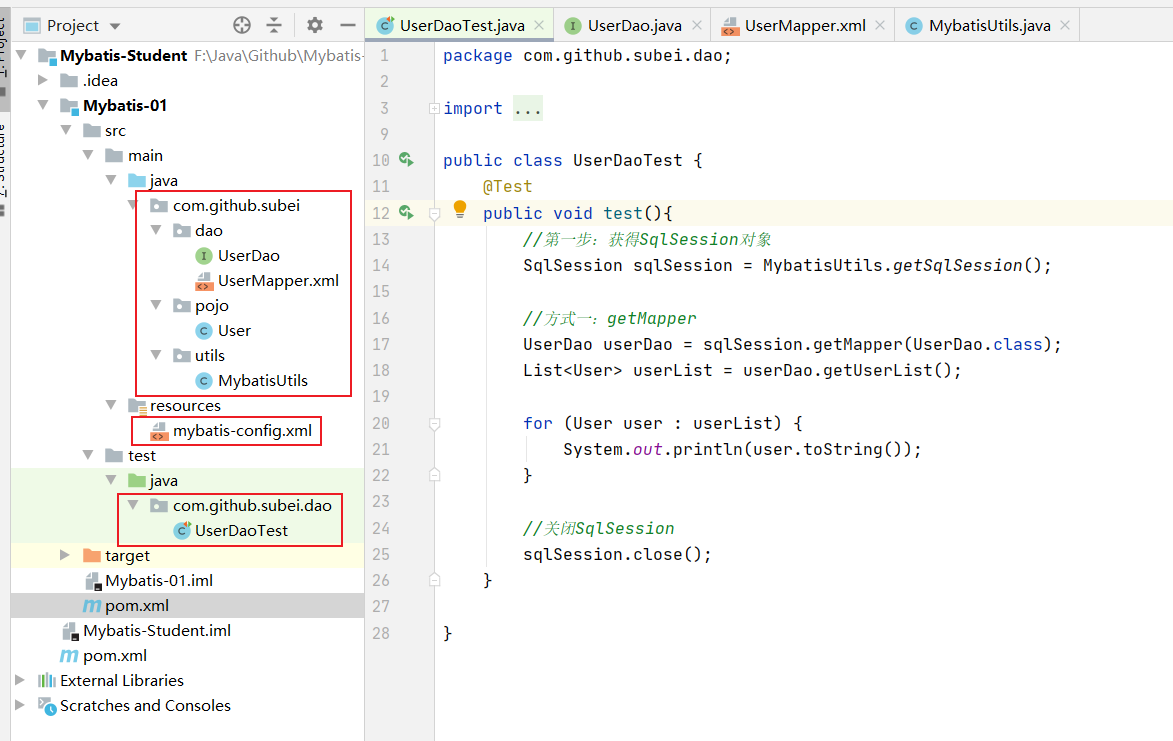
-
junit测试
package com.github.subei.dao; import com.github.subei.pojo.User; import com.github.subei.utils.MybatisUtils; import org.apache.ibatis.session.SqlSession; import org.junit.Test; import java.util.List; public class UserDaoTest { @Test public void test(){ //第一步:获得SqlSession对象 SqlSession sqlSession = MybatisUtils.getSqlSession(); //方式一:getMapper UserDao userDao = sqlSession.getMapper(UserDao.class); List<User> userList = userDao.getUserList(); //方式二:不推荐使用!!! // List<User> userList = sqlSession.selectList("com.github.dao.UserDao.getUserList"); for (User user : userList) { System.out.println(user); } //关闭SqlSession sqlSession.close(); } }
可以能会遇到的问题:
- 配置文件没有注册
- 绑定接口错误。
- 方法名不对
- 返回类型不对
- Maven导出资源问题
day01学习中遇到的报错
报错:error:java :程序包org.apache.ibatis.io不存在。:程序包org.apache.ibatis.session不存在

- IDEA 2020.1版本报错,解决方法: 出现这个问题根本办法是修改一下maven home directory为Bundled (Maven 3),并修改为默认给的路径,不要用自己的maven本地仓库的路径,用idea 2020 内置的maven ,至于具体原因,可能是IDEA2020的新功能吧,但能解决!!!
- 第一步,修改maven地址:
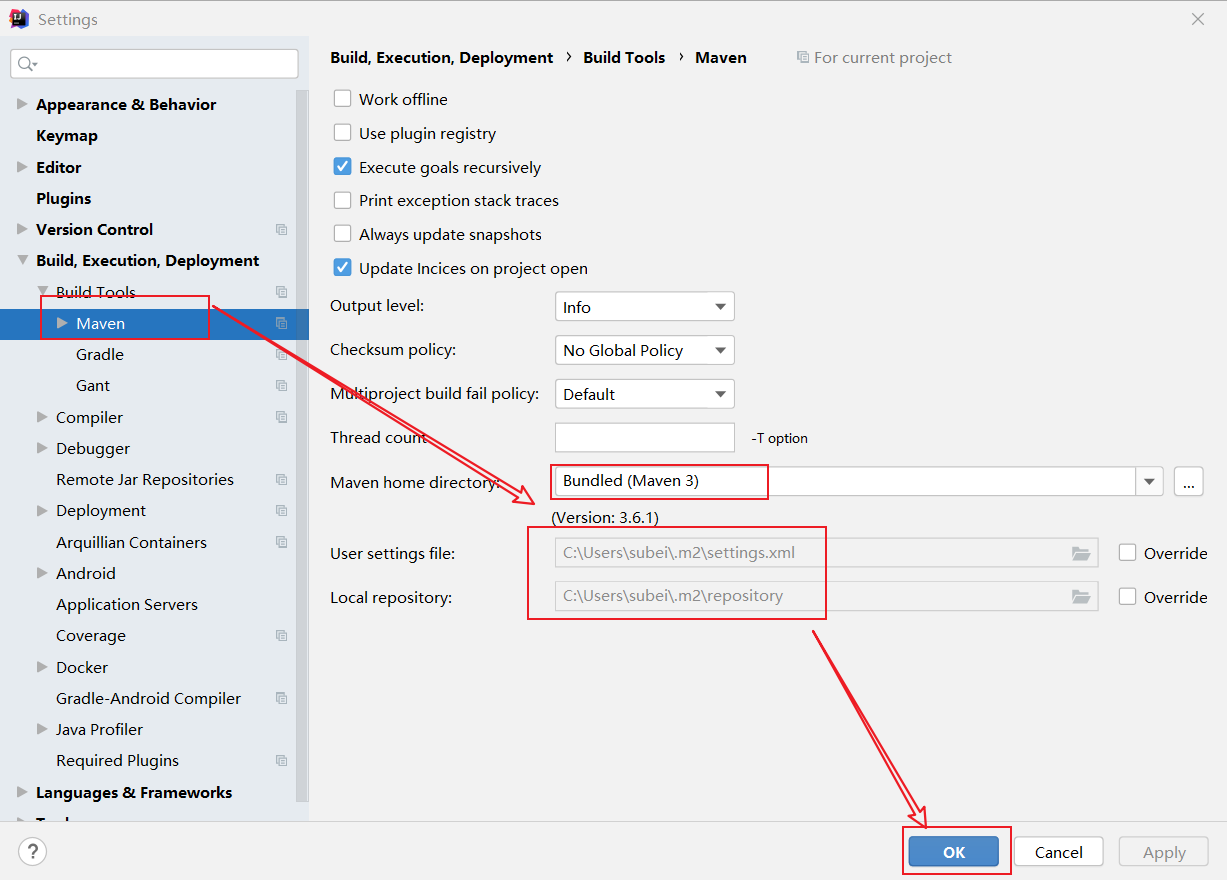
- 第二步,重装仓库文件:

- 第三步,运行程序:
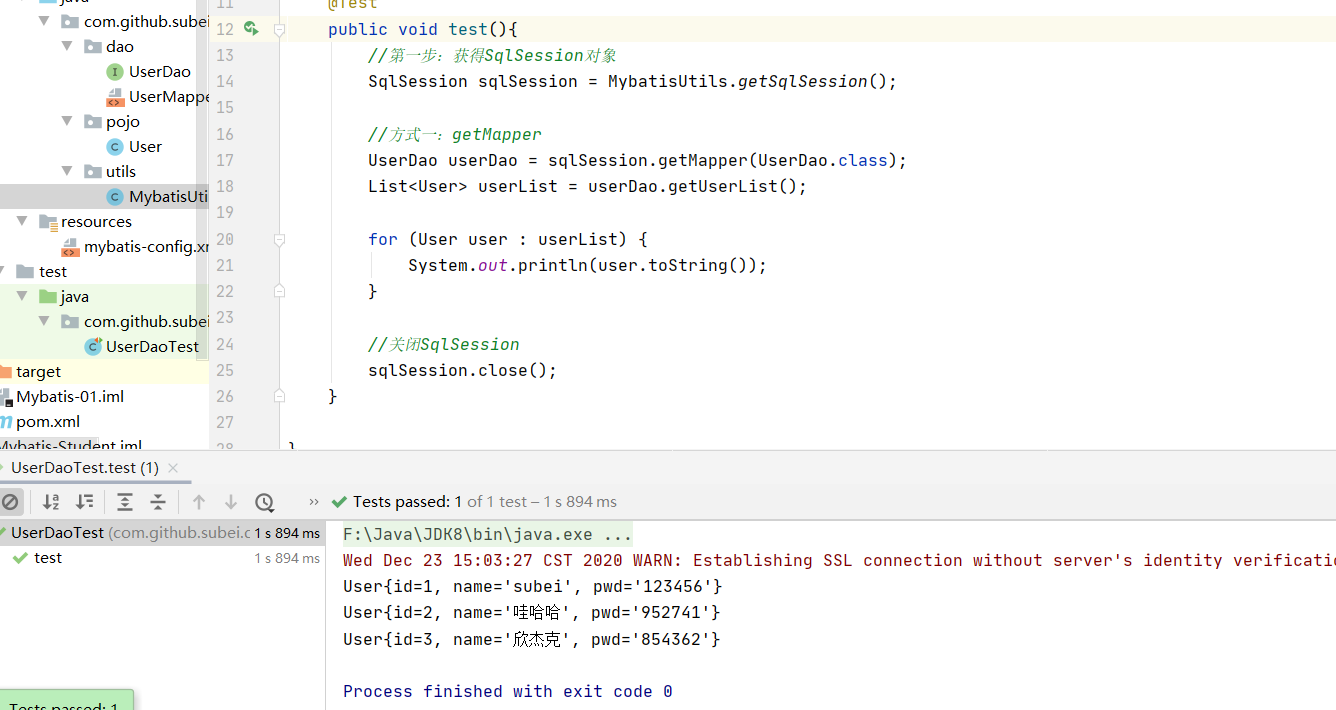
如果还不行,参考这个解决:https://blog.csdn.net/bin_bujiangjiu/article/details/106727561
报错:org.apache.ibatis.binding.BindingException: Type interface com.github.subei.dao.UserDao is not known to the MapperRegistry.

- 解决方法:在mybatis-config.xm文件中添加如下代码:
<!-- 每一个Mapper.xml都需要在mybatis核心配置文件中注册! -->
<mappers>
<mapper resource="com/github/subei/dao/UserMapper.xml"/>
</mappers>
MapperRegistry是什么?
- 核心配置文件中注册 mappers
报错:java.lang.ExceptionInInitializerError at com.kuang.dao.UserDaoTest.test(UserDaoTest.java:15)

- 解决方法:在最外层的pom.xml文件中,添加如下代码:
<!--在build中配置resources,来防止我们资源导出失败的问题-->
<build>
<resources>
<resource>
<directory>src/main/resources</directory>
<includes>
<include>**/*.properties</include>
<include>**/*.xml</include>
</includes>
<filtering>true</filtering>
</resource>
<resource>
<directory>src/main/java</directory>
<includes>
<include>**/*.properties</include>
<include>**/*.xml</include>
</includes>
<filtering>true</filtering>
</resource>
</resources>
</build>
- 添加后,如果还是报错,请删除所有.xml文件中的中文注释!具体原因不明。
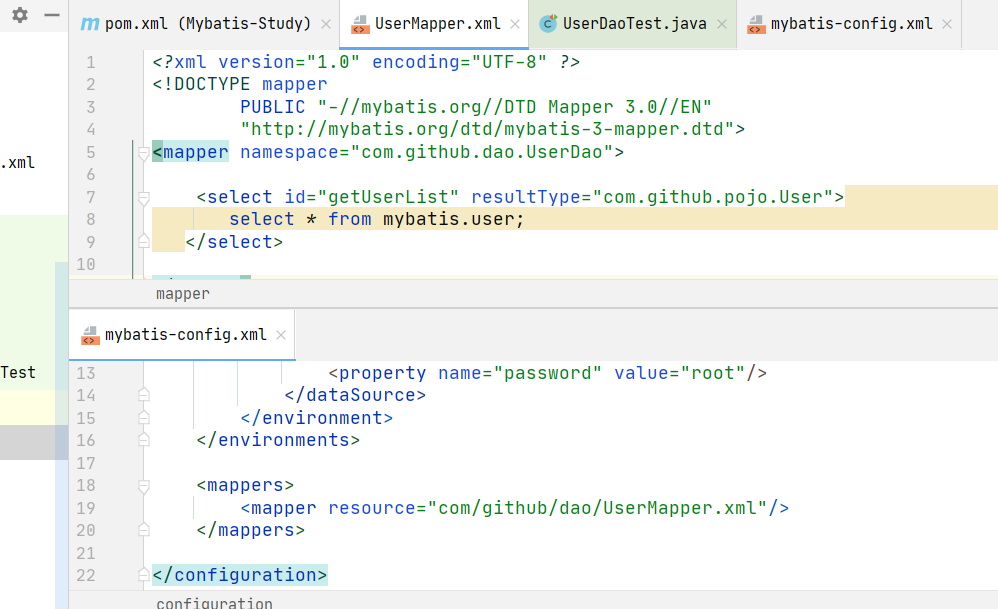
参考博文①:https://blog.csdn.net/bin_bujiangjiu/article/details/106784700
参考博客②:https://blog.csdn.net/bin_bujiangjiu/article/details/106727561
感谢大佬的博客帮我解决问题,节省时间!!!
3、CRUD
1、namespace
- Mapper.xml中namespace中的包名要和 Dao/mapper 接口的包名一致!
2、select
选择,查询语句(UserMapper.xml解释);
- id : 就是对应的namespace中的方法名;
- resultType:Sql语句执行的返回值!
- parameterType : 参数类型!
-
编写接口
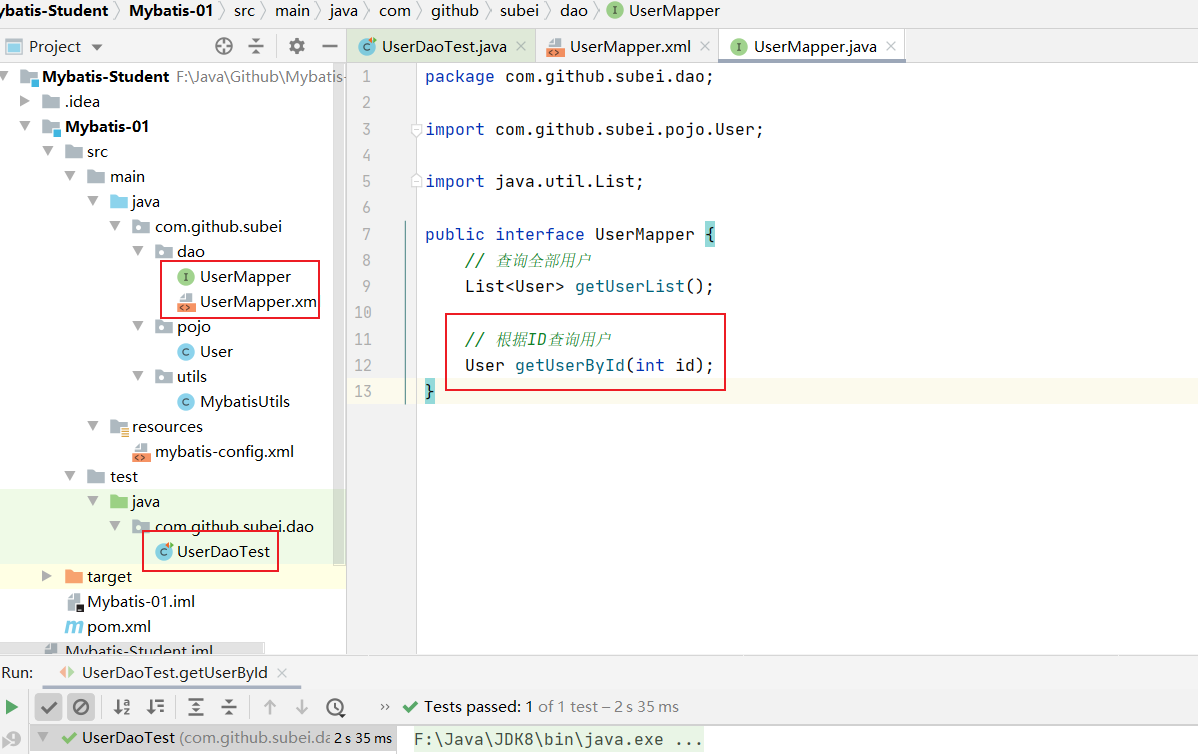
// 根据ID查询用户 User getUserById(int id); -
编写对应的mapper中的sql语句
<select id="getUserById" parameterType="int" resultType="com.github.subei.pojo.User"> select * from mybatis.user where id = #{id}; </select> -
测试
@Test public void getUserById(){ //第一步:获得SqlSession对象 SqlSession sqlSession = MybatisUtils.getSqlSession(); //推荐方式:getMapper UserMapper mapper = sqlSession.getMapper(UserMapper.class); User user = mapper.getUserById(1); System.out.println(user); //关闭SqlSession sqlSession.close(); }
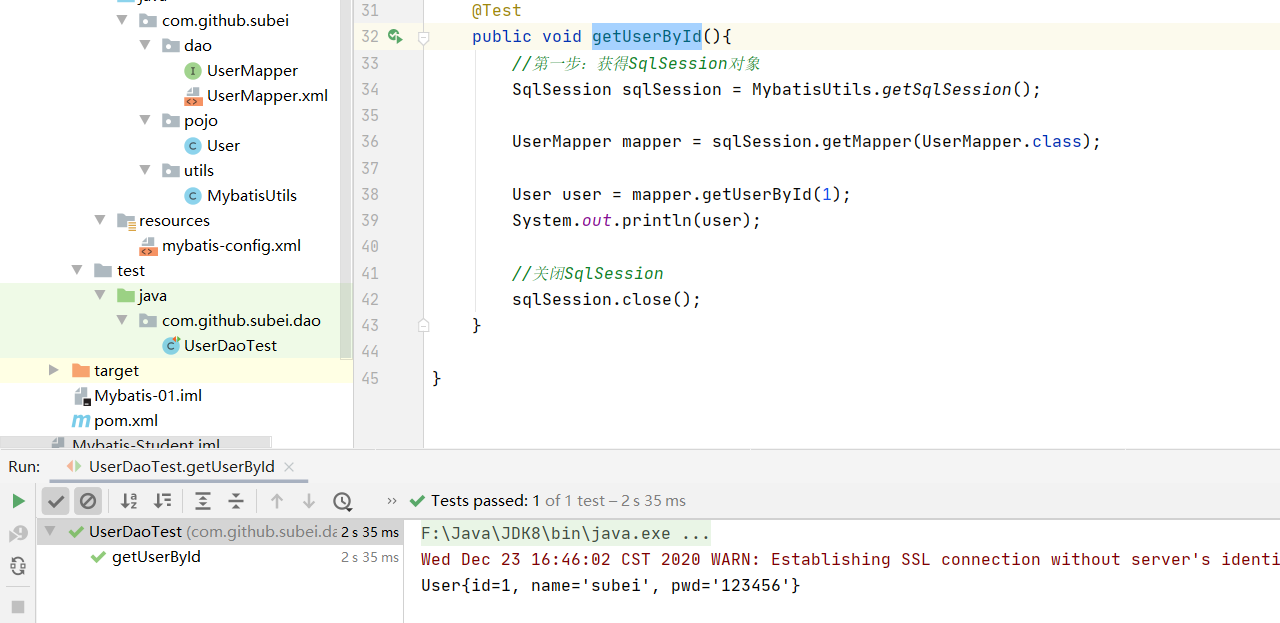
3、Insert
- 编写接口
// insert一个用户
int addUser(User user);
- 编写对应的mapper中的sql语句
<!--对象中的属性,可以直接取出来-->
<insert id="addUser" parameterType="com.github.subei.pojo.User">
insert into mybatis.user (id, name, pwd) values (#{id},#{name},#{pwd});
</insert>
- 测试
// 增删改需要提交事务
@Test
public void addUser(){
//第一步:获得SqlSession对象
SqlSession sqlSession = MybatisUtils.getSqlSession();
UserMapper mapper = sqlSession.getMapper(UserMapper.class);
int res = mapper.addUser(new User(4,"好多鱼","421563"));
if(res>0){
System.out.println("插入成功!!");
}
//提交事务
sqlSession.commit();
//关闭SqlSession
sqlSession.close();
}
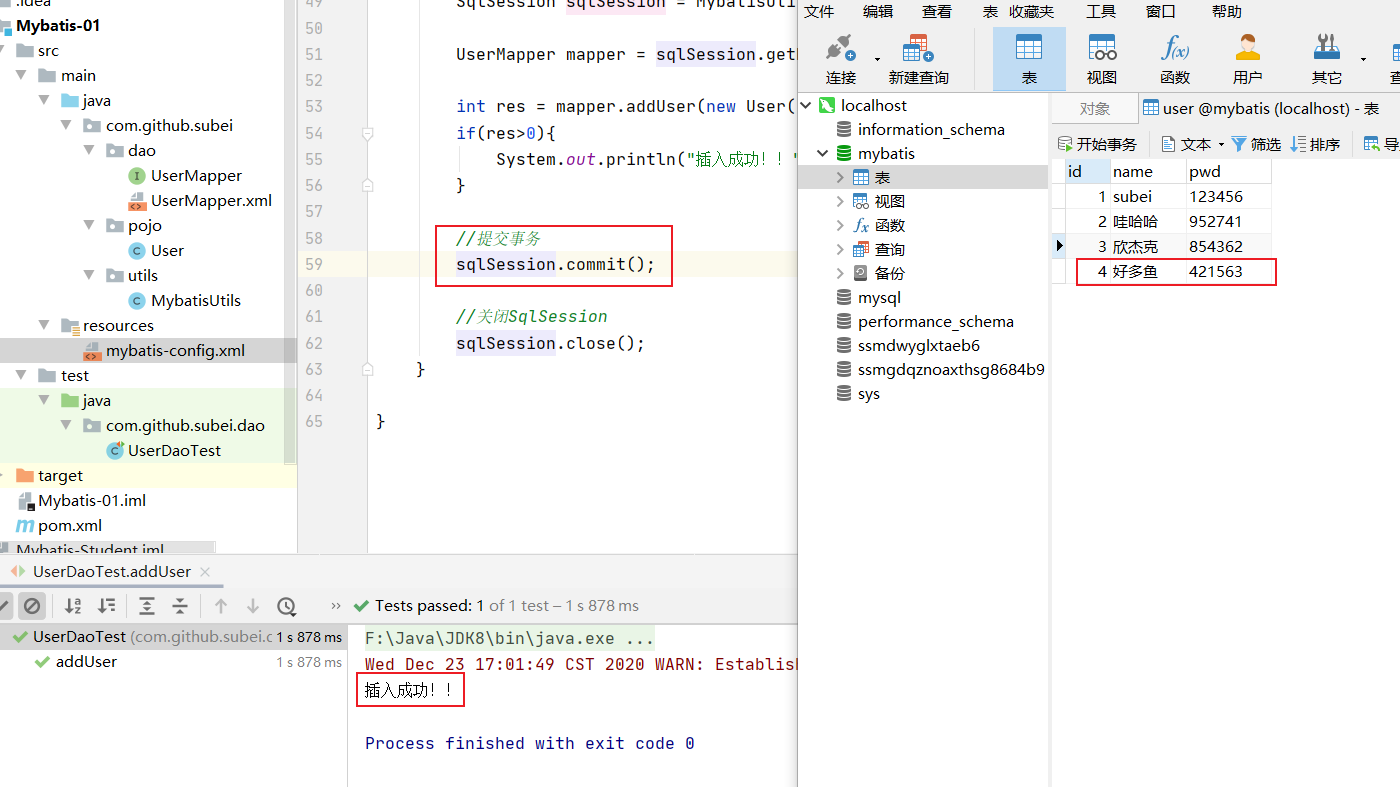
4、update
// // 增删改需要提交事务,修改用户
int updateUser(User user);
<update id="updateUser" parameterType="com.github.subei.pojo.User">
update mybatis.user set name=#{name},pwd=#{pwd} where id = #{id};
</update>
@Test
public void updateUser(){
//第一步:获得SqlSession对象
SqlSession sqlSession = MybatisUtils.getSqlSession();
UserMapper mapper = sqlSession.getMapper(UserMapper.class);
int res = mapper.updateUser(new User(4,"好多鱼","233333"));
if(res>0){
System.out.println("上传成功!!");
}
//提交事务
sqlSession.commit();
//关闭SqlSession
sqlSession.close();
}
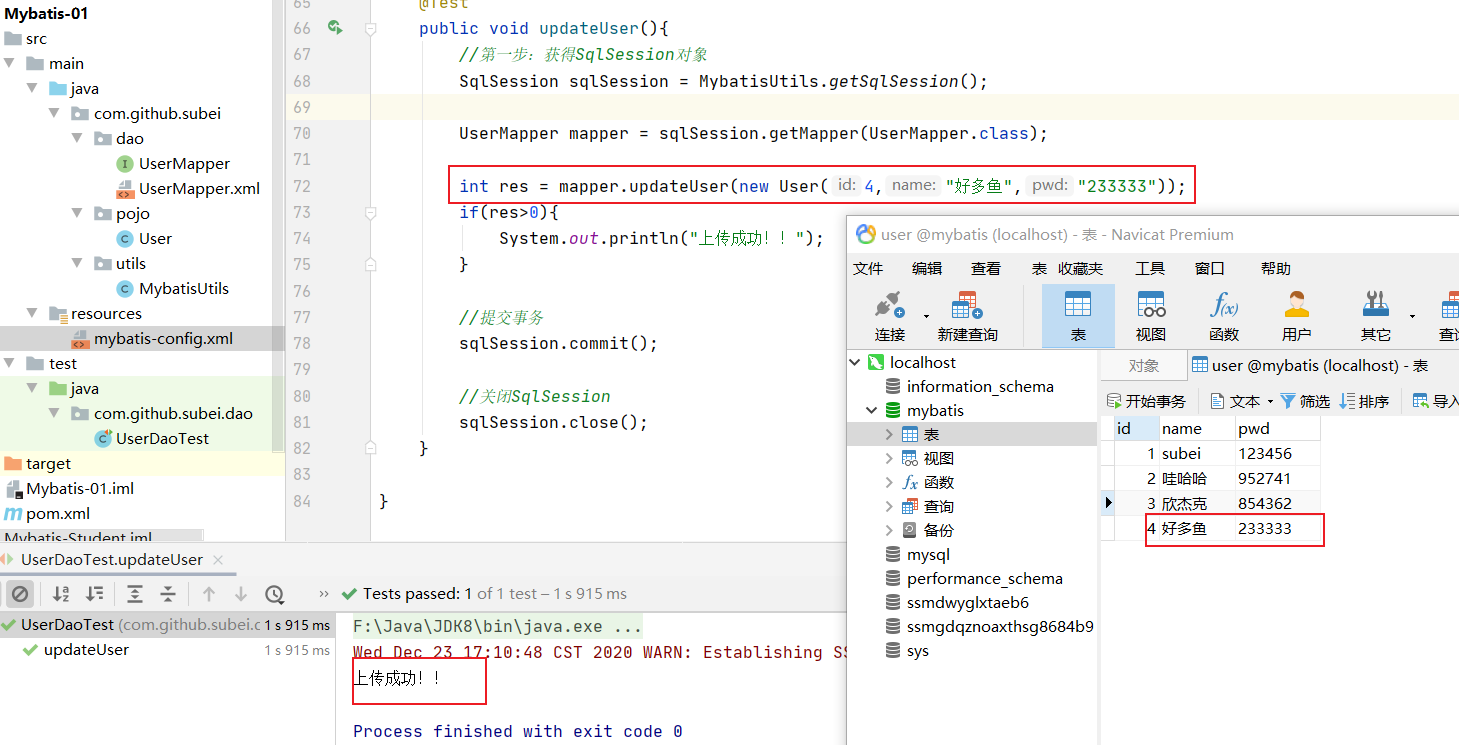
5、Delete
// // 增删改需要提交事务,删除用户
int deleteUser(int id);
<delete id="deleteUser" parameterType="int">
delete from mybatis.user where id = #{id};
</delete>
@Test
public void deleteUser(){
//第一步:获得SqlSession对象
SqlSession sqlSession = MybatisUtils.getSqlSession();
UserMapper mapper = sqlSession.getMapper(UserMapper.class);
int res = mapper.deleteUser(4);
if(res>0){
System.out.println("删除成功!!");
}
//提交事务
sqlSession.commit();
//关闭SqlSession
sqlSession.close();
}

注意点:
- 增删改需要提交事务!(重要)
6、分析错误(未看)
- 标签不要匹配错
- resource 绑定mapper,需要使用路径!
- 程序配置文件必须符合规范!
- NullPointerException,没有注册到资源!
- 输出的xml文件中存在中文乱码问题!
- maven资源没有导出问题!
7、万能Map
假设,我们的实体类,或者数据库中的表,字段或者参数过多,我们应当考虑使用Map!
// 万能的Map,键值对;
int addUser2(Map<String,Object> map);
<!-- 对象中的属性,可以直接取出来传递map的key ,相比之前去掉了resultType属性-->
<insert id="addUser2" parameterType="map">
insert into mybatis.user (id, pwd) values (#{userid},#{passWord});
</insert>
@Test
public void addUser2(){
//第一步:获得SqlSession对象
SqlSession sqlSession = MybatisUtils.getSqlSession();
UserMapper mapper = sqlSession.getMapper(UserMapper.class);
Map<String, Object> map = new HashMap<String, Object>();
map.put("userid",5); //相比不同map.put("userName",""Hello"");
map.put("passWord","2222333");
mapper.addUser2(map);
//生效需提交事务
//sqlSession.commit();
//关闭SqlSession
sqlSession.close();
}

- Map传递参数,直接在sql中取出key即可! 【parameterType="map"】
- 对象传递参数,直接在sql中取对象的属性即可!【parameterType="Object"】
- 只有一个基本类型参数的情况下,可以直接在sql中取到!
- 多个参数用Map,或者注解!
8、思考题: 模糊查询
模糊查询怎么写?这是两种方式:
-
Java代码执行的时候,传递通配符 % %
List
userList = mapper.getUserLike("%欣%"); List<User> getUserLike(String value); <select id="getUserLike" resultType="com.github.subei.pojo.User"> select * from mybatis.user where name like #{value }; </select> @Test public void getUserLike(){ //第一步:获得SqlSession对象 SqlSession sqlSession = MybatisUtils.getSqlSession(); UserMapper mapper = sqlSession.getMapper(UserMapper.class); List<User> userList = mapper.getUserLike("%欣%"); for (User user:userList){ System.out.println(user); } //关闭SqlSession sqlSession.close(); }

-
在sql拼接中使用通配符!
select * from mybatis.user where name like "%"#{value}"%"
4、配置解析
详细文档:https://mybatis.org/mybatis-3/zh/configuration.html
1、核心配置文件
-
mybatis-config.xml(详细看官方文档)
-
MyBatis 的配置文件包含了会深深影响 MyBatis 行为的设置和属性信息。
configuration(配置) properties(属性) --重要 settings(设置)--重要 typeAliases(类型别名)--重要 typeHandlers(类型处理器) objectFactory(对象工厂) plugins(插件) environments(环境配置)--重要 environment(环境变量)--重要 transactionManager(事务管理器)--重要 dataSource(数据源) --重要 databaseIdProvider(数据库厂商标识) mappers(映射器)
2、环境配置(environments)
-
MyBatis 可以配置成适应多种环境;
-
不过要记住:尽管可以配置多个环境,但每个 SqlSessionFactory 实例只能选择一种环境。
-
学会使用配置多套运行环境!
-
Mybatis默认的事务管理器就是 JDBC , 连接池 : POOLED。
3、属性(properties)
我们可以通过properties属性来实现引用配置文件
- 这些属性都是可外部配置且可动态替换的,既可以在典型的 Java 属性文件中配置,亦可通过 properties 元素的子元素来传递。【db.properties】

- 编写一个配置文件,db.properties
driver=com.mysql.jdbc.Driver
url=jdbc:mysql://localhost:3306/mybatis?useSSL=true&serverTimezone=UTC&useUnicode=true&characterEncoding=utf8
username=root
password=root
- 在核心配置文件中映入
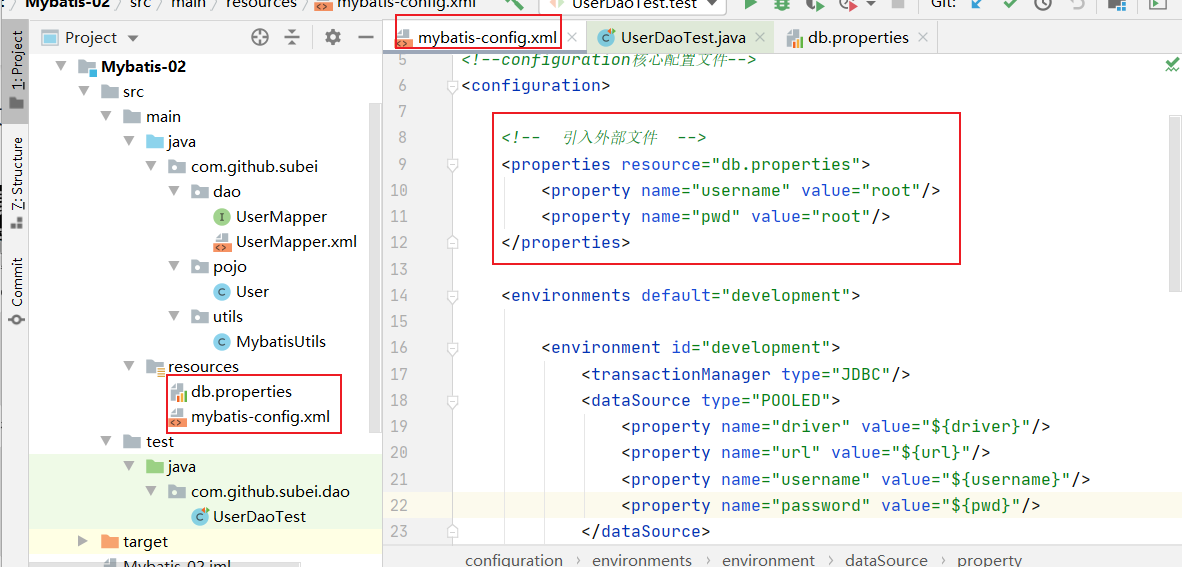
<?xml version="1.0" encoding="UTF-8" ?>
<!DOCTYPE configuration
PUBLIC "-//mybatis.org//DTD Config 3.0//EN"
"http://mybatis.org/dtd/mybatis-3-config.dtd">
<!--configuration核心配置文件-->
<configuration>
<!-- 引入外部文件 -->
<properties resource="db.properties">
<property name="username" value="root"/>
<property name="pwd" value="root"/>
</properties>
<environments default="development">
<environment id="development">
<transactionManager type="JDBC"/>
<dataSource type="POOLED">
<property name="driver" value="${driver}"/>
<property name="url" value="${url}"/>
<property name="username" value="${username}"/>
<property name="password" value="${pwd}"/>
</dataSource>
</environment>
</environments>
<!-- 每一个Mapper.xml都需要在mybatis核心配置文件中注册! -->
<mappers>
<mapper resource="com/github/subei/dao/UserMapper.xml"/>
</mappers>
</configuration>
- 可以直接引入外部文件;
- 可以在其中增加一些属性配置;
- 如果两个文件有同一个字段,优先使用外部配置文件的!
4、类型别名(typeAliases)
配置之别名优化
- 类型别名是为 Java 类型设置一个短的名字。
- 存在的意义仅在于用来减少类完全限定名的冗余。
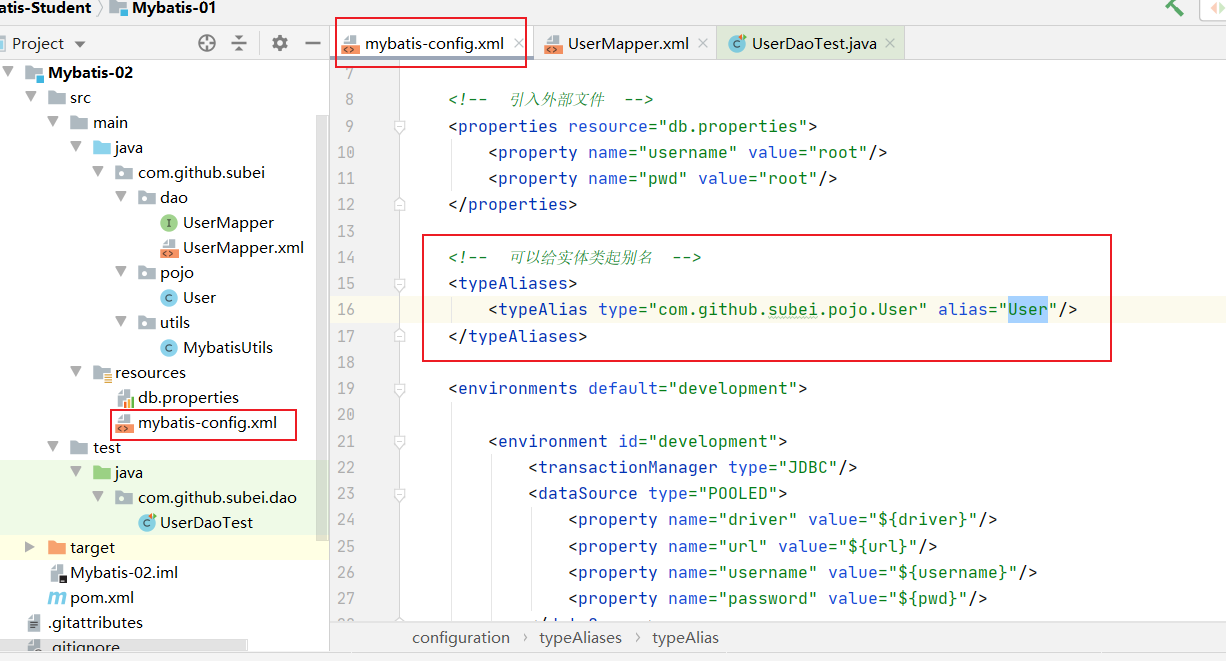
<!-- 可以给实体类起别名 -->
<typeAliases>
<typeAlias type="com.github.subei.pojo.User" alias="User"/>
</typeAliases>
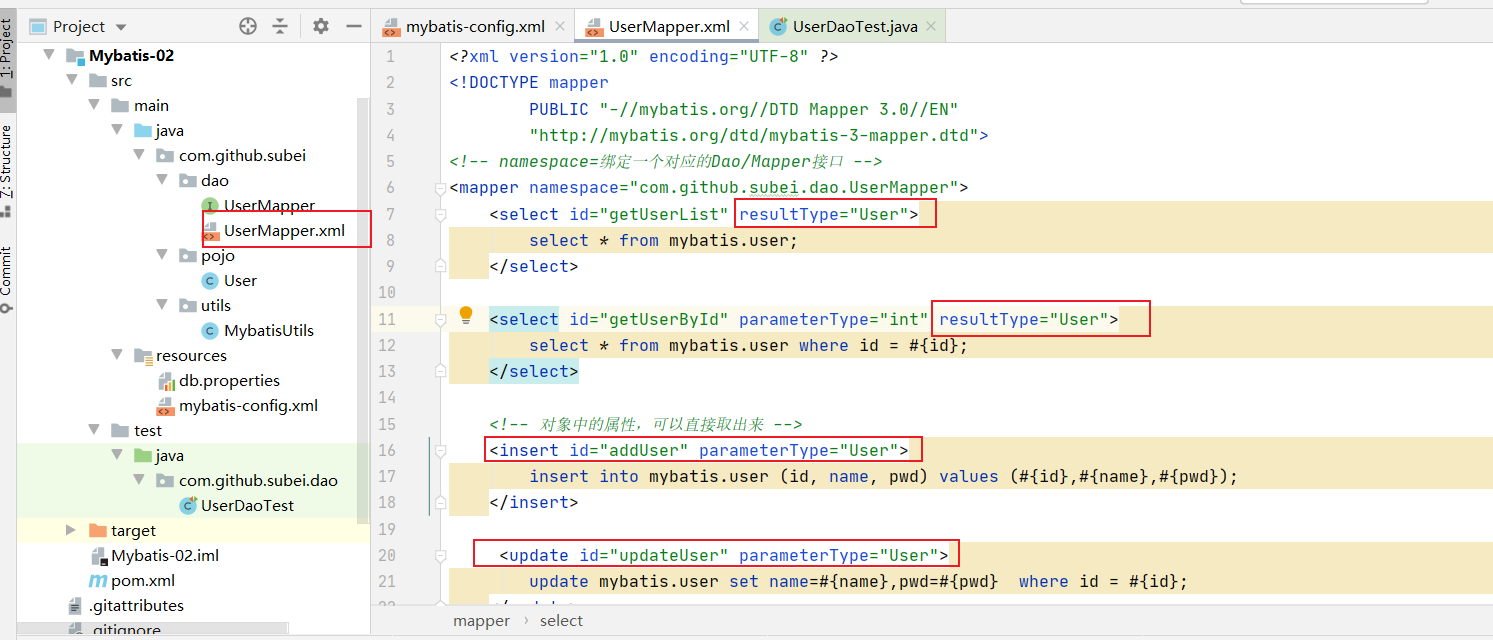

-
也可以指定一个包名,MyBatis 会在包名下面搜索需要的 Java Bean,比如:
-
扫描实体类的包,它的默认别名就为这个类的 类名,首字母小写!
<!-- 可以给实体类起别名 -->
<typeAliases>
<package name="com.github.subei.pojo"/>
</typeAliases>

在实体类比较少的时候,使用第一种方式。
如果实体类十分多,建议使用第二种。
第一种可以DIY别名,第二种则
不行,如果非要改,需要在实体上增加注解。
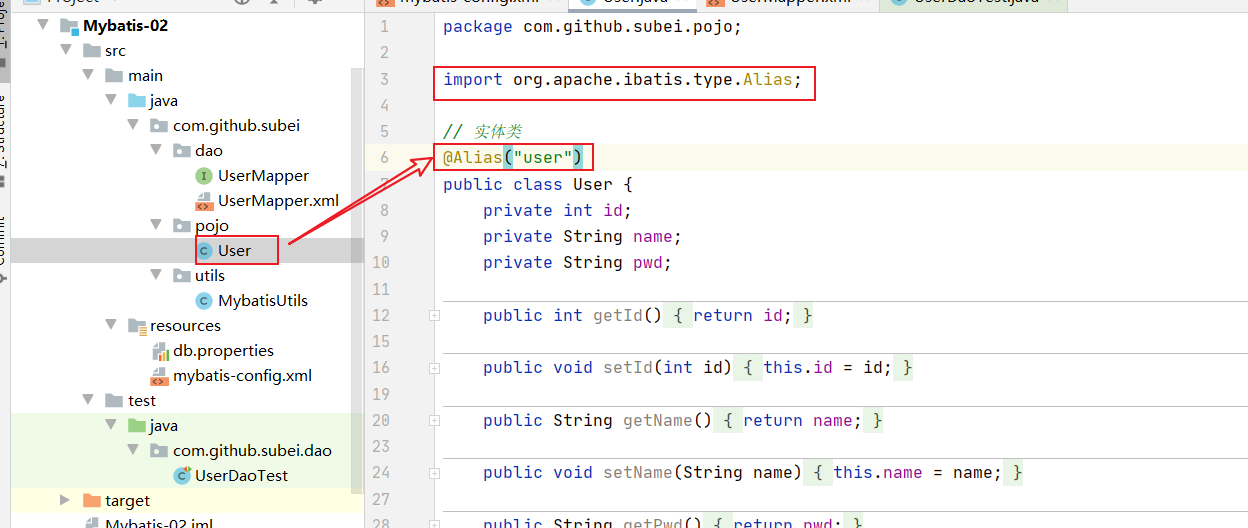
@Alias("user")
public class User {}
5、设置
这是 MyBatis 中极为重要的调整设置,它们会改变 MyBatis 的运行时行为。


开启缓存和懒加载(重要。一个是加入缓存,一个是效率提高。)
6、其他配置
- typeHandlers(类型处理器)
- objectFactory(对象工厂)
- plugins插件
- mybatis-generator-core
- mybatis-plus
- 通用mapper
7、映射器(mappers)
MapperRegistry:注册绑定我们的Mapper文件;
- 方式一: 【推荐使用】
<!-- 每一个Mapper.xml都需要在mybatis核心配置文件中注册! -->
<mappers>
<mapper resource="com/github/subei/dao/UserMapper.xml"/>
</mappers>
- 方式二:使用class文件绑定注册
<!-- 每一个Mapper.xml都需要在mybatis核心配置文件中注册! -->
<mappers>
<mapper class="com.github.subei.dao.UserMapper"/>
</mappers>
注意点:
- 接口和他的Mapper配置文件必须同名!
- 接口和他的Mapper配置文件必须在同一个包下!
- 方式三:使用扫描包进行注入绑定
<!--每一个Mapper.XML都需要在Mybatis核心配置文件中注册!-->
<mappers>
<package name="com.github.subei.dao"/>
</mappers>
注意点:
- 接口和他的Mapper配置文件必须同名!
- 接口和他的Mapper配置文件必须在同一个包下!
练习时间:
- 将数据库配置文件外部引入;
- 实体类别名;
- 保证UserMapper 接口 和 UserMapper .xml 改为一致!并且放在同一个包下!
8、生命周期和作用域
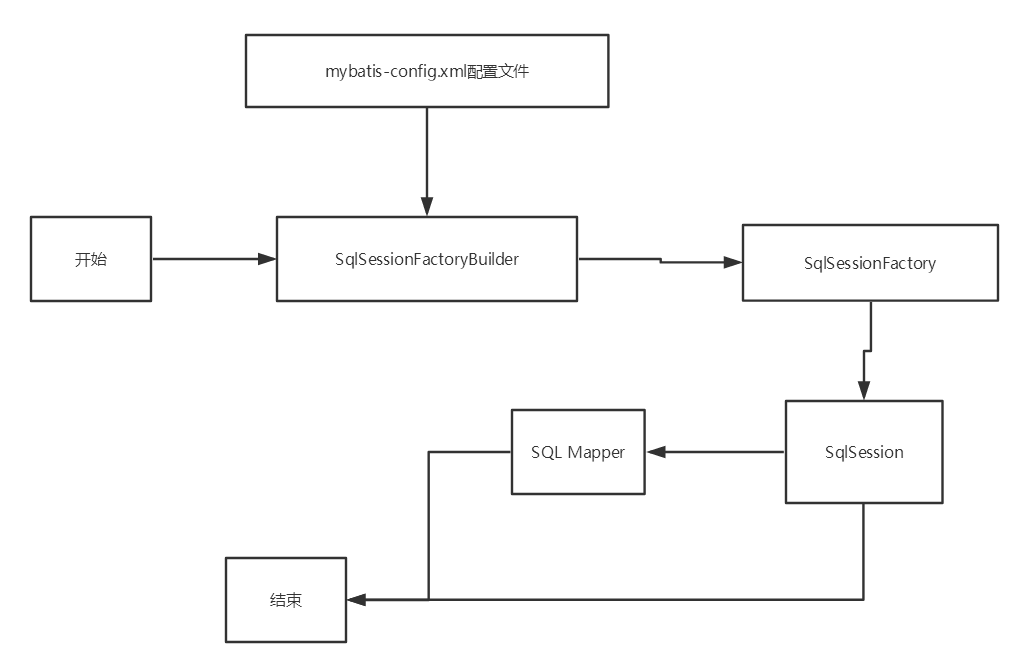
生命周期,和作用域,是至关重要的,因为错误的使用会导致非常严重的并发问题。
SqlSessionFactoryBuilder:
- 一旦创建了 SqlSessionFactory,就不再需要它了。
- 局部变量。
SqlSessionFactory:
- 说白了就是可以想象为 :数据库连接池;
- SqlSessionFactory 一旦被创建就应该在应用的运行期间一直存在,没有任何理由丢弃它或重新创建另一个实例。
- 因此 SqlSessionFactory 的最佳作用域是应用作用域。
- 最简单的就是使用单例模式或者静态单例模式。
SqlSession
- 连接到连接池的一个请求!
- SqlSession 的实例不是线程安全的,因此是不能被共享的,所以它的最佳的作用域是请求或方法作用域。
- 用完之后需要赶紧关闭,否则资源被占用!
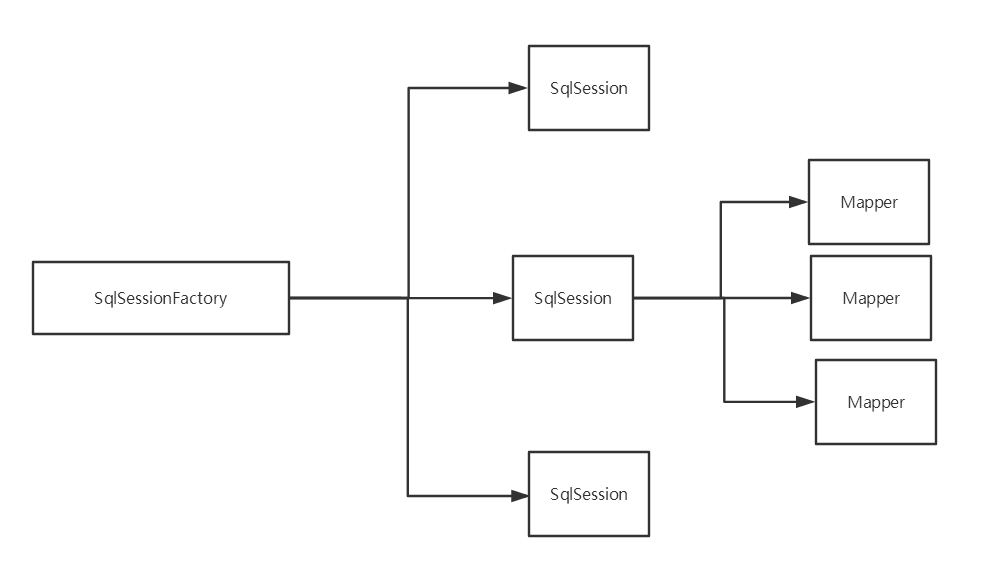
这里面的每一个Mapper,就代表一个具体的业务!
5、解决属性名和字段名不一致的问题
1、 问题
- 数据库中的字段
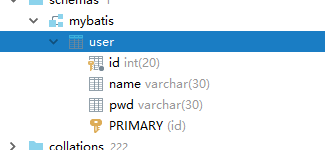
- 新建一个项目,拷贝之前的,测试实体类字段不一致的情况:
package com.github.subei.pojo;
// 实体类
public class User {
private int id;
private String name;
private String password;
public User() {
}
public int getId() {
return id;
}
public void setId(int id) {
this.id = id;
}
public String getName() {
return name;
}
public void setName(String name) {
this.name = name;
}
public String getPassword() {
return password;
}
public void setPassword(String password) {
this.password = password;
}
public User(int id, String name, String password) {
this.id = id;
this.name = name;
this.password = password;
}
@Override
public String toString() {
return "User{" +
"id=" + id +
", name='" + name + '\'' +
", password='" + password + '\'' +
'}';
}
}
- 测试出现问题:

// select * from mybatis.user where id = #{id}
// 类型处理器
// select id,name,pwd from mybatis.user where id = #{id}
解决方法:
-
第一种方法、起别名
<select id="getUserById" resultType="com.kuang.pojo.User"> select id,name,pwd as password from mybatis.user where id = #{id} </select>
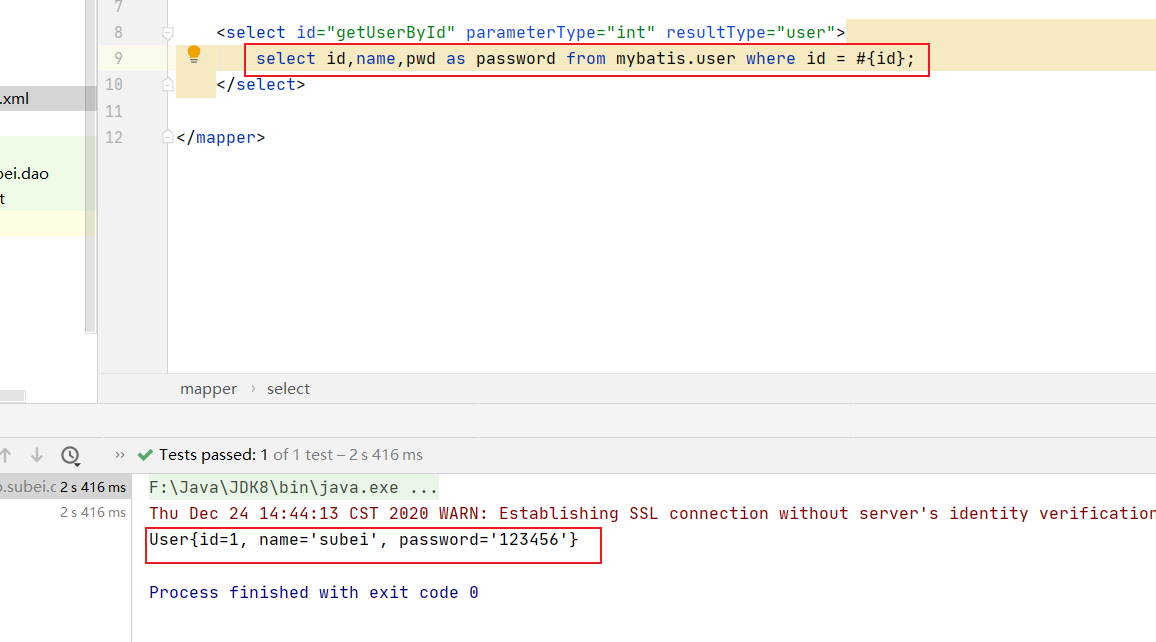
2、resultMap
对于上述问题,第二种方法、ResultMap结果集映射(出现错误)
- 结果集映射:
id name pwd
id name password
<!-- 结果集映射 -->
<resultMap id="userMap" type="User">
<!-- column数据库中的字段,property实体类中的属性 -->
<result column="id" property="id"/>
<result column="name" property="name"/>
<result column="pwd" property="password"/>
</resultMap>
<select id="getUserById" parameterType="int" resultMap="userMap">
select id,name,pwd from mybatis.user where id = #{id};
</select>

resultMap元素是 MyBatis 中最重要最强大的元素。- ResultMap 的设计思想是,
对于简单的语句根本不需要配置显式的结果映射,而对于复杂一点的语句只需要描述它们的关系就行了。 ResultMap最优秀的地方在于,虽然你已经对它相当了解了,但是根本就不需要显式地用到他们。
6、日志
6.1、日志工厂
如果一个数据库操作,出现了异常,我们需要排错。日志就是最好的助手!
-
曾经:sout 、debug
-
现在:日志工厂!(logImpl)

-
SLF4J
-
LOG4J 【掌握】
-
LOG4J2
-
JDK_LOGGING
-
COMMONS_LOGGING
-
STDOUT_LOGGING 【掌握】
-
NO_LOGGING
-
在Mybatis中具体使用那个一日志实现,在设置中设定!
-
STDOUT_LOGGING标准日志输出!(标准的工厂日志)
-
在mybatis核心配置文件中,配置我们的日志!
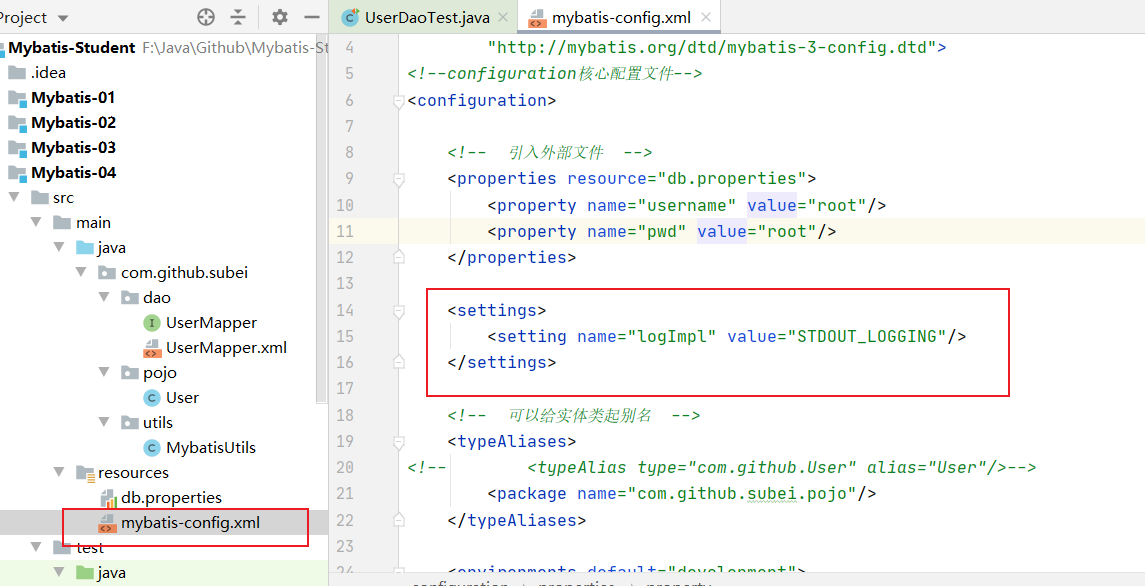
<settings>
<setting name="logImpl" value="STDOUT_LOGGING"/>
</settings>

6.2、Log4j
什么是Log4j?
- Log4j是Apache的一个开源项目,通过使用Log4j,我们可以控制日志信息输送的目的地是控制台、文件、GUI组件
- 我们也可以控制每一条日志的输出格式;
- 通过定义每一条日志信息的级别,我们能够更加细致地控制日志的生成过程。
- 通过一个配置文件来灵活地进行配置,而不需要修改应用的代码。
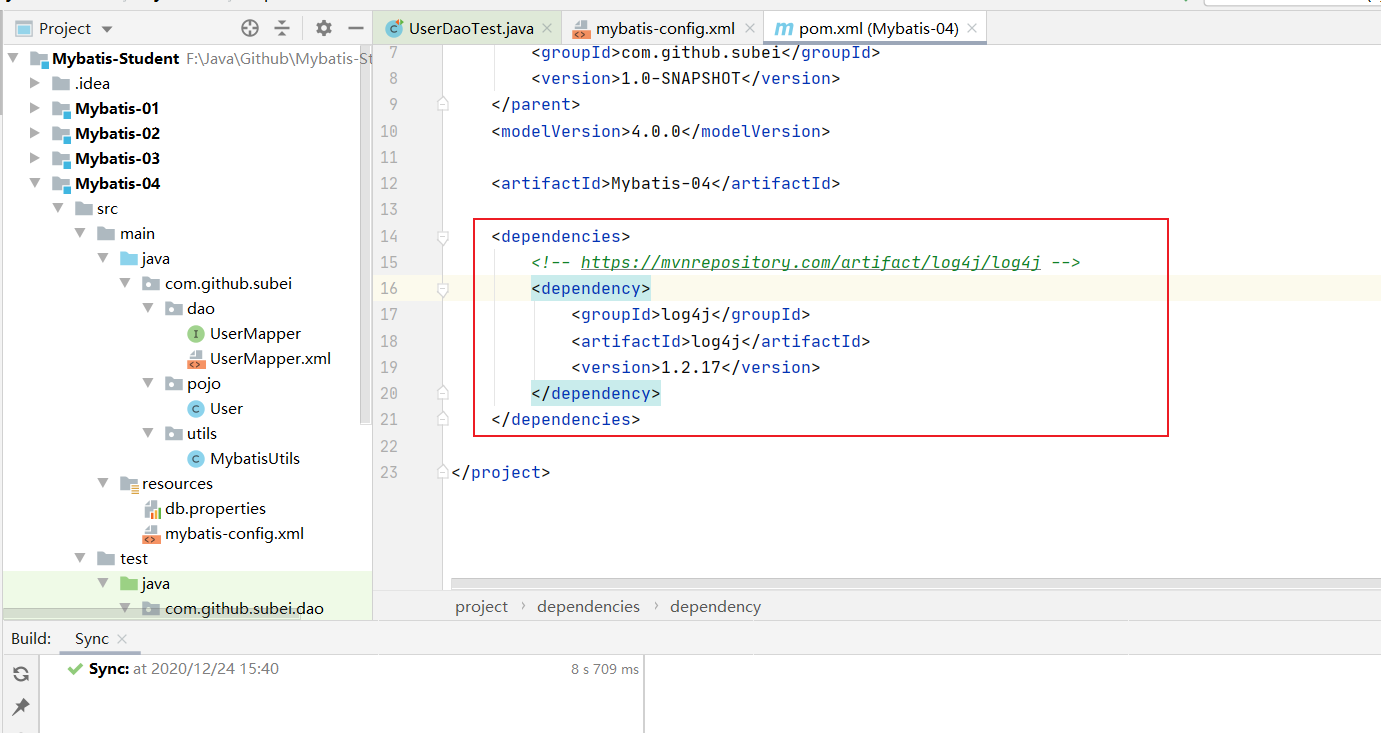
-
先导入log4j的包
<dependencies> <!-- https://mvnrepository.com/artifact/log4j/log4j --> <dependency> <groupId>log4j</groupId> <artifactId>log4j</artifactId> <version>1.2.17</version> </dependency> </dependencies> -
log4j.properties
#将等级为DEBUG的日志信息输出到console和file这两个目的地,console和file的定义在下面的代码 log4j.rootLogger=DEBUG,console,file #控制台输出的相关设置 log4j.appender.console = org.apache.log4j.ConsoleAppender log4j.appender.console.Target = System.out log4j.appender.console.Threshold=DEBUG log4j.appender.console.layout = org.apache.log4j.PatternLayout log4j.appender.console.layout.ConversionPattern=[%c]-%m%n #文件输出的相关设置 log4j.appender.file = org.apache.log4j.RollingFileAppender log4j.appender.file.File=./log/github.log log4j.appender.file.MaxFileSize=10mb log4j.appender.file.Threshold=DEBUG log4j.appender.file.layout=org.apache.log4j.PatternLayout log4j.appender.file.layout.ConversionPattern=[%p][%d{yy-MM-dd}][%c]%m%n #日志输出级别 log4j.logger.org.mybatis=DEBUG log4j.logger.java.sql=DEBUG log4j.logger.java.sql.Statement=DEBUG log4j.logger.java.sql.ResultSet=DEBUG log4j.logger.java.sql.PreparedStatement=DEBUG -
配置log4j为日志的实现(修改于mybatis-config.xml)
<settings> <setting name="logImpl" value=""/> </settings> <!-- 例如: --> <settings> <setting name="logImpl" value="LOG4J"/> </settings> -
Log4j的使用!,直接测试运行刚才的查询
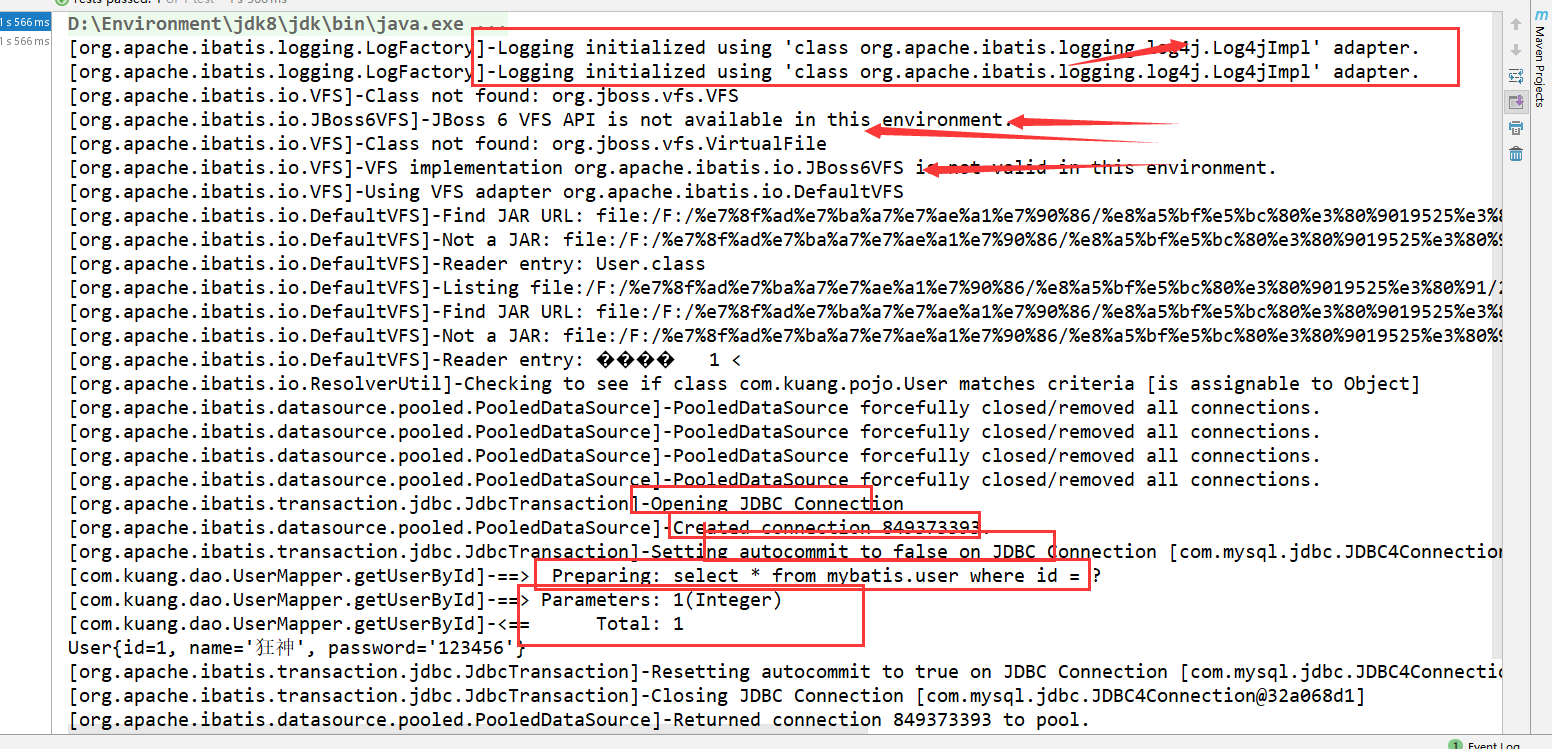
简单使用
-
在要使用Log4j 的类中,导入包 import org.apache.log4j.Logger;
-
日志对象,参数为当前类的class;
static Logger logger = Logger.getLogger(UserDaoTest.class); -
日志级别;
@Test public void testLog4j(){ logger.info("info:进入了testLog4j"); logger.debug("debug:进入了testLog4j"); logger.error("error:进入了testLog4j"); }

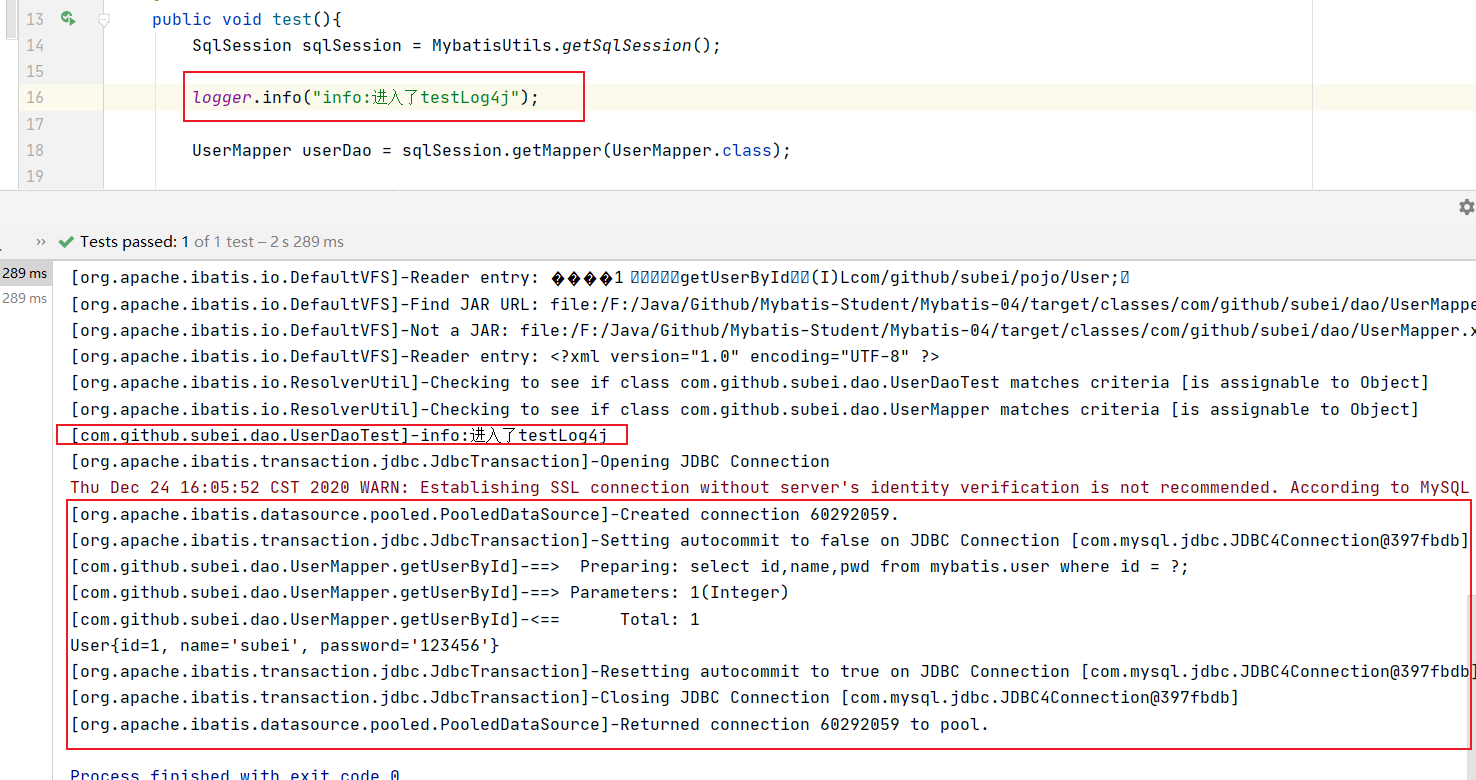
7、分页
思考:为什么要分页?
- 减少数据的处理量。
7.1、使用Limit分页
语法: SELECT * from user limit startIndex,pageSize;
SELECT * from user limit 3; #[0,n]
使用Mybatis实现分页,核心SQL。
-
接口;
// 分页 List<User> getUserByLimit(Map<String,Integer> map); -
Mapper.xml;
<!-- 分页 --> <select id="getUserByLimit" parameterType="map" resultMap="userMap"> select * from mybatis.user limit #{startIndex},#{pageSize} </select> -
测试;
@Test public void getUserByLimit(){ SqlSession sqlSession = MybatisUtils.getSqlSession(); UserMapper mapper = sqlSession.getMapper(UserMapper.class); HashMap<String, Integer> map = new HashMap<String, Integer>(); map.put("startIndex",1); map.put("pageSize",2); List<User> userList = mapper.getUserByLimit(map); for (User user : userList) { System.out.println(user); } sqlSession.close(); }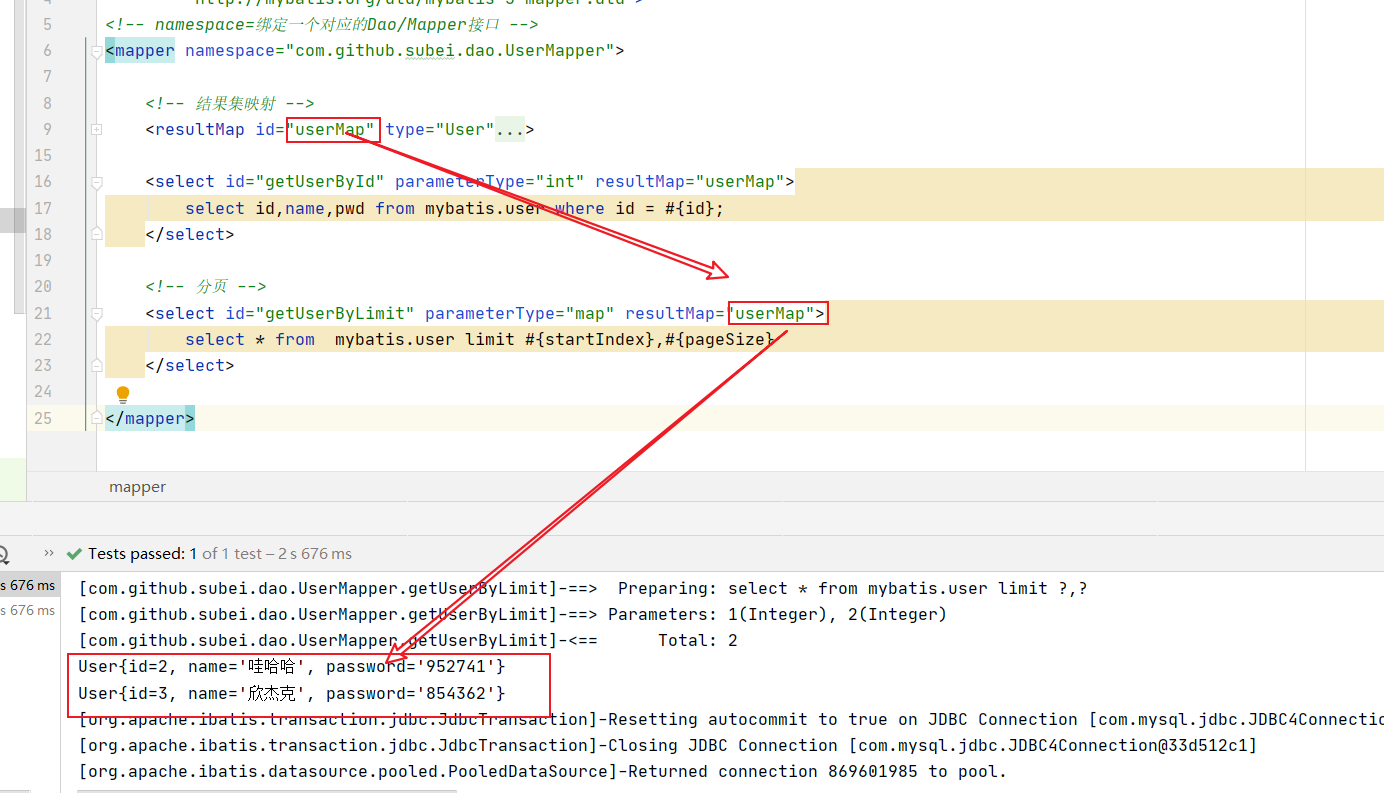
7.2、RowBounds分页
不再使用SQL实现分页。
-
接口;
// 分页2 List<User> getUserByRowBounds(); -
mapper.xml;
<!-- 分页2 --> <select id="getUserByRowBounds" resultMap="userMap"> select * from mybatis.user </select> -
测试;
@Test public void getUserByRowBounds(){ SqlSession sqlSession = MybatisUtils.getSqlSession(); // RowBounds实现 RowBounds rowBounds = new RowBounds(1, 2); // 通过Java代码层面实现分页 List<User> userList = sqlSession.selectList("com.github.subei.dao.UserMapper.getUserByRowBounds",null,rowBounds); for (User user : userList) { System.out.println(user); } sqlSession.close(); }
7.3、分页插件
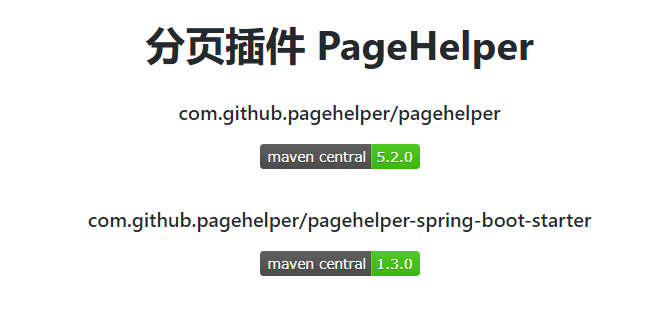
了解即可,万一以后公司的架构师,说要使用,你需要知道它是什么东西!
关于IDEA自动重置LanguageLevel和JavaCompiler版本的问题
- 使用IDEA时,导入的Maven项目默认的LanguageLevel和JavaCompiler都是1.5,1.5的情况下连最简单的@Override注解都不支持,所以项目可能出现一堆错。

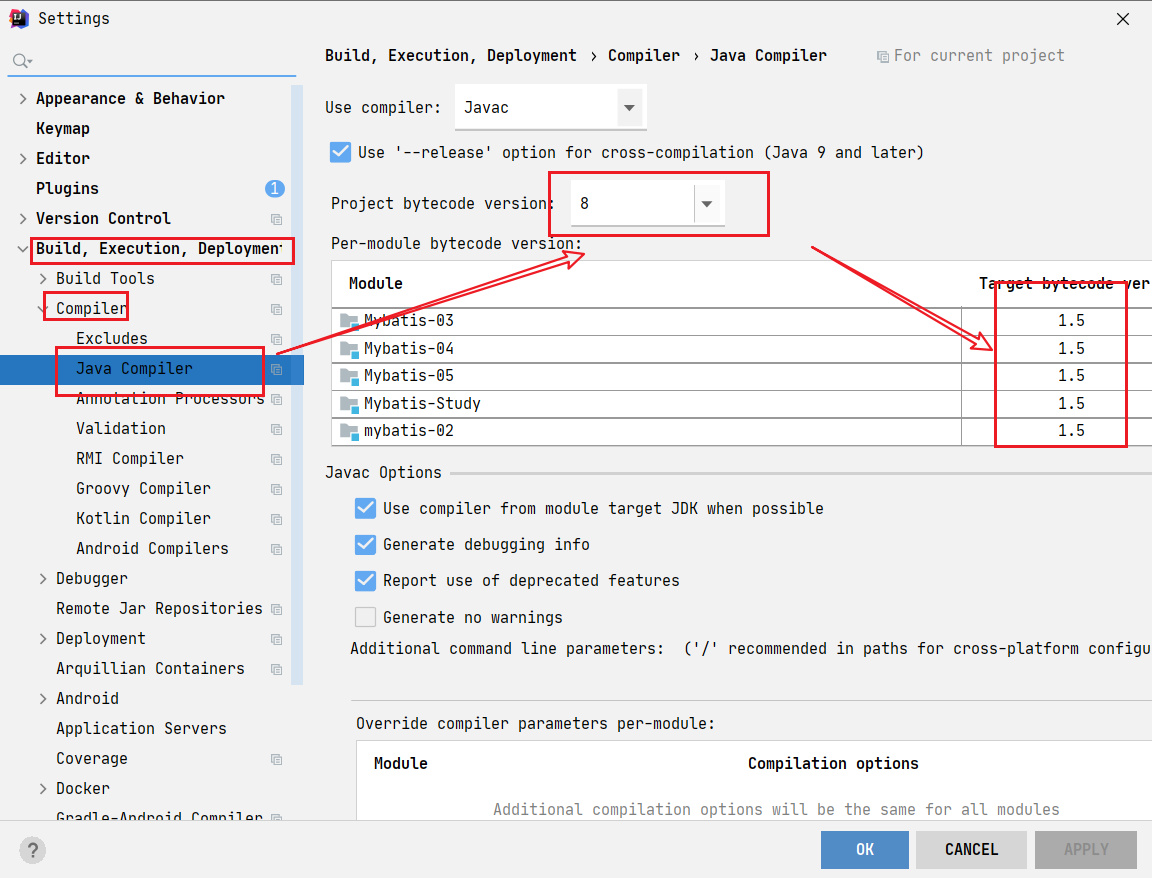
- 如果遇到这类问题,手动次次修改会很麻烦;只需在
最外层的pom.xml文件中加入如下:
<build>
<plugins>
<plugin>
<groupId>org.apache.maven.plugins</groupId>
<artifactId>maven-compiler-plugin</artifactId>
<version>2.3.2</version>
<configuration>
<source>1.8</source>
<target>1.8</target>
</configuration>
</plugin>
</plugins>
</build>
8、使用注解开发
8.1、面向接口编程
大家之前都学过面向对象编程,也学习过接口,但在真正的开发中,很多时候我们会选择面向接口编程。
- 根本原因 : 解耦 , 可拓展 , 提高复用 , 分层开发中 , 上层不用管具体的实现 , 大家都遵守共同的标准 , 使得开发变得容易 , 规范性更好
- 在一个面向对象的系统中,系统的各种功能是由许许多多的不同对象协作完成的。在这种情况下,各个对象内部是如何实现自己的,对系统设计人员来讲就不那么重要了;
- 而各个对象之间的协作关系则成为系统设计的关键。小到不同类之间的通信,大到各模块之间的交互,在系统设计之初都是要着重考虑的,这也是系统设计的主要工作内容。面向接口编程就是指按照这种思想来编程。
关于接口的理解
- 接口从更深层次的理解,应是定义(规范,约束)与实现(名实分离的原则)的分离。
- 接口的本身反映了系统设计人员对系统的抽象理解。
- 接口应有两类:
- 第一类是对一个个体的抽象,它可对应为一个抽象体(abstract class);
- 第二类是对一个个体某一方面的抽象,即形成一个抽象面(interface);
- 一个体有可能有多个抽象面。抽象体与抽象面是有区别的。
三个面向区别:
- 面向对象是指,我们考虑问题时,以对象为单位,考虑它的属性及方法。
- 面向过程是指,我们考虑问题时,以一个具体的流程(事务过程)为单位,考虑它的实现。
- 接口设计与非接口设计是针对复用技术而言的,与面向对象(过程)不是一个问题.更多的体现就是对系统整体的架构。
8.2、使用注解开发
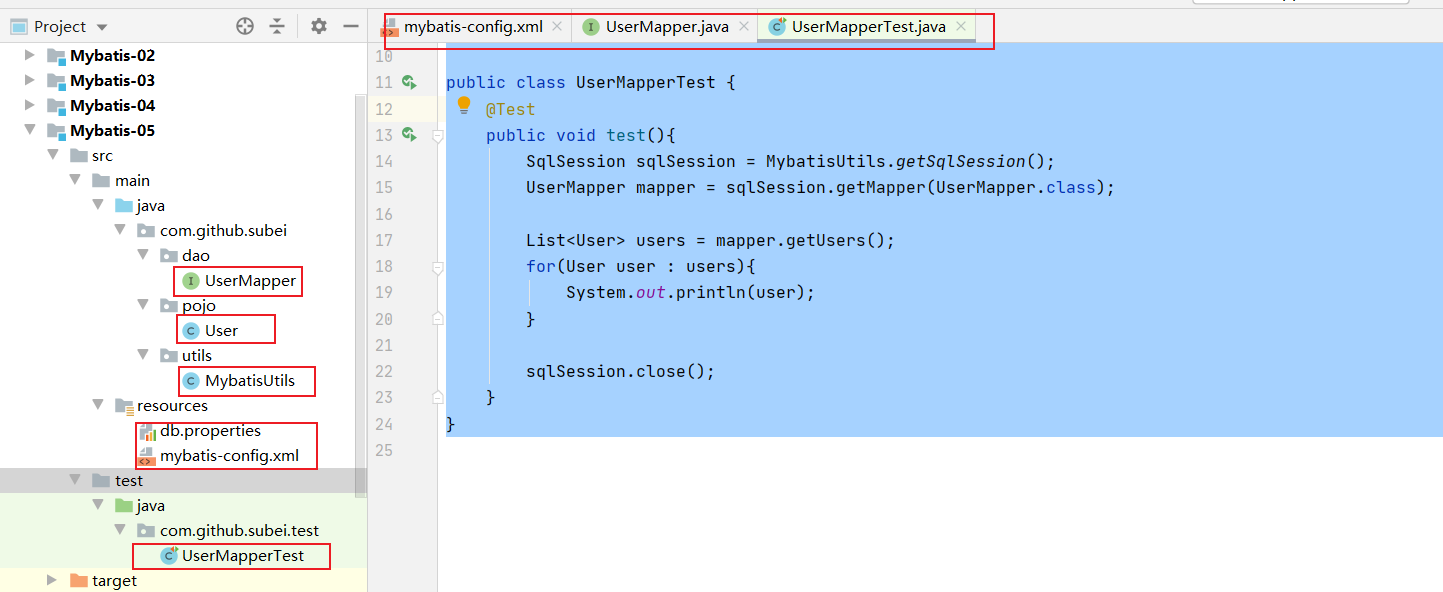
-
注解在接口上实现;
UserMapper.javapackage com.github.subei.dao; import com.github.pojo.User; import org.apache.ibatis.annotations.Select; import java.util.List; public interface UserMapper { @Select("select * from user") List<User> getUsers(); } -
需要在核心配置文件中绑定接口!
mybatis-config.xml<?xml version="1.0" encoding="UTF-8" ?> <!DOCTYPE configuration PUBLIC "-//mybatis.org//DTD Config 3.0//EN" "http://mybatis.org/dtd/mybatis-3-config.dtd"> <configuration> <properties resource="db.properties"> <property name="username" value="root"/> <property name="password" value="root"/> </properties> <settings> <setting name="logImpl" value="STDOUT_LOGGING"/> </settings> <typeAliases> <package name="com.github.subei.pojo"/> </typeAliases> <environments default="development"> <environment id="development"> <transactionManager type="JDBC"/> <dataSource type="POOLED"> <property name="driver" value="${driver}"/> <property name="url" value="${url}"/> <property name="username" value="${username}"/> <property name="password" value="${password}"/> </dataSource> </environment> </environments> <!--绑定接口--> <mappers> <mapper class="com.github.subei.dao.UserMapper"/> </mappers> </configuration> -
测试
package com.github.subei.test;
import com.github.subei.dao.UserMapper;
import com.github.subei.pojo.User;
import com.github.subei.utils.MybatisUtils;
import org.apache.ibatis.session.SqlSession;
import org.junit.Test;
import java.util.List;
public class UserMapperTest {
@Test
public void test(){
SqlSession sqlSession = MybatisUtils.getSqlSession();
UserMapper mapper = sqlSession.getMapper(UserMapper.class);
List<User> users = mapper.getUsers();
for(User user : users){
System.out.println(user);
}
sqlSession.close();
}
}

-
本质:反射机制实现
-
底层:动态代理!
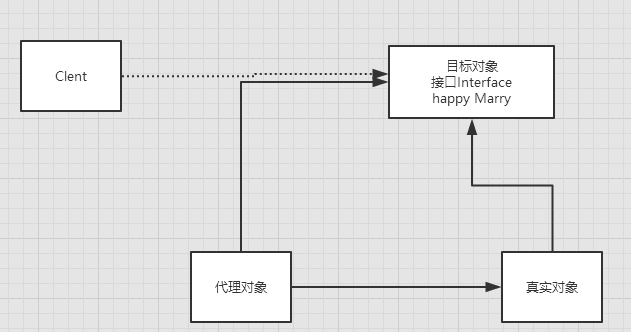
Mybatis详细的执行流程!
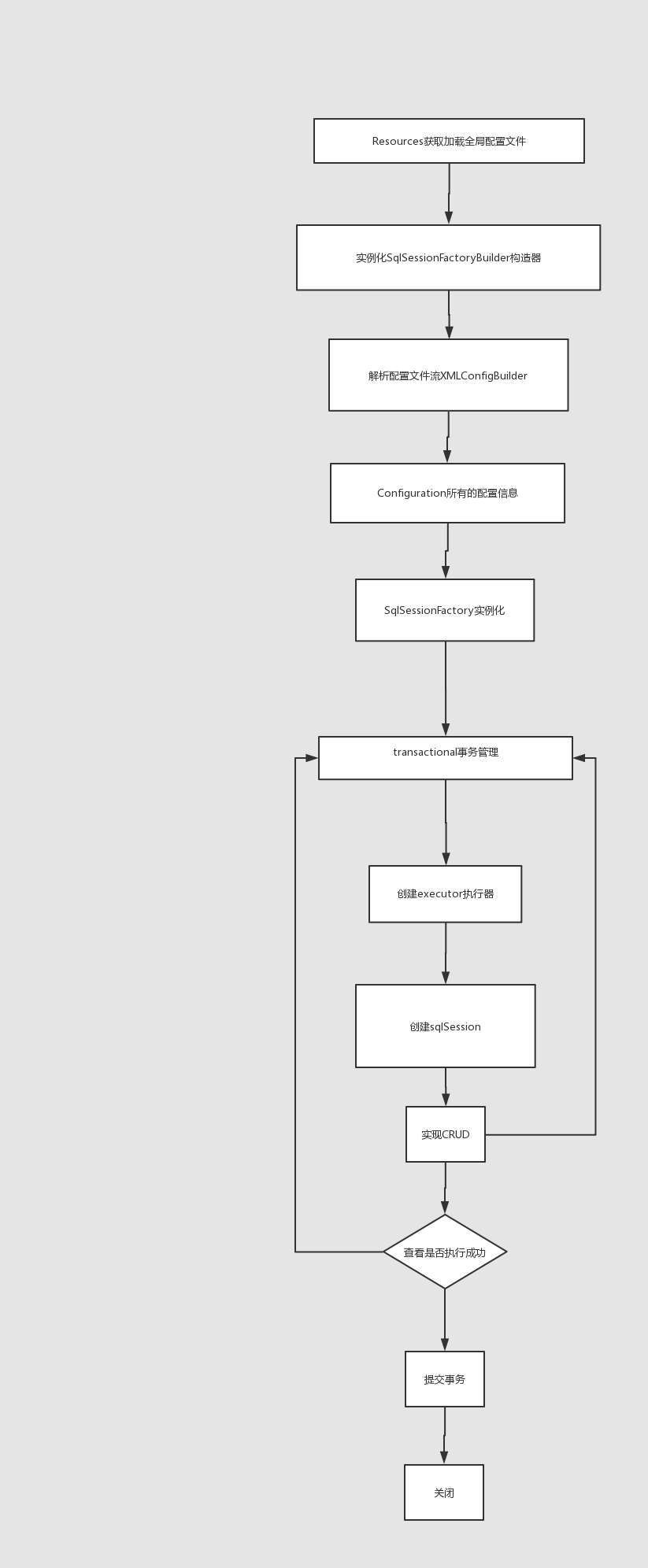
8.3、CRUD
- 我们可以在工具类创建的时候实现自动提交事务!

public static SqlSession getSqlSession(){
return sqlSessionFactory.openSession(true);
}
- 编写接口,增加注解。
package com.github.subei.dao;
import com.github.subei.pojo.User;
import org.apache.ibatis.annotations.*;
import java.util.List;
import java.util.Map;
public interface UserMapper {
@Select("select * from user")
List<User> getUsers();
// 方法存在多个参数,所有的参数前面必须加上 @Param("id")注解
@Select("select * from user where id = #{id}")
User getUserByID(@Param("id") int id);
@Insert("insert into user(id,name,pwd) values (#{id},#{name},#{password})")
int addUser(User user);
@Update("update user set name=#{name},pwd=#{password} where id = #{id}")
int updateUser(User user);
@Delete("delete from user where id = #{uid}")
int deleteUser(@Param("uid") int id);
}
- 测试类,【注意:必须要将接口注册绑定到核心配置文件中!】
package com.github.subei.test;
import com.github.subei.dao.UserMapper;
import com.github.subei.pojo.User;
import com.github.subei.utils.MybatisUtils;
import org.apache.ibatis.session.SqlSession;
import org.junit.Test;
import java.util.List;
public class UserMapperTest {
@Test
public void test(){
SqlSession sqlSession = MybatisUtils.getSqlSession();
// 底层主要应用反射
UserMapper mapper = sqlSession.getMapper(UserMapper.class);
mapper.addUser(new User(5,"hello","123456"));
sqlSession.close();
}
}
/*
List<User> users = mapper.getUsers();
for(User user : users){
System.out.println(user);
}
User userByID = mapper.getUserByID(1);
System.out.println(userByID);
mapper.addUser(new User(5,"hello","123456"));
mapper.updateUser(new User(5,"to","213213"));
mapper.deleteUser(5);
*/
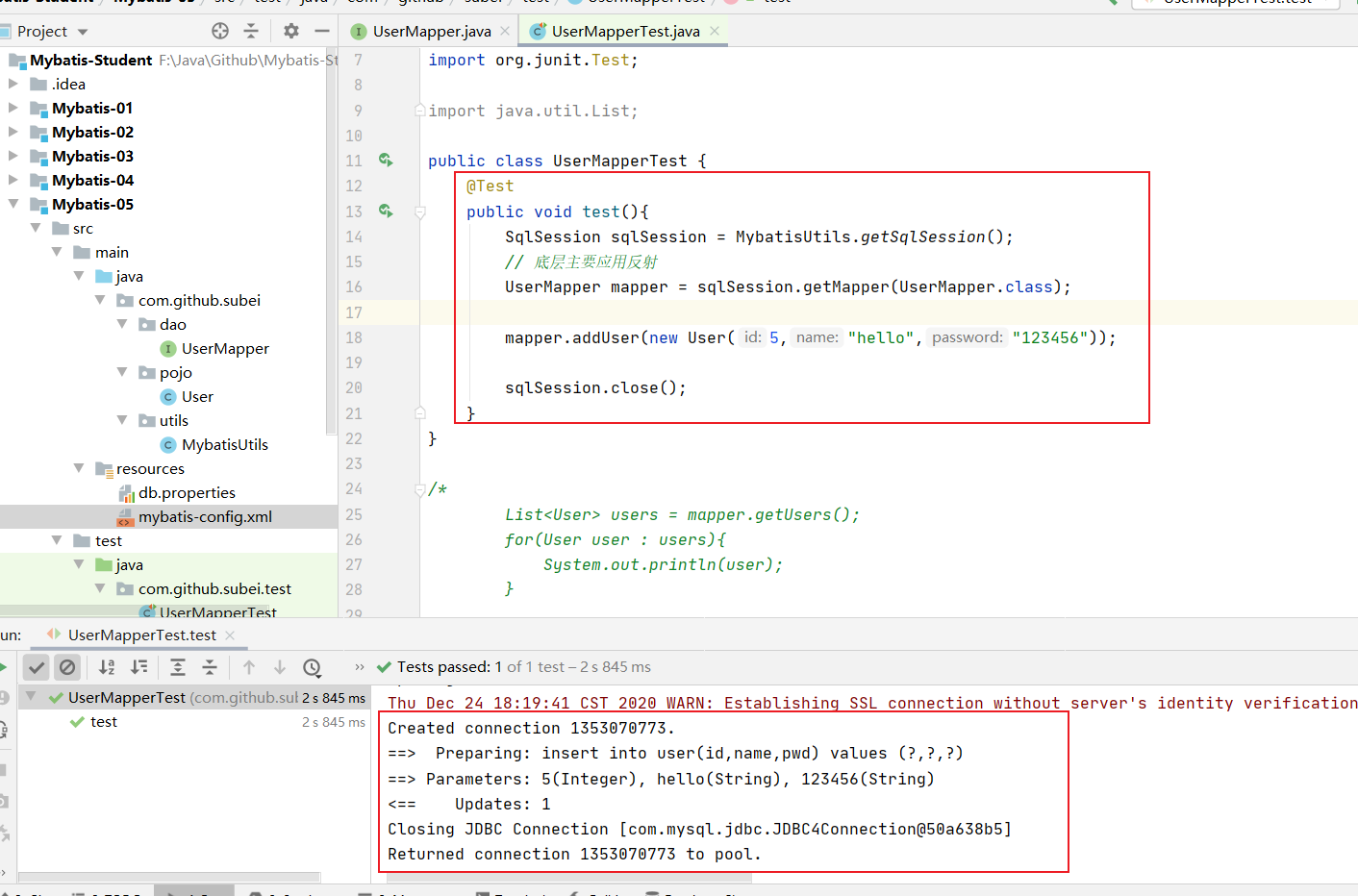
关于@Param() 注解
- 基本类型的参数或者String类型,需要加上。
- 引用类型不需要加。
- 如果只有一个基本类型的话,可以忽略,但是建议大家都加上!
- 我们在SQL中引用的就是我们这里的 @Param() 中设定的属性名!
#{}与${} 区别
-
参考链接:https://blog.csdn.net/kaixuansui/article/details/88637311
-
{} 解析为一个 JDBC 预编译语句(prepared statement)的参数标记符,一个 #{ } 被解析为一个参数占位符;而${}仅仅为一个纯碎的 string 替换,在动态 SQL 解析阶段将会进行变量替换。
-
{} 解析之后会将String类型的数据自动加上引号,其他数据类型不会;而${} 解析之后是什么就是什么,他不会当做字符串处理。
-
{} 很大程度上可以防止SQL注入(SQL注入是发生在编译的过程中,因为恶意注入了某些特殊字符,最后被编译成了恶意的执行操作);而${} 主要用于SQL拼接的时候,有很大的SQL注入隐患。
-
在某些特殊场合下只能用${},不能用#{}。
- 例如:在使用排序时ORDER BY $ {id},如果使用#{id},则会被解析成ORDER BY “id”,这显然是一种错误的写法。
9、Lombok
Project Lombok is a java library that automatically plugs into your editor and build tools, spicing up your java.
Never write another getter or equals method again, with one annotation your class has a fully featured builder, Automate your logging variables, and much more.
- java library
- plugs
- build tools
- with one annotation your class
使用步骤:
- 在IDEA中安装Lombok插件!
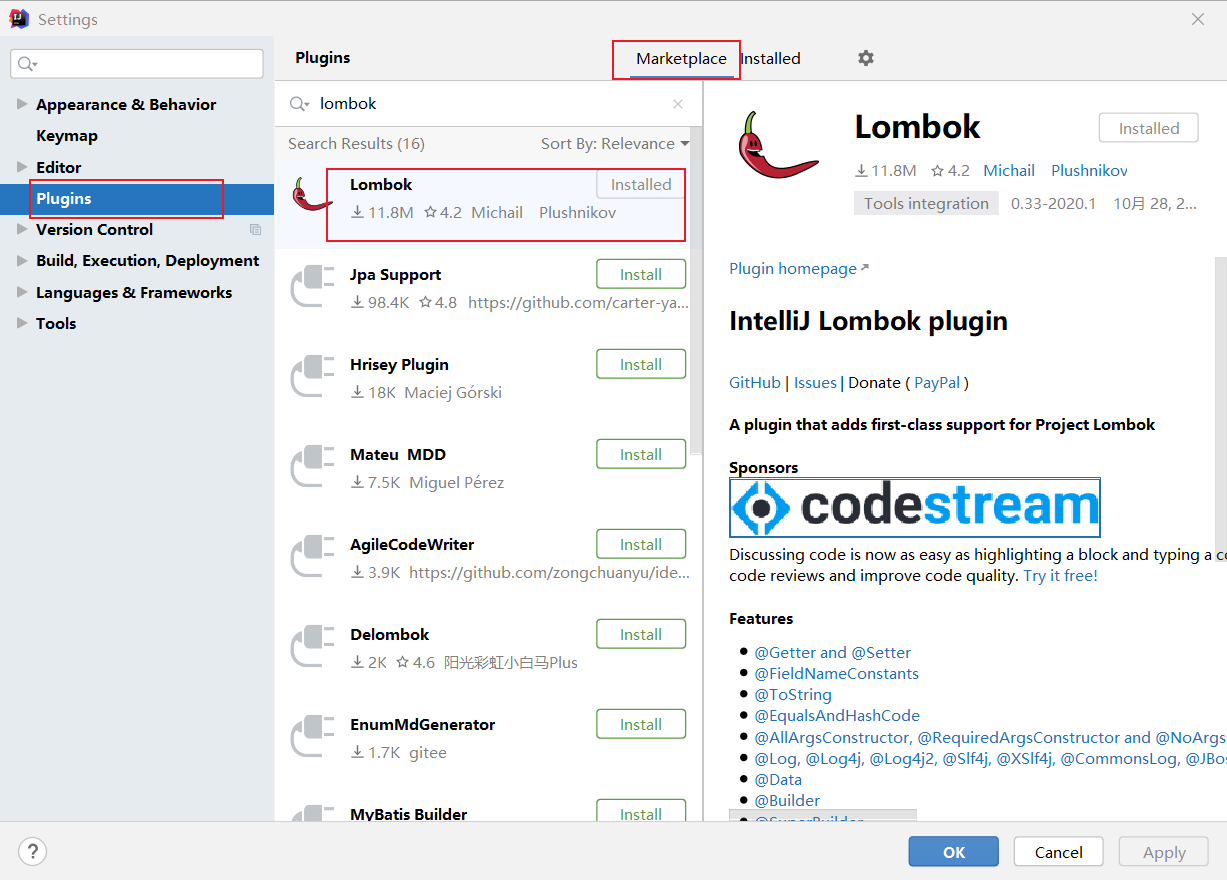
-
在项目中导入lombok的jar包
<dependencies> <!-- https://mvnrepository.com/artifact/org.projectlombok/lombok --> <dependency> <groupId>org.projectlombok</groupId> <artifactId>lombok</artifactId> <version>1.18.12</version> <scope>provided</scope> </dependency> </dependencies> -
在实体类上加注解即可!
@Data @AllArgsConstructor @NoArgsConstructor
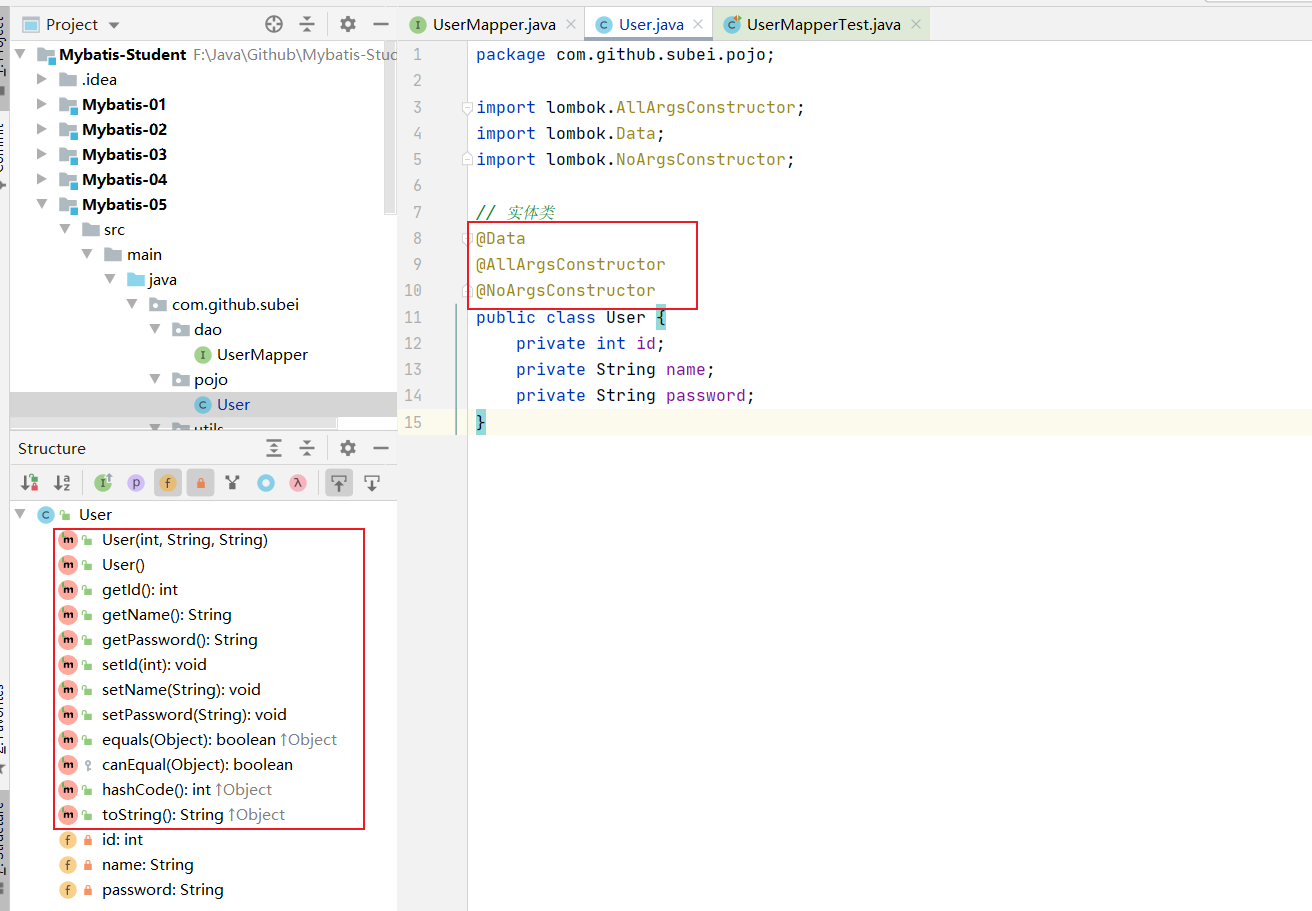
@Getter and @Setter
@FieldNameConstants
@ToString
@EqualsAndHashCode
@AllArgsConstructor, @RequiredArgsConstructor and @NoArgsConstructor
@Log, @Log4j, @Log4j2, @Slf4j, @XSlf4j, @CommonsLog, @JBossLog, @Flogger
@Data
@Builder
@Singular
@Delegate
@Value
@Accessors
@Wither
@SneakyThrows
- 说明:
@Data:无参构造,get、set、tostring、hashcode,equals
@AllArgsConstructor
@NoArgsConstructor
@EqualsAndHashCode
@ToString
@Getter
10、多对一处理(难点)
多对一:
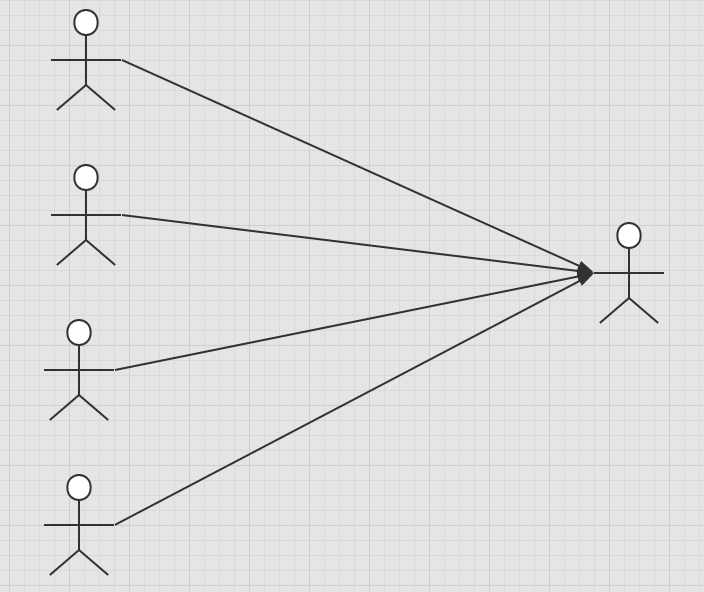
- 多个学生,对应一个老师
- 对于学生这边而言, 关联 .. 多个学生,关联一个老师 【多对一】
- 对于老师而言, 集合 , 一个老师,有很多学生 【一对多】
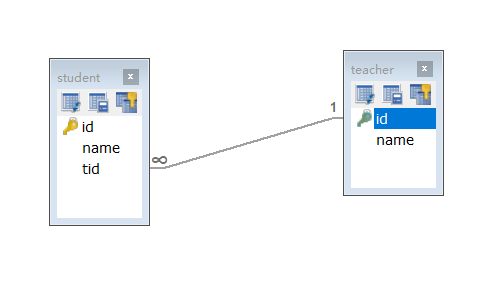
SQL:
CREATE TABLE `teacher` ( `id` INT ( 10 ) NOT NULL, `name` VARCHAR ( 30 ) DEFAULT NULL, PRIMARY KEY ( `id` ) ) ENGINE = INNODB DEFAULT CHARSET = utf8;
INSERT INTO teacher ( `id`, `name` )
VALUES
( 1, '秦老师' );
CREATE TABLE `student` (
`id` INT ( 10 ) NOT NULL,
`name` VARCHAR ( 30 ) DEFAULT NULL,
`tid` INT ( 10 ) DEFAULT NULL,
PRIMARY KEY ( `id` ),
KEY `fktid` ( `tid` ),
CONSTRAINT `fktid` FOREIGN KEY ( `tid` ) REFERENCES `teacher` ( `id` )
) ENGINE = INNODB DEFAULT CHARSET = utf8;
INSERT INTO `student` ( `id`, `name`, `tid` )
VALUES
( '1', '小明', '1' );
INSERT INTO `student` ( `id`, `name`, `tid` )
VALUES
( '2', '小红', '1' );
INSERT INTO `student` ( `id`, `name`, `tid` )
VALUES
( '3', '小张', '1' );
INSERT INTO `student` ( `id`, `name`, `tid` )
VALUES
( '4', '小李', '1' );
INSERT INTO `student` ( `id`, `name`, `tid` )
VALUES
( '5', '小王', '1' );
10.1测试环境搭建
- 导入lombok
- 新建实体类 Teacher,Student
package com.github.subei.pojo;
import lombok.AllArgsConstructor;
import lombok.Data;
import lombok.NoArgsConstructor;
@Data
@AllArgsConstructor
@NoArgsConstructor
public class Student {
private int id;
private String name;
// 学生需要关联一个老师
private Teacher teacher;
}
package com.github.subei.pojo;
import lombok.AllArgsConstructor;
import lombok.Data;
import lombok.NoArgsConstructor;
@Data
@AllArgsConstructor
@NoArgsConstructor
public class Teacher {
private int id;
private String name;
}
- 建立Mapper接口
package com.github.subei.dao;
import com.github.pojo.Teacher;
import org.apache.ibatis.annotations.Param;
import org.apache.ibatis.annotations.Select;
public interface TeacherMapper {
@Select("select * from teacher where id=#{tid}")
Teacher getTeacher(@Param("tid") int id);
}
- 建立Mapper.XML文件
<?xml version="1.0" encoding="UTF-8" ?>
<!DOCTYPE mapper
PUBLIC "-//mybatis.org//DTD Config 3.0//EN"
"http://mybatis.org/dtd/mybatis-3-mapper.dtd">
<mapper namespace="com.github.subei.dao.TeacherMapper">
</mapper>
- 在核心配置文件中绑定注册我们的Mapper接口或者文件!【方式很多,随心选】
mybatis-config.xml
<?xml version="1.0" encoding="UTF-8" ?>
<!DOCTYPE configuration
PUBLIC "-//mybatis.org//DTD Config 3.0//EN"
"http://mybatis.org/dtd/mybatis-3-config.dtd">
<configuration>
<properties resource="db.properties">
<property name="username" value="root"/>
<property name="password" value="root"/>
</properties>
<settings>
<setting name="logImpl" value="STDOUT_LOGGING"/>
</settings>
<typeAliases>
<package name="com.github.subei.pojo"/>
</typeAliases>
<environments default="development">
<environment id="development">
<transactionManager type="JDBC"/>
<dataSource type="POOLED">
<property name="driver" value="${driver}"/>
<property name="url" value="${url}"/>
<property name="username" value="${username}"/>
<property name="password" value="${password}"/>
</dataSource>
</environment>
</environments>
<mappers>
<mapper class="com.github.subei.dao.StudentMapper"/>
<mapper class="com.github.subei.dao.TeacherMapper"/>
</mappers>
</configuration>
- 测试查询是否能够成功!
import com.github.subei.dao.TeacherMapper;
import com.github.subei.pojo.Teacher;
import com.github.subei.utils.MybatisUtils;
import org.apache.ibatis.session.SqlSession;
public class MyTest {
public static void main(String[] args) {
SqlSession sqlSession = MybatisUtils.getSqlSession();
TeacherMapper mapper = sqlSession.getMapper(TeacherMapper.class);
Teacher teacher = mapper.getTeacher(1);
System.out.println(teacher);
sqlSession.close();
}
}
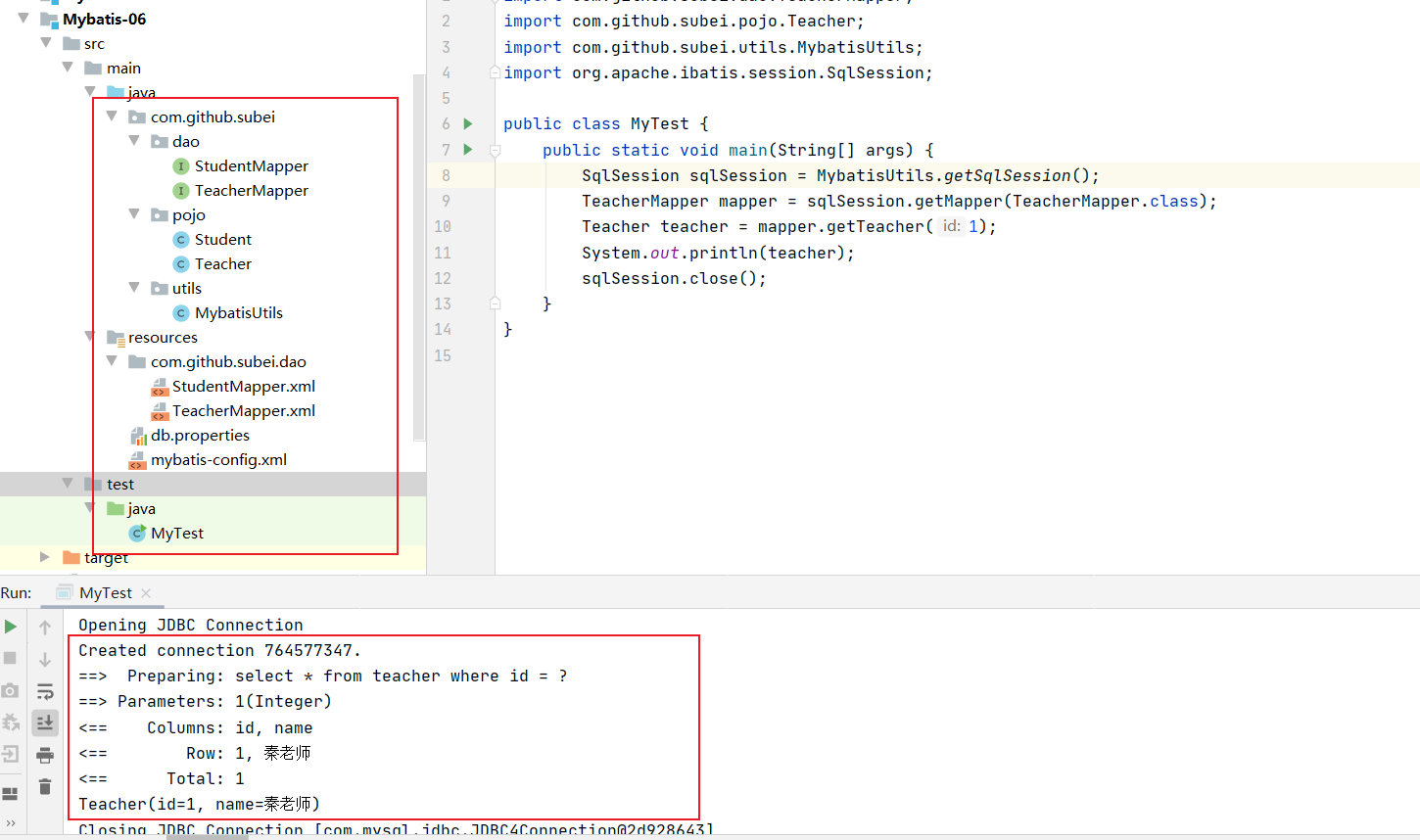
10.2按照查询嵌套处理
- StudentMapper接口
package com.github.subei.dao;
import com.github.subei.pojo.Student;
import java.util.List;
public interface StudentMapper {
// 查询所有的学生的信息,以及对应老师的信息
public List<Student> getStudent();
}
- StudentMapper.xml文件
<?xml version="1.0" encoding="UTF-8" ?>
<!DOCTYPE mapper
PUBLIC "-//mybatis.org//DTD Config 3.0//EN"
"http://mybatis.org/dtd/mybatis-3-mapper.dtd">
<!--configuration核心配置文件-->
<mapper namespace="com.github.subei.dao.StudentMapper">
<select id="getStudent" resultType="Student">
select * from student
</select>
</mapper>
- 测试类
import com.github.subei.dao.StudentMapper;
import com.github.subei.dao.TeacherMapper;
import com.github.subei.pojo.Student;
import com.github.subei.pojo.Teacher;
import com.github.subei.utils.MybatisUtils;
import org.apache.ibatis.session.SqlSession;
import org.junit.Test;
import java.util.List;
public class MyTest {
@Test
public void testStudent(){
SqlSession sqlSession = MybatisUtils.getSqlSession();
StudentMapper mapper = sqlSession.getMapper(StudentMapper.class);
List<Student> studentList = mapper.getStudent();
for(Student student : studentList){
System.out.println(student);
}
sqlSession.close();
}
}
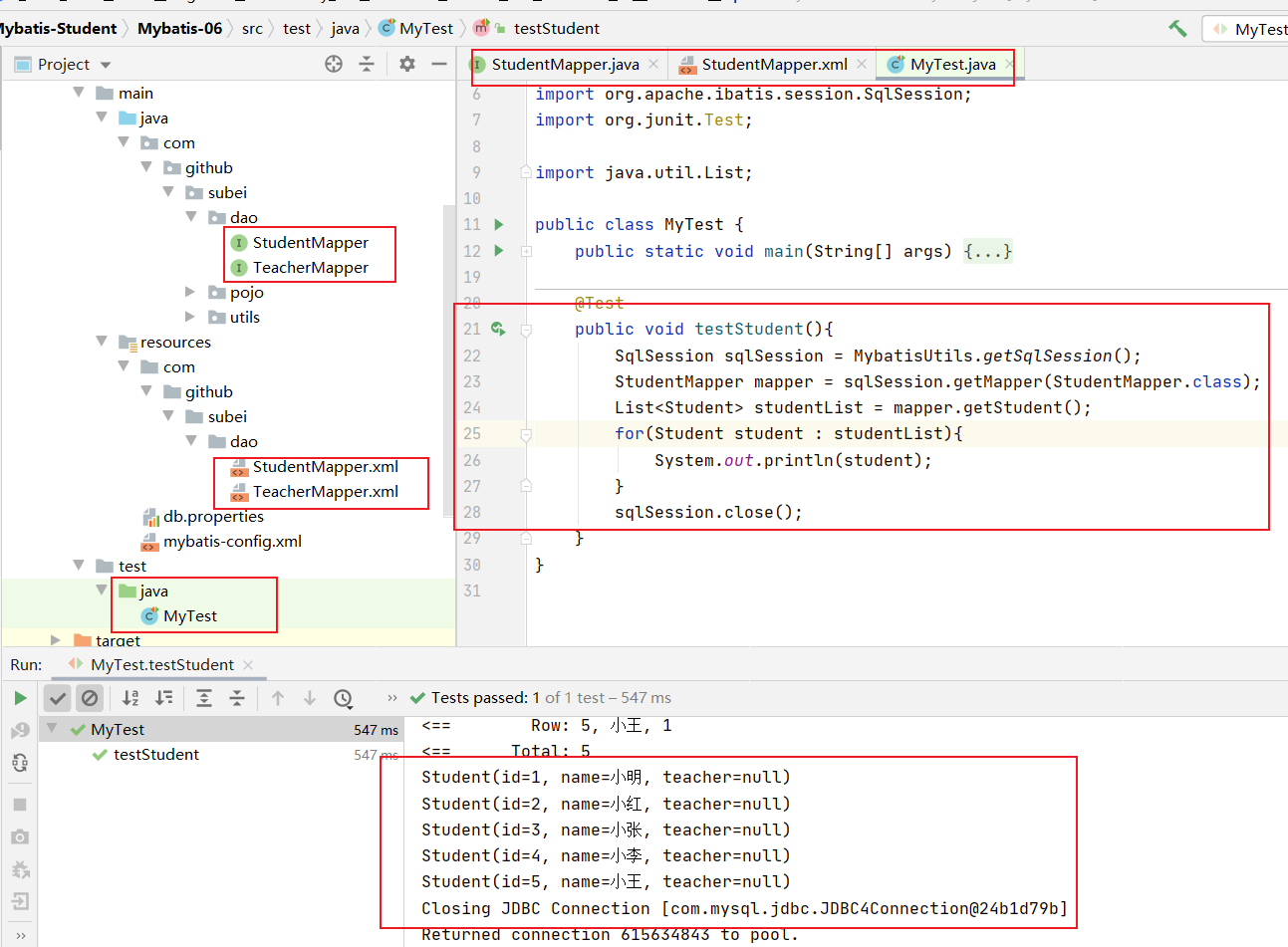
- 修改xml文件
<?xml version="1.0" encoding="UTF-8" ?>
<!DOCTYPE mapper
PUBLIC "-//mybatis.org//DTD Config 3.0//EN"
"http://mybatis.org/dtd/mybatis-3-mapper.dtd">
<!--configuration核心配置文件-->
<mapper namespace="com.github.subei.dao.StudentMapper">
<!--
思路:
1. 查询所有的学生信息
2. 根据查询出来的学生的tid,寻找对应的老师! 子查询
-->
<select id="getStudent" resultMap="StudentTeacher">
select * from student;
</select>
<resultMap id="StudentTeacher" type="Student">
<result property="id" column="id"/>
<result property="name" column="name"/>
<!-- 复杂的属性,需要单独处理
对象: association 集合: collection
-->
<association property="teacher" column="tid" javaType="Teacher" select="getTeacher"/>
</resultMap>
<select id="getTeacher" resultType="Teacher">
select * from teacher where id = #{id};
</select>
</mapper>

10.3按照结果嵌套处理
<!--按照结果嵌套处理-->
<select id="getStudent2" resultMap="StudentTeacher2">
select s.id sid,s.name sname,t.name tname
from student s,teacher t
where s.tid = t.id;
</select>
<resultMap id="StudentTeacher2" type="Student">
<result property="id" column="sid"/>
<result property="name" column="sname"/>
<association property="teacher" javaType="Teacher">
<result property="name" column="tname"/>
</association>
</resultMap>
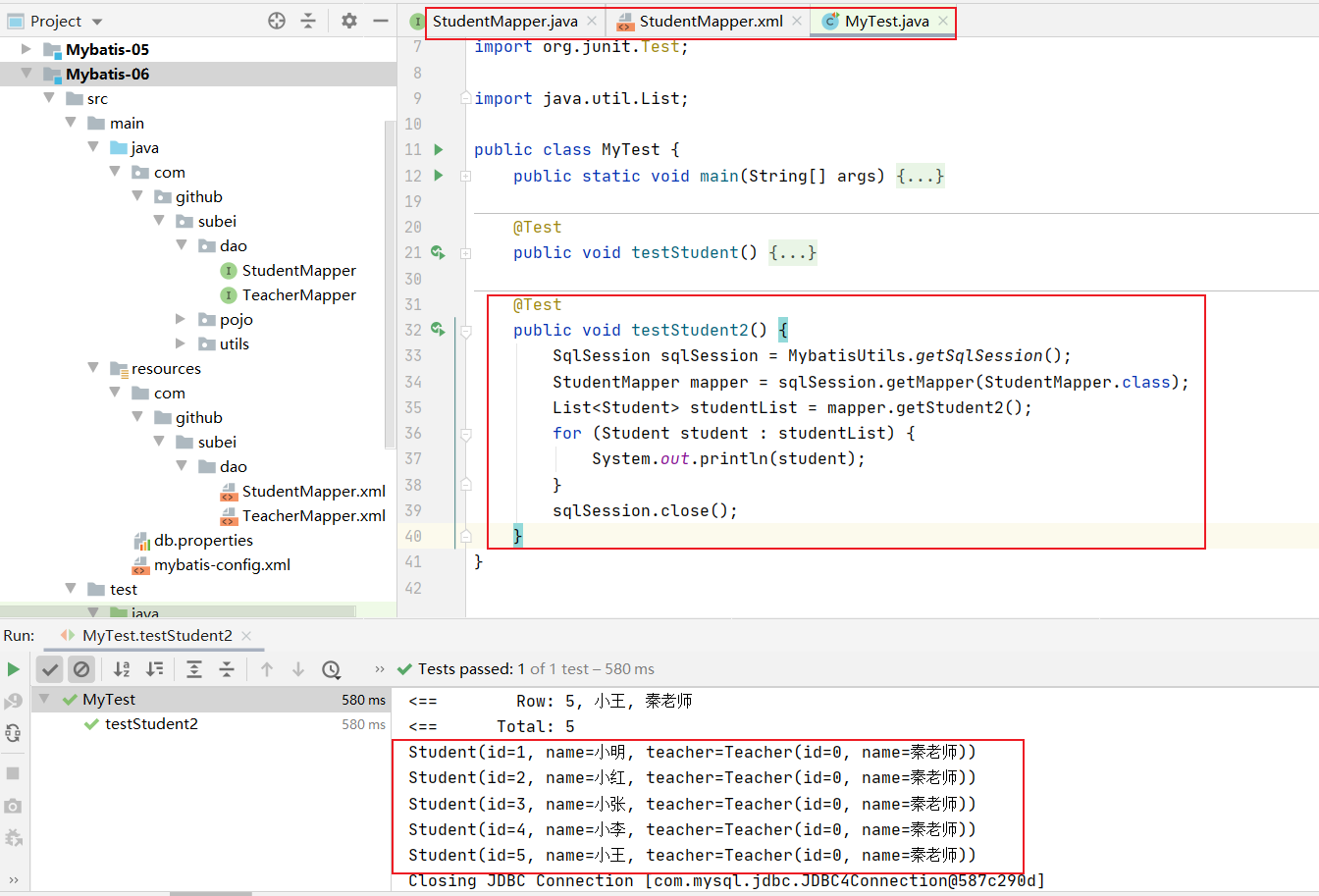
回顾Mysql 多对一查询方式:
- 子查询
- 联表查询
11、一对多处理(难点)
-
比如:一个老师拥有多个学生!
-
对于老师而言,就是一对多的关系!
11.1环境搭建
- 环境搭建,和刚才一样。
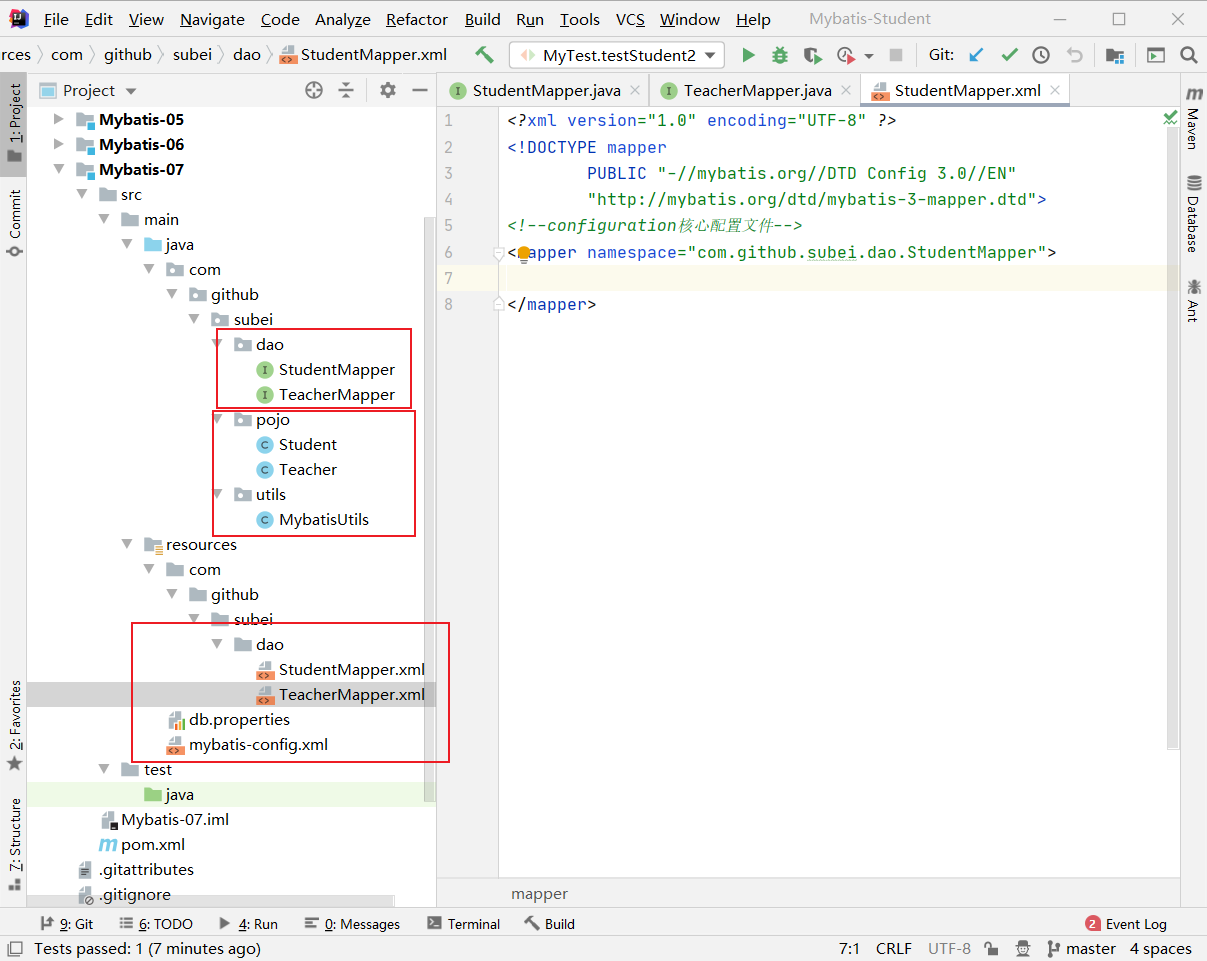
实体类
package com.github.subei.pojo;
import lombok.Data;
@Data
public class Student {
private int id;
private String name;
private int tid;
}
package com.github.subei.pojo;
import lombok.Data;
import java.util.List;
@Data
public class Teacher {
private int id;
private String name;
// 一个老师拥有多个学生
private List<Student> students;
}
- 测试一下,编写TeacherMapper接口
package com.github.subei.dao;
import com.github.subei.pojo.Teacher;
import java.util.List;
public interface TeacherMapper {
// 获取老师
List<Teacher> getTeacher();
}
- 编写xml文档
<?xml version="1.0" encoding="UTF-8" ?>
<!DOCTYPE mapper
PUBLIC "-//mybatis.org//DTD Config 3.0//EN"
"http://mybatis.org/dtd/mybatis-3-mapper.dtd">
<!--configuration核心配置文件-->
<mapper namespace="com.github.subei.dao.TeacherMapper">
<select id="getTeacher" resultType="Teacher">
select * from mybatis.teacher;
</select>
</mapper>
- 编写测试文档
import com.github.subei.dao.TeacherMapper;
import com.github.subei.pojo.Teacher;
import com.github.subei.utils.MybatisUtils;
import org.apache.ibatis.session.SqlSession;
import org.junit.Test;
import java.util.List;
public class MyTest {
@Test
public void FTest(){
SqlSession sqlSession = MybatisUtils.getSqlSession();
TeacherMapper mapper = sqlSession.getMapper(TeacherMapper.class);
List<Teacher> teacherList = mapper.getTeacher();
for (Teacher teacher : teacherList){
System.out.println(teacher);
}
sqlSession.close();
}
}
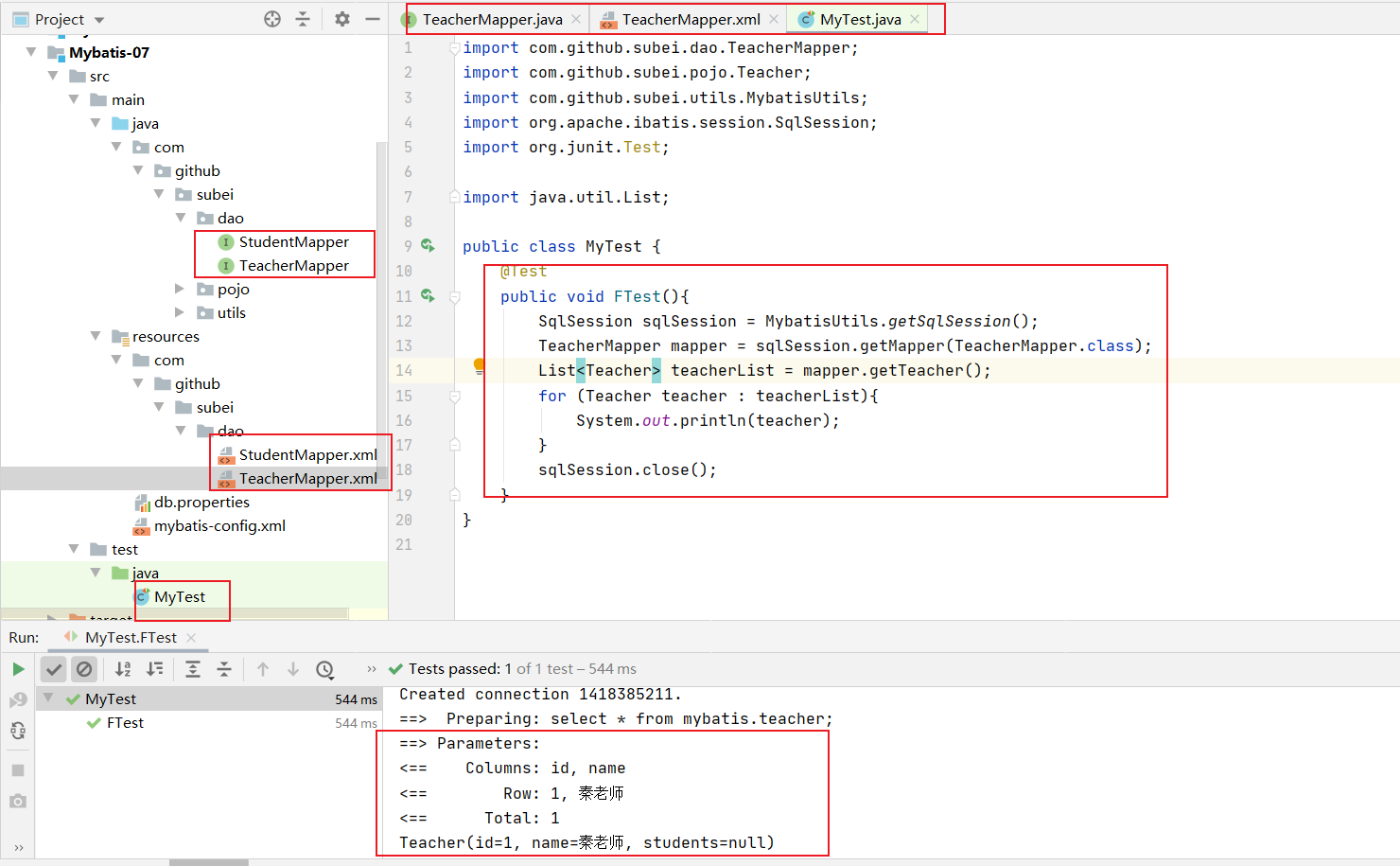
11.2按照结果嵌套处理
- 修改接口文档
package com.github.subei.dao;
import org.apache.ibatis.annotations.Param;
import org.apache.ibatis.annotations.Select;
import com.github.subei.pojo.Teacher;
import java.util.List;
public interface TeacherMapper {
// 获取老师
// List<Teacher> getTeacher();
// 获取指定老师下的所有的学生及老师信息
Teacher getTeacher(@Param("tid") int id);
}
- 修改xml文档
<!--按结果嵌套查询-->
<select id="getTeacher" resultMap="TeacherStudent">
select s.id sid, s.name sname, t.name tname,t.id tid
from student s,teacher t
where s.tid = t.id and t.id = #{tid};
</select>
<resultMap id="TeacherStudent" type="Teacher">
<result property="id" column="tid"/>
<result property="name" column="tname"/>
<!--复杂的属性,需要单独处理
对象: association 集合: collection
javaType="" 指定属性的类型!
集合中的泛型信息,我们使用ofType获取
-->
<collection property="students" ofType="Student">
<result property="id" column="sid"/>
<result property="name" column="sname"/>
<result property="tid" column="tid"/>
</collection>
</resultMap>
- 测试文档
import com.github.subei.dao.TeacherMapper;
import com.github.subei.pojo.Teacher;
import com.github.subei.utils.MybatisUtils;
import org.apache.ibatis.session.SqlSession;
import org.junit.Test;
import java.util.List;
public class MyTest {
@Test
public void FTest(){
SqlSession sqlSession = MybatisUtils.getSqlSession();
TeacherMapper mapper = sqlSession.getMapper(TeacherMapper.class);
Teacher teacher = mapper.getTeacher(1);
System.out.println(teacher);
sqlSession.close();
}
}

11.3按照查询嵌套处理
Teacher getTeacher2(@Param("tid") int id);
<select id="getTeacher2" resultMap="TeacherStudent2">
select * from mybatis.teacher where id = #{tid}
</select>
<resultMap id="TeacherStudent2" type="Teacher">
<collection property="students" javaType="ArrayList" ofType="Student" select="getStudentByTeacherId" column="id"/>
</resultMap>
<select id="getStudentByTeacherId" resultType="Student">
select * from mybatis.student where tid = #{tid}
</select>
@Test
public void TTest(){
SqlSession sqlSession = MybatisUtils.getSqlSession();
TeacherMapper mapper = sqlSession.getMapper(TeacherMapper.class);
Teacher teacher = mapper.getTeacher2(1);
System.out.println(teacher);
sqlSession.close();
}
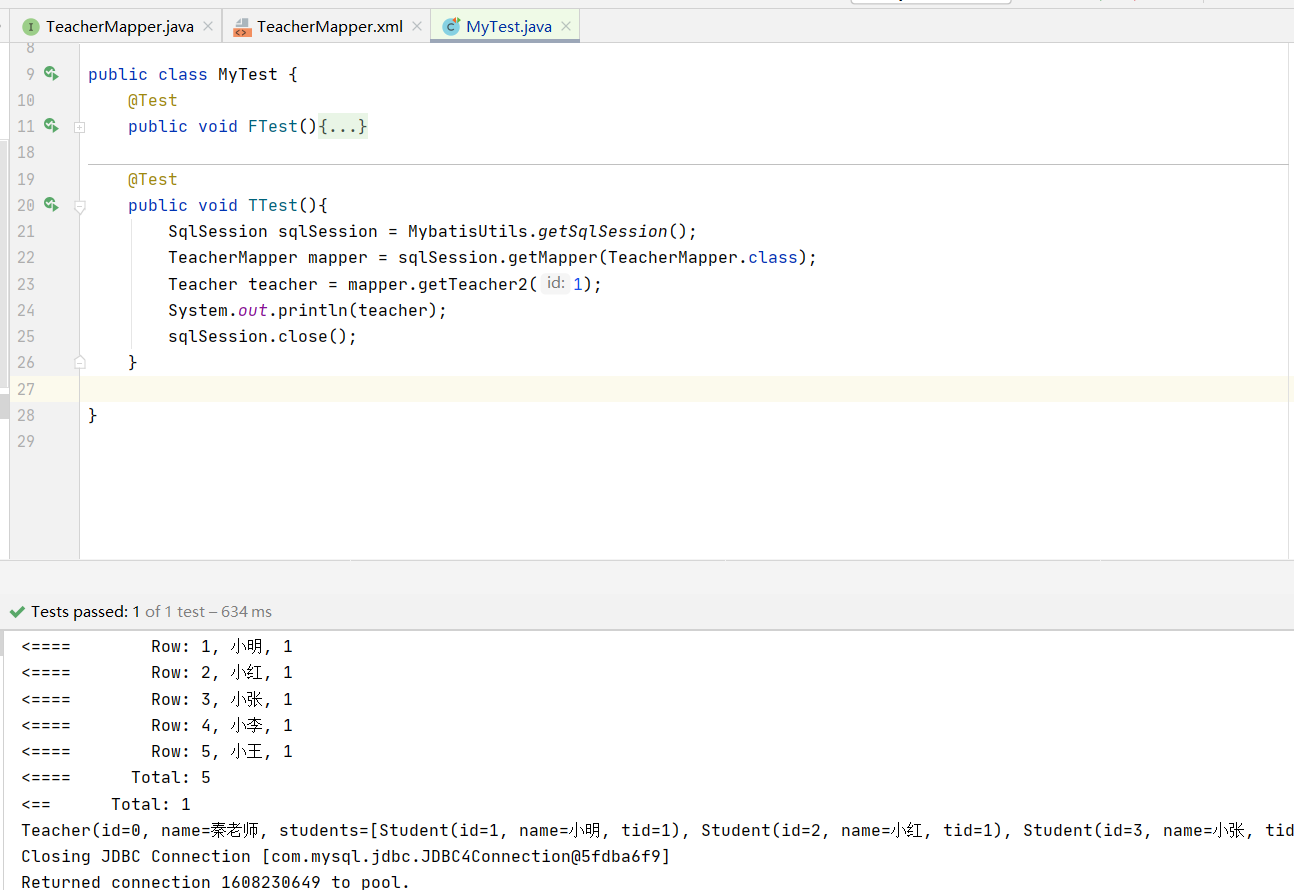
小结
- 关联 - association 【多对一】
- 集合 - collection 【一对多】
- javaType & ofType
- JavaType 用来指定实体类中属性的类型
- ofType 用来指定映射到List或者集合中的 pojo类型,泛型中的约束类型!
注意点:
- 保证SQL的可读性,尽量保证通俗易懂!
- 注意一对多和多对一中,属性名和字段的问题!
- 如果问题不好排查错误,可以使用日志 , 建议使用 Log4j!
慢SQL 1s 1000s
面试高频:
- Mysql引擎
- InnoDB底层原理
- 索引
- 索引优化!
12、动态 SQL
什么是动态SQL:动态SQL就是指根据不同的条件生成不同的SQL语句
- 利用动态 SQL 这一特性可以彻底摆脱这种痛苦。
动态 SQL 元素和 JSTL 或基于类似 XML 的文本处理器相似。
在 MyBatis 之前的版本中,有很多元素需要花时间了解。
MyBatis 3 大大精简了元素种类,现在只需学习原来一半的元素便可。
MyBatis 采用功能强大的基于 OGNL 的表达式来淘汰其它大部分元素。
if
choose (when, otherwise)
trim (where, set)
foreach
搭建环境
CREATE TABLE `blog` (
`id` VARCHAR ( 50 ) NOT NULL COMMENT '博客id',
`title` VARCHAR ( 100 ) NOT NULL COMMENT '博客标题',
`author` VARCHAR ( 30 ) NOT NULL COMMENT '博客作者',
`create_time` datetime NOT NULL COMMENT '创建时间',
`views` INT ( 30 ) NOT NULL COMMENT '浏览量'
) ENGINE = INNODB DEFAULT CHARSET = utf8;
创建一个基础工程:
- 导包。
- IDutil工具类
package com.github.subei.utils;
import java.util.UUID;
public class IUtils {
public static String genId(){
return UUID.randomUUID().toString().replaceAll("-","");
}
}
- 编写实体类
package com.github.subei.pojo;
import lombok.Data;
import java.util.Date;
@Data
public class Blog {
private String id;
private String title;
private String author;
private Date createTime;
private int views;
}
- 编写Mapper接口及xml文件
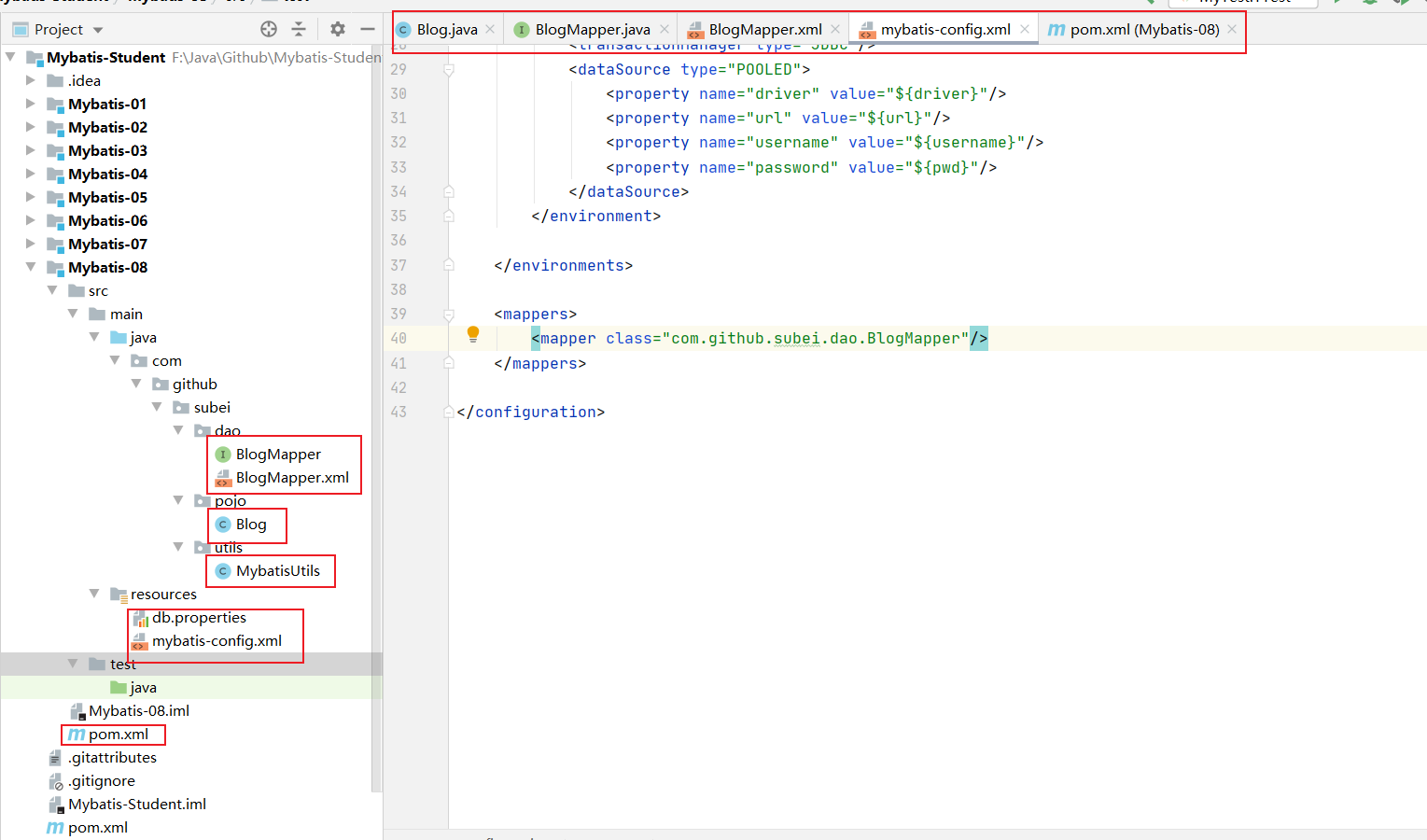
package com.github.dao;
import com.github.subei.pojo.Blog;
import java.util.List;
import java.util.Map;
public interface BlogMapper {
// 新增一个博客
int addBlog(Blog blog);
}
<?xml version="1.0" encoding="UTF-8" ?>
<!DOCTYPE mapper
PUBLIC "-//mybatis.org//DTD Config 3.0//EN"
"http://mybatis.org/dtd/mybatis-3-mapper.dtd">
<mapper namespace="com.github.dao.BlogMapper">
<insert id="addBlog" parameterType="blog">
insert into blog (id, title, author, create_time, views)
values (#{id},#{title},#{author},#{createTime},#{views});
</insert>
</mapper>
- mybatis核心配置文件
<?xml version="1.0" encoding="UTF-8" ?>
<!DOCTYPE configuration
PUBLIC "-//mybatis.org//DTD Config 3.0//EN"
"http://mybatis.org/dtd/mybatis-3-config.dtd">
<configuration>
<properties resource="db.properties">
<property name="username" value="root"/>
<property name="password" value="root"/>
</properties>
<settings>
<setting name="logImpl" value="STDOUT_LOGGING"/>
</settings>
<typeAliases>
<package name="com.github.subei.pojo"/>
</typeAliases>
<environments default="development">
<environment id="development">
<transactionManager type="JDBC"/>
<dataSource type="POOLED">
<property name="driver" value="${driver}"/>
<property name="url" value="${url}"/>
<property name="username" value="${username}"/>
<property name="password" value="${password}"/>
</dataSource>
</environment>
</environments>
<mappers>
<mapper class="com.github.subei.dao.BlogMapper"/>
</mappers>
</configuration>
- 测试类
import com.github.subei.dao.BlogMapper;
import com.github.subei.pojo.Blog;
import com.github.subei.utils.IUtils;
import com.github.subei.utils.MybatisUtils;
import org.apache.ibatis.session.SqlSession;
import org.junit.Test;
import java.util.Date;
import java.util.HashMap;
import java.util.List;
public class MyTest {
@Test
public void addInitBlog(){
SqlSession session = MybatisUtils.getSqlSession();
BlogMapper mapper = session.getMapper(BlogMapper.class);
Blog blog = new Blog();
blog.setId(IUtils.genId());
blog.setTitle("Mybatis如此简单");
blog.setAuthor("功夫河粉");
blog.setCreateTime(new Date());
blog.setViews(998);
mapper.addBlog(blog);
blog.setId(IUtils.genId());
blog.setTitle("Java如此困难");
blog.setCreateTime(new Date());
blog.setViews(998);
mapper.addBlog(blog);
blog.setId(IUtils.genId());
blog.setTitle("Spring如此困难");
blog.setCreateTime(new Date());
blog.setViews(998);
mapper.addBlog(blog);
blog.setId(IUtils.genId());
blog.setTitle("微服务如此困难");
blog.setCreateTime(new Date());
blog.setViews(998);
mapper.addBlog(blog);
session.close();
}
}
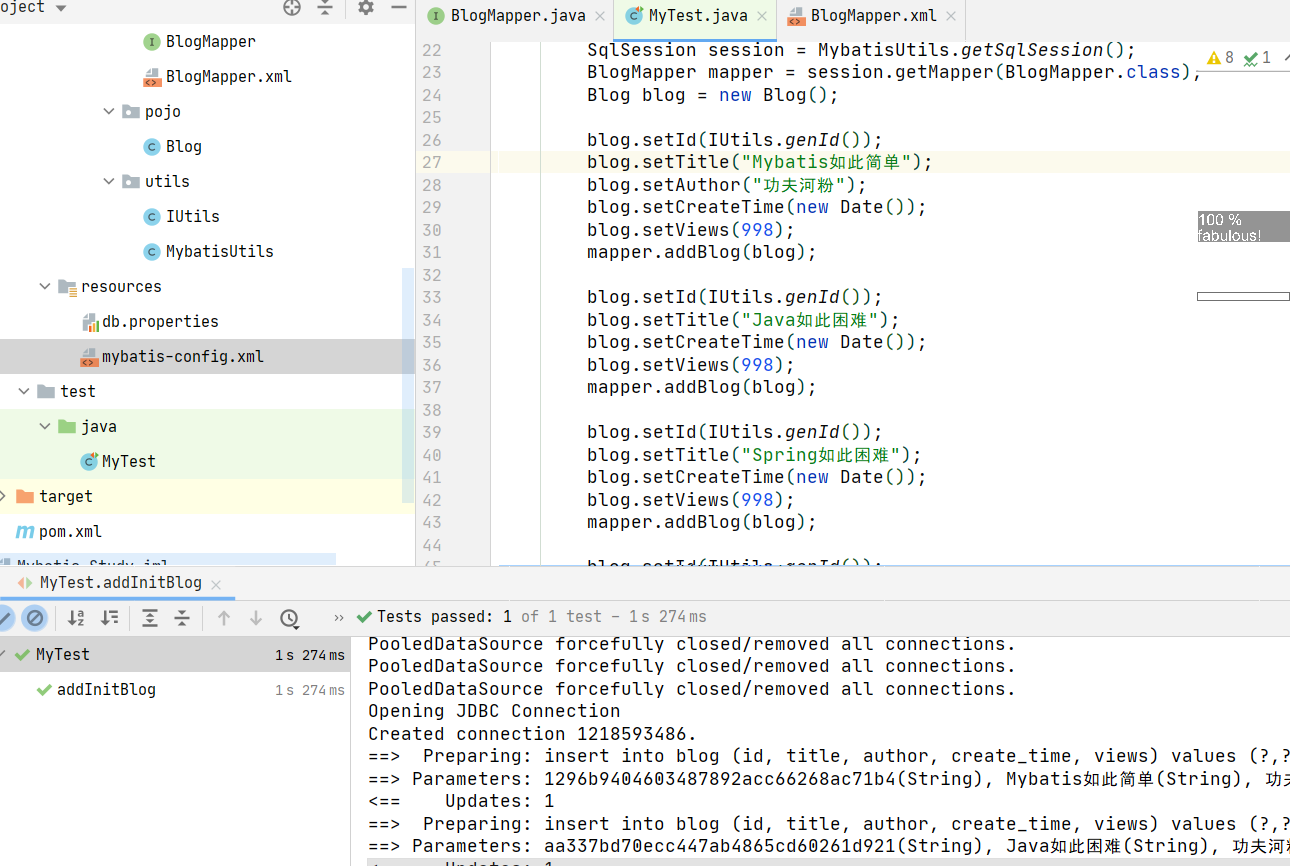
- 接口文件
// 查询博客
List<Blog> queryBlogIF(Map map);
- xml文件
<?xml version="1.0" encoding="UTF-8" ?>
<!DOCTYPE mapper
PUBLIC "-//mybatis.org//DTD Config 3.0//EN"
"http://mybatis.org/dtd/mybatis-3-mapper.dtd">
<!--configuration核心配置文件-->
<mapper namespace="com.github.subei.dao.BlogMapper">
<select id="queryBlogIF" parameterType="map" resultType="blog">
select * from mybatis.blog where 1=1
<if test="title != null">
and title = #{title}
</if>
<if test="author != null">
and author = #{author}
</if>
</select>
</mapper>
- 测试类
@Test
public void IFTest(){
SqlSession session = MybatisUtils.getSqlSession();
BlogMapper mapper = session.getMapper(BlogMapper.class);
HashMap map = new HashMap();
map.put("title","java如此困难");
List<Blog> blogs = mapper.queryBlogIF(map);
for(Blog blog : blogs){
System.out.println(blog);
}
session.close();
}
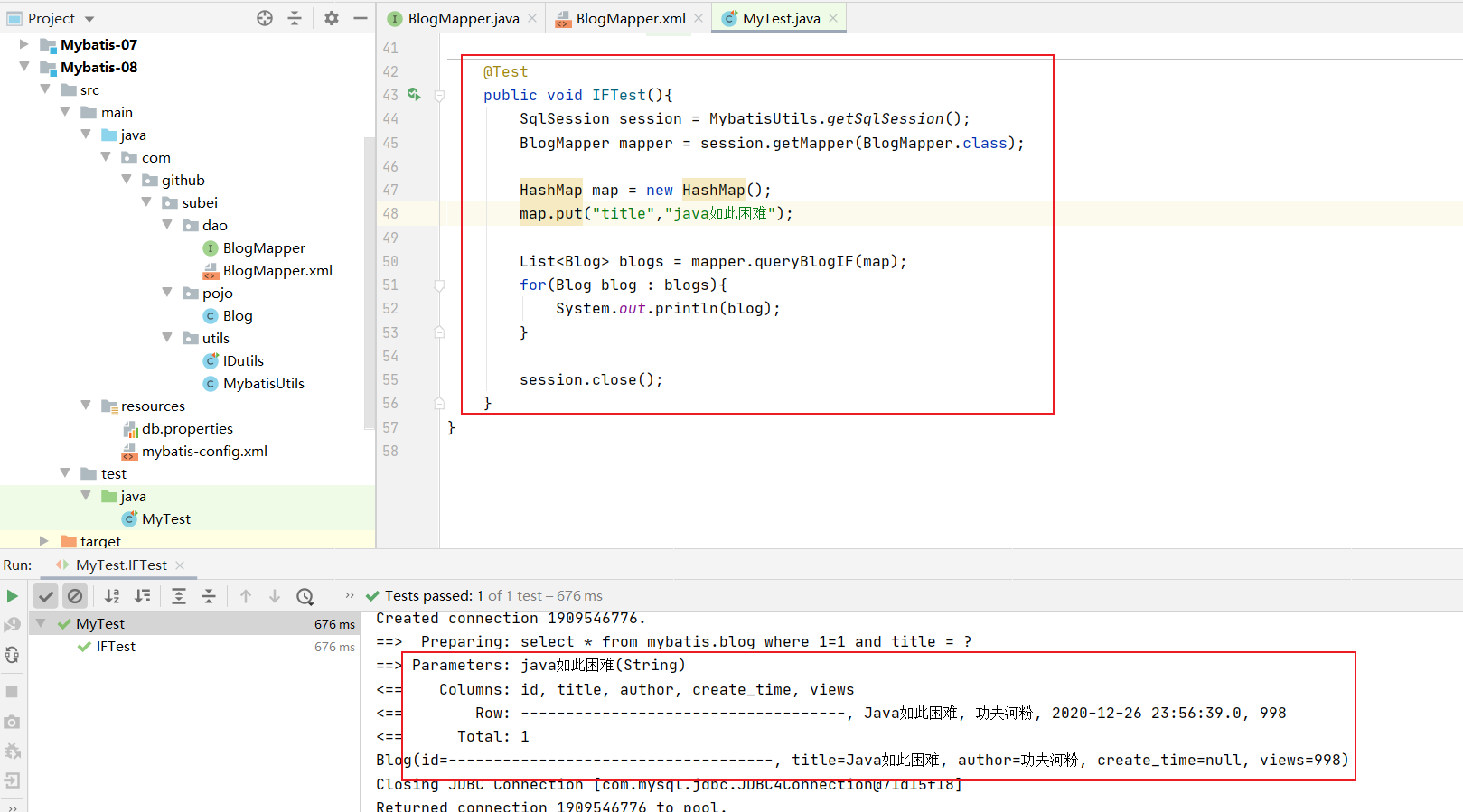
choose (when, otherwise)
传入了 “title” 就按 “title” 查找,传入了 “author” 就按 “author” 查找的情形。若两者都没有传入,就返回标记为 featured 的 BLOG(这可能是管理员认 为,与其返回大量的无意义随机 Blog,还不如返回一些由管理员精选的 Blog)。
List<Blog> queryBlogChoose(Map map);
<select id="queryBlogChoose" parameterType="map" resultType="blog">
select * from mybatis.blog
<where>
<choose>
<when test="title != null">
title = #{title}
</when>
<when test="author != null">
and author = #{author}
</when>
<otherwise>
and views = #{views}
</otherwise>
</choose>
</where>
</select>
@Test
public void chooseTest(){
SqlSession session = MybatisUtils.getSqlSession();
BlogMapper mapper = session.getMapper(BlogMapper.class);
HashMap map = new HashMap();
// map.put("title","java如此困难");
map.put("views",998);
List<Blog> blogs = mapper.queryBlogIF(map);
for(Blog blog : blogs){
System.out.println(blog);
}
session.close();
}
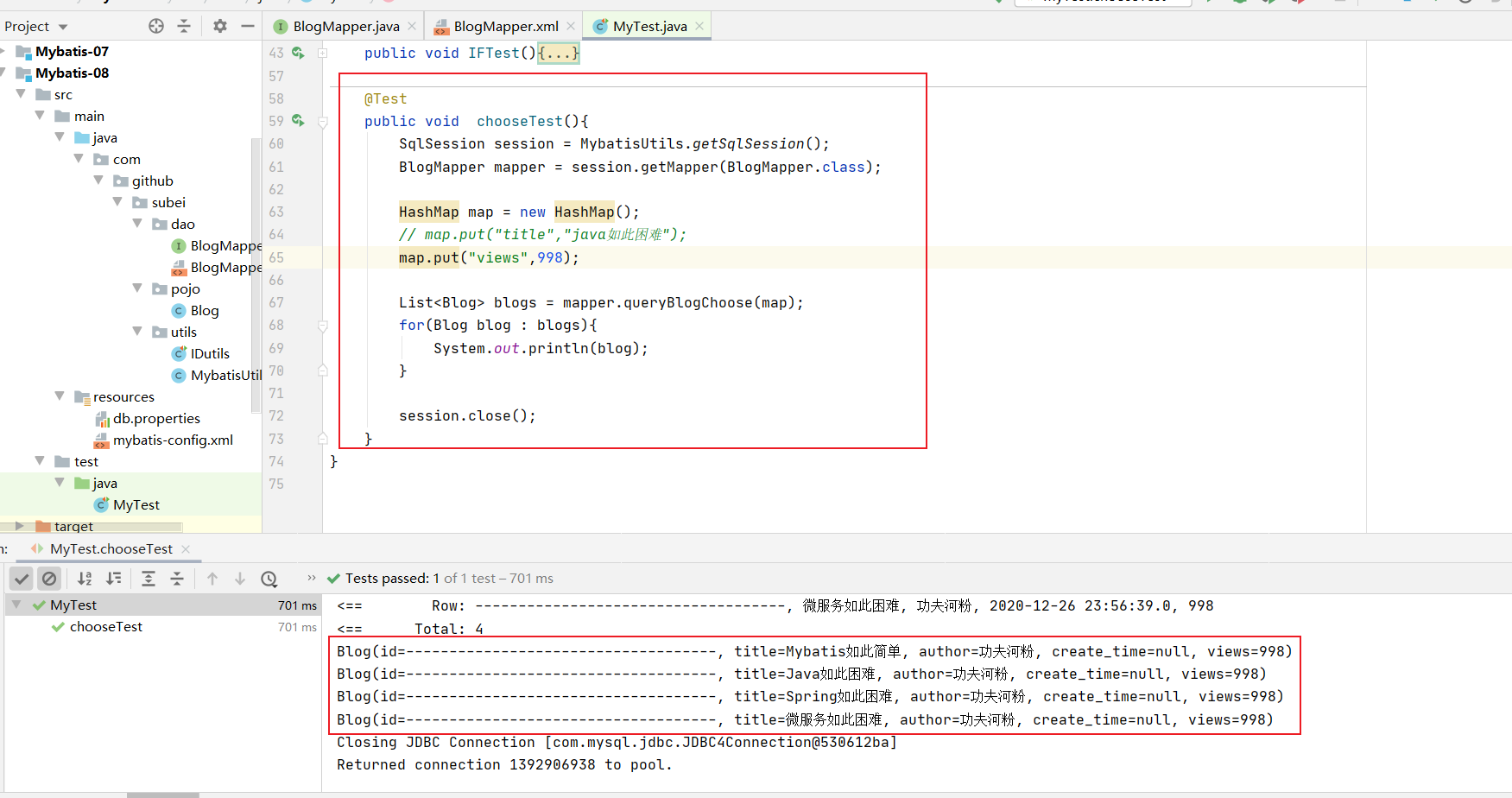
trim (where,set)
// 选择查询
List<Blog> queryBlogChoose(Map map);
// 修改博客
int updateBlog(Map map);
<select id="queryBlogChoose" parameterType="map" resultType="blog">
select * from mybatis.blog
<where>
<if test="title != null">
title = #{title}
</if>
<if test="author != null">
and author = #{author}
</if>
</where>
</select>
<update id="updateBlog" parameterType="map">
update mybatis.blog
<set>
<if test="title != null">
title = #{title},
</if>
<if test="author != null">
author = #{author}
</if>
</set>
where id = #{id}
</update>
@Test
public void chooseTest(){
SqlSession session = MybatisUtils.getSqlSession();
BlogMapper mapper = session.getMapper(BlogMapper.class);
HashMap map = new HashMap();
// map.put("title","java如此困难");
map.put("views",998);
List<Blog> blogs = mapper.queryBlogIF(map);
for(Blog blog : blogs){
System.out.println(blog);
}
session.close();
}
@Test
public void updateBlog(){
SqlSession session = MybatisUtils.getSqlSession();
BlogMapper mapper = session.getMapper(BlogMapper.class);
HashMap map = new HashMap();
map.put("title","MybatisPlus如此困难");
map.put("id","3690");
mapper.updateBlog(map);
session.close();
}
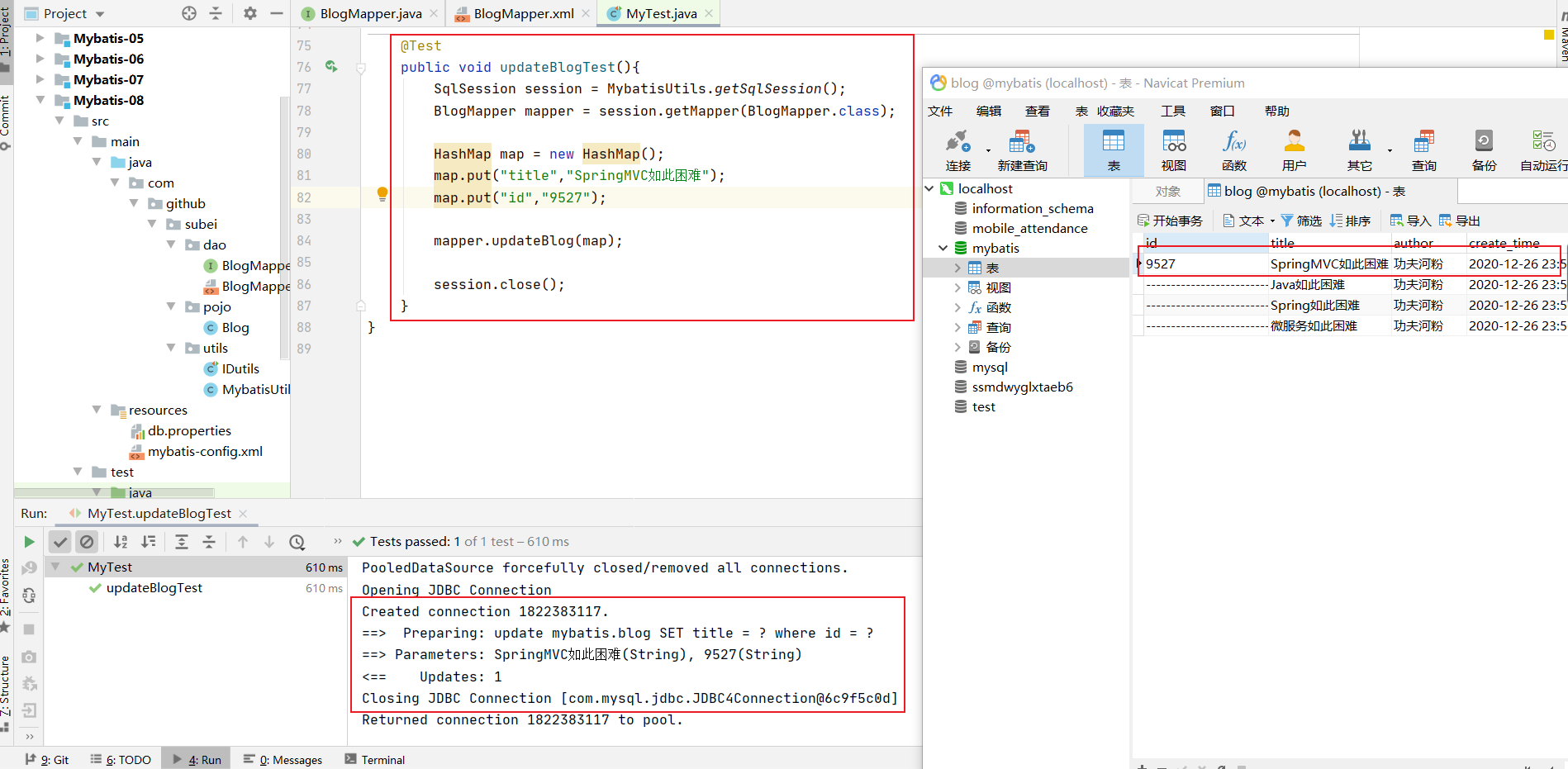
- 所谓的动态SQL,本质还是SQL语句 , 只是我们可以在SQL层面,去执行一个逻辑代码。
SQL片段
- 有的时候,我们可能会将一些功能的部分抽取出来,方便复用!
-
使用SQL标签抽取公共的部分;
<sql id="if-title-author"> <if test="title != null"> title = #{title} </if> <if test="author != null"> and author = #{author} </if> </sql> -
在需要使用的地方使用Include标签引用即可;
<select id="queryBlogIF" parameterType="map" resultType="blog"> select * from mybatis.blog <where> <include refid="if-title-author"></include> </where> </select>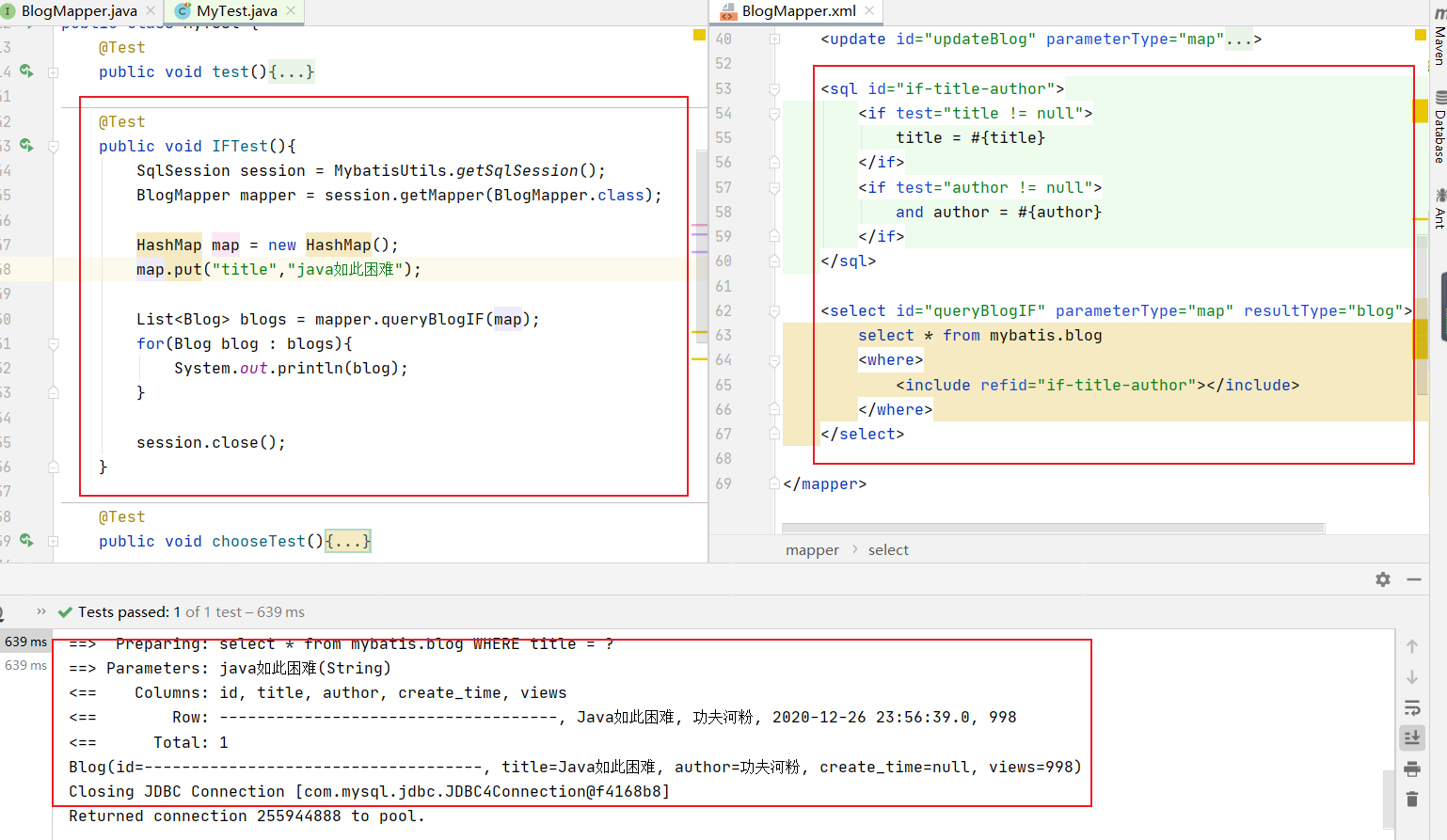
注意事项:
- 最好基于单表来定义SQL片段!
- 不要存在where标签;
Foreach
select * from user where 1=1 and
<foreach item="id" collection="ids"
open="(" separator="or" close=")">
#{id}
</foreach>
(id=1 or id=2 or id=3)
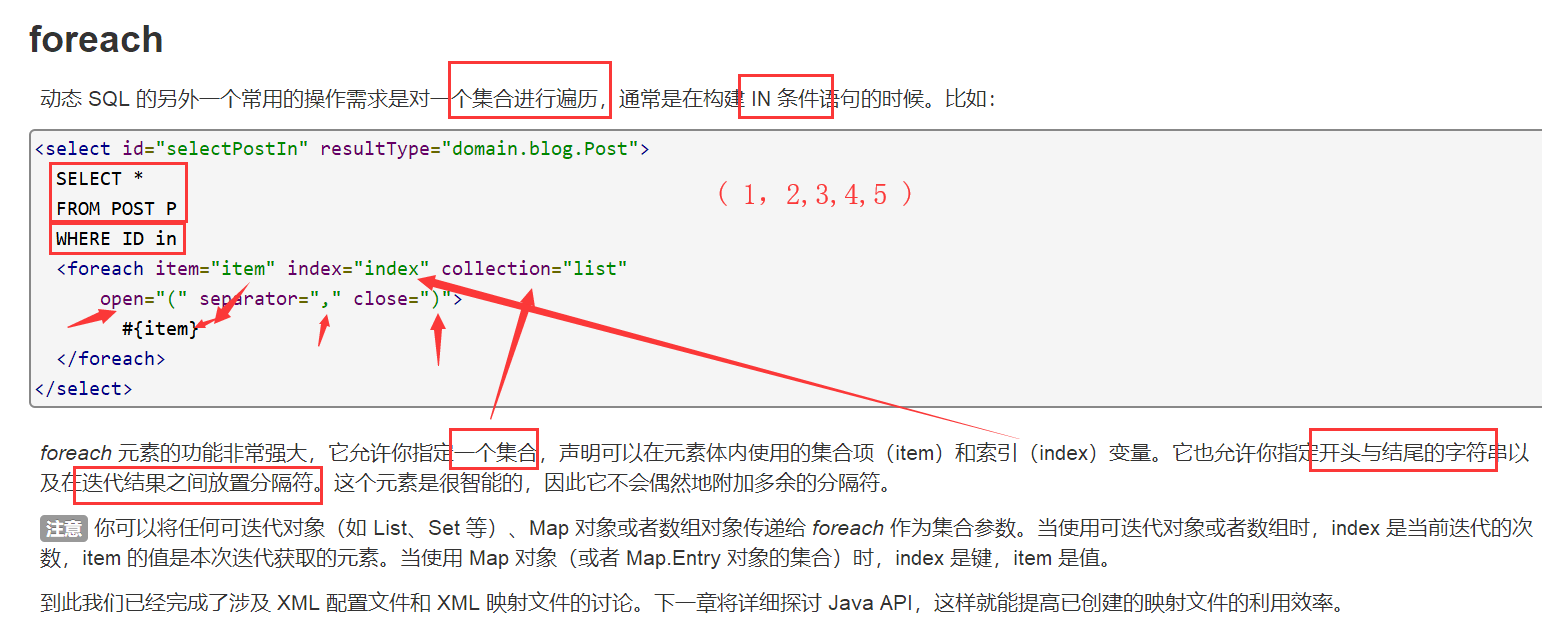

<!--
select * from mybatis.blog where 1=1 and (id=1 or id = 2 or id=3)
现在传递一个万能的map , 这map中可以存在一个集合!
-->
<select id="queryBlogForeach" parameterType="map" resultType="blog">
select * from mybatis.blog
<where>
<foreach collection="ids" item="id" open="and (" close=")" separator="or">
id = #{id}
</foreach>
</where>
</select>
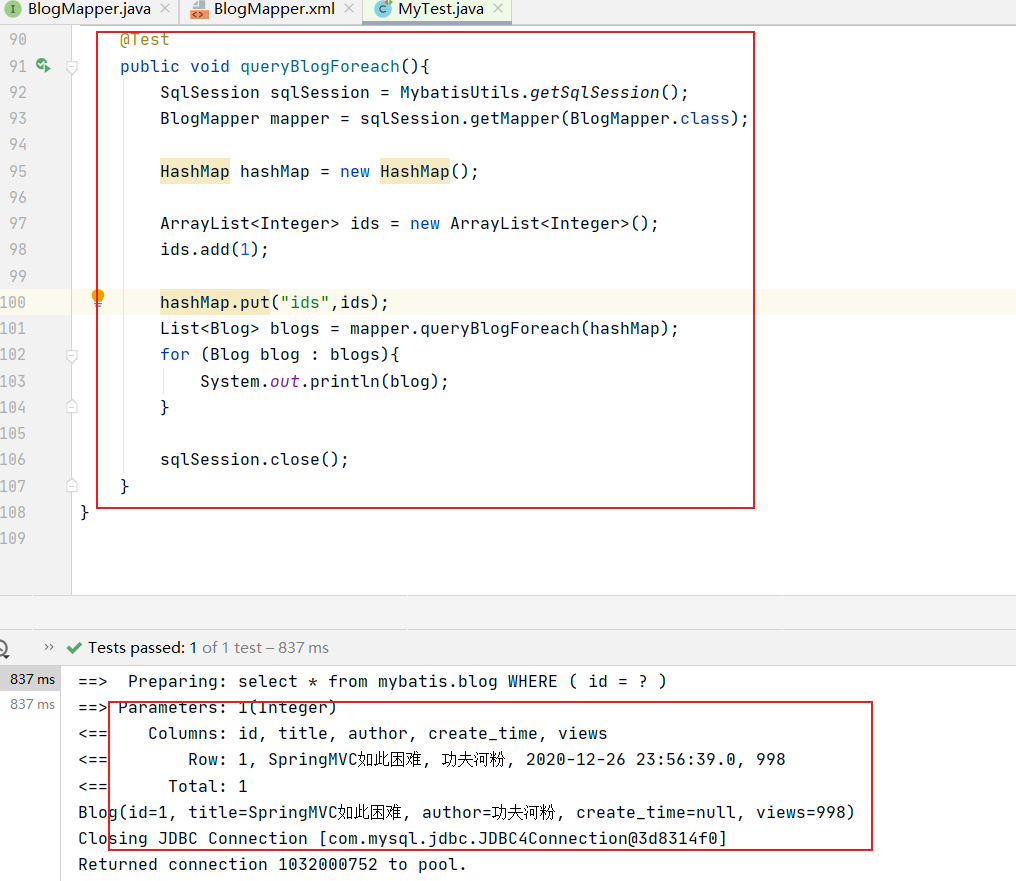
- 动态SQL就是在拼接SQL语句,我们只要保证SQL的正确性,按照SQL的格式,去排列组合就可以了
建议:
- 现在Mysql中写出完整的SQL,再对应的去修改成为我们的动态SQL实现通用即可!
13、缓存 (了解)
13.1、简介
查询 : 连接数据库 ,耗资源!
一次查询的结果,给他暂存在一个可以直接取到的地方!--> 内存 : 缓存
我们再次查询相同数据的时候,直接走缓存,就不用走数据库了
-
什么是缓存 [ Cache ]?
- 存在内存中的临时数据。
- 将用户经常查询的数据放在缓存(内存)中,用户去查询数据就不用从磁盘上(关系型数据库数据文件)查询,从缓存中查询,从而提高查询效率,解决了高并发系统的性能问题。
-
为什么使用缓存?
- 减少和数据库的交互次数,减少系统开销,提高系统效率。
-
什么样的数据能使用缓存?
- 经常查询并且不经常改变的数据。【可以使用缓存】
13.2、Mybatis缓存
- MyBatis包含一个非常强大的查询缓存特性,它可以非常方便地定制和配置缓存。缓存可以极大的提升查询效率。
- MyBatis系统中默认定义了两级缓存:一级缓存和二级缓存。
-
默认情况下,只有一级缓存开启。(SqlSession级别的缓存,也称为本地缓存)。
-
二级缓存需要手动开启和配置,他是基于namespace级别的缓存。
-
为了提高扩展性,MyBatis定义了缓存接口Cache。我们可以通过实现Cache接口来自定义二级缓存。
-
13.3、一级缓存
- 一级缓存也叫本地缓存: SqlSession
- 与数据库同一次会话期间查询到的数据会放在本地缓存中。
- 以后如果需要获取相同的数据,直接从缓存中拿,没必须再去查询数据库;
测试步骤:
- 开启日志!
- 测试在一个Sesion中查询两次相同记录
- 查看日志输出。
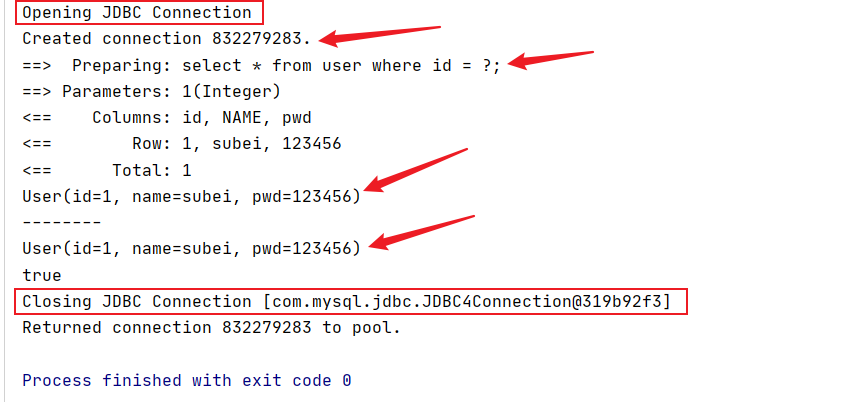
缓存失效的情况:
-
查询不同的东西。
-
增删改操作,可能会改变原来的数据,所以必定会刷新缓存!
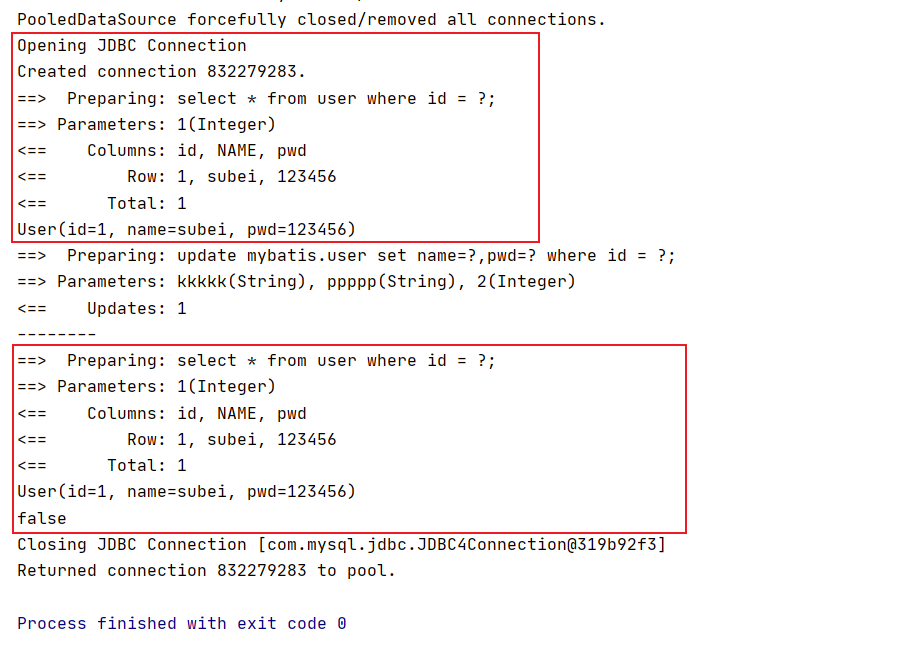
-
查询不同的Mapper.xml
-
手动清理缓存!
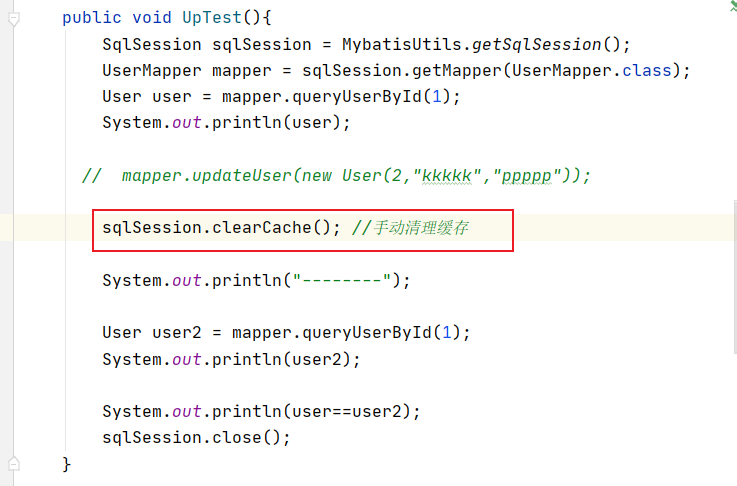
-
小结:一级缓存默认是开启的,只在一次SqlSession中有效,也就是拿到连接到关闭连接这个区间段!
-
一级缓存就是一个Map。
13.4、二级缓存
- 二级缓存也叫全局缓存,一级缓存作用域太低了,所以诞生了二级缓存
- 基于namespace级别的缓存,一个名称空间,对应一个二级缓存;
- 工作机制
- 一个会话查询一条数据,这个数据就会被放在当前会话的一级缓存中;
- 如果当前会话关闭了,这个会话对应的一级缓存就没了;但是我们想要的是,会话关闭了,一级缓存中的数据被保存到二级缓存中;
- 新的会话查询信息,就可以从二级缓存中获取内容;
- 不同的mapper查出的数据会放在自己对应的缓存(map)中;
步骤:
-
开启全局缓存;
<!--显示的开启全局缓存--> <setting name="cacheEnabled" value="true"/> -
在要使用二级缓存的Mapper中开启;
<!--在当前Mapper.xml中使用二级缓存--> <cache/>- 也可以自定义参数;
<!--在当前Mapper.xml中使用二级缓存--> <cache eviction="FIFO" flushInterval="60000" size="512" readOnly="true"/> -
测试。
-
问题:我们需要将实体类序列化!否则就会报错!
Caused by: java.io.NotSerializableException: com.github.spojo.User
-
小结:
- 只要开启了二级缓存,在同一个Mapper下就有效;
- 所有的数据都会先放在一级缓存中;
- 只有当会话提交,或者关闭的时候,才会提交到二级缓冲中!
13.5、缓存原理
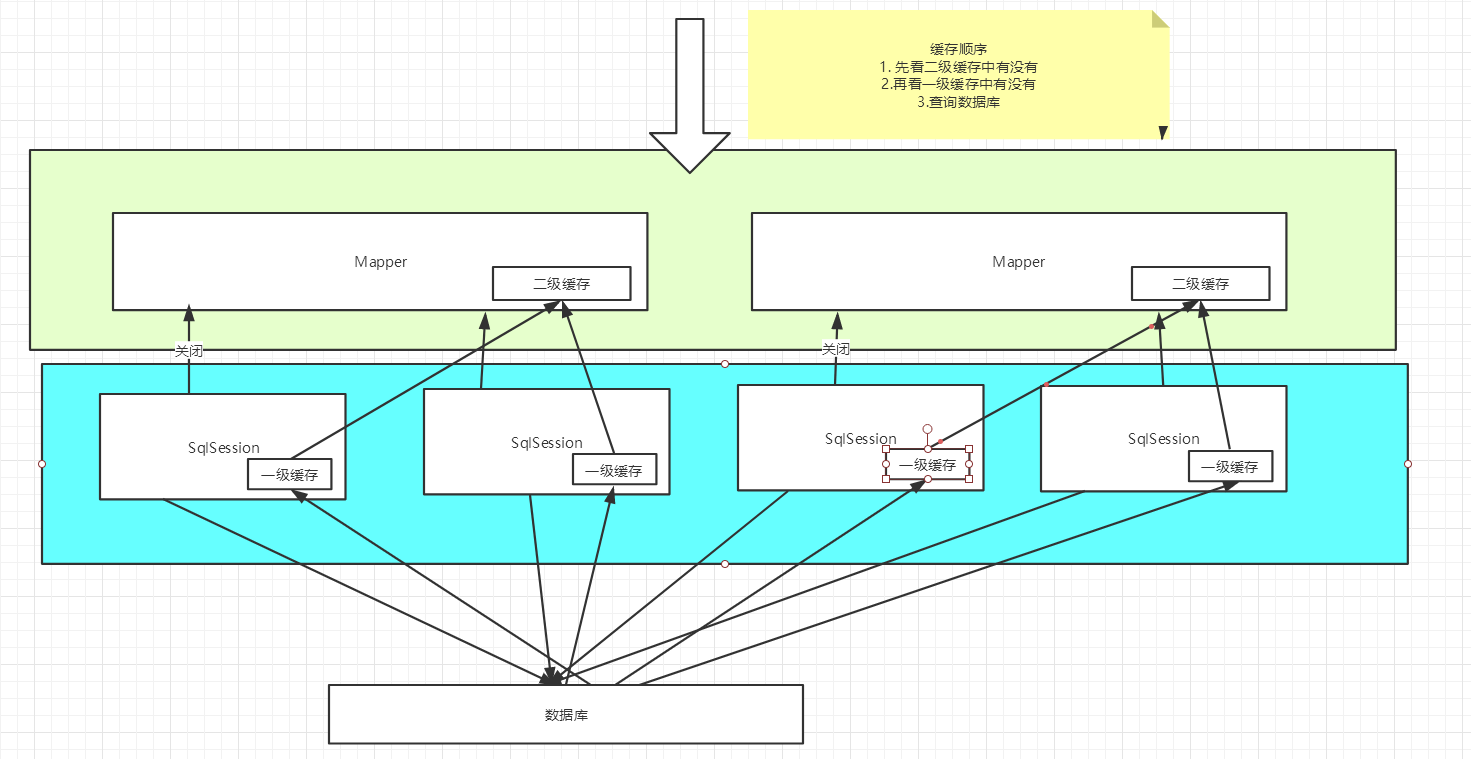
13.6、自定义缓存-ehcache
-
Ehcache是一种广泛使用的开源Java分布式缓存。主要面向通用缓存。
-
要在程序中使用ehcache,先要导包!
<!-- https://mvnrepository.com/artifact/org.mybatis.caches/mybatis-ehcache -->
<dependency>
<groupId>org.mybatis.caches</groupId>
<artifactId>mybatis-ehcache</artifactId>
<version>1.1.0</version>
</dependency>
- 在mapper中指定使用我们的ehcache缓存实现!
<!--在当前Mapper.xml中使用二级缓存-->
<cache type="org.mybatis.caches.ehcache.EhcacheCache"/>
- ehcache.xml
<?xml version="1.0" encoding="UTF-8"?>
<ehcache xmlns:xsi="http://www.w3.org/2001/XMLSchema-instance"
xsi:noNamespaceSchemaLocation="http://ehcache.org/ehcache.xsd"
updateCheck="false">
<!--
diskStore:为缓存路径,ehcache分为内存和磁盘两级,此属性定义磁盘的缓存位置。参数解释如下:
user.home – 用户主目录
user.dir – 用户当前工作目录
java.io.tmpdir – 默认临时文件路径
-->
<diskStore path="./tmpdir/Tmp_EhCache"/>
<defaultCache
eternal="false"
maxElementsInMemory="10000"
overflowToDisk="false"
diskPersistent="false"
timeToIdleSeconds="1800"
timeToLiveSeconds="259200"
memoryStoreEvictionPolicy="LRU"/>
<cache
name="cloud_user"
eternal="false"
maxElementsInMemory="5000"
overflowToDisk="false"
diskPersistent="false"
timeToIdleSeconds="1800"
timeToLiveSeconds="1800"
memoryStoreEvictionPolicy="LRU"/>
<!--
defaultCache:默认缓存策略,当ehcache找不到定义的缓存时,则使用这个缓存策略。只能定义一个。
-->
<!--
name:缓存名称。
maxElementsInMemory:缓存最大数目
maxElementsOnDisk:硬盘最大缓存个数。
eternal:对象是否永久有效,一但设置了,timeout将不起作用。
overflowToDisk:是否保存到磁盘,当系统当机时
timeToIdleSeconds:设置对象在失效前的允许闲置时间(单位:秒)。仅当eternal=false对象不是永久有效时使用,可选属性,默认值是0,也就是可闲置时间无穷大。
timeToLiveSeconds:设置对象在失效前允许存活时间(单位:秒)。最大时间介于创建时间和失效时间之间。仅当eternal=false对象不是永久有效时使用,默认是0.,也就是对象存活时间无穷大。
diskPersistent:是否缓存虚拟机重启期数据 Whether the disk store persists between restarts of the Virtual Machine. The default value is false.
diskSpoolBufferSizeMB:这个参数设置DiskStore(磁盘缓存)的缓存区大小。默认是30MB。每个Cache都应该有自己的一个缓冲区。
diskExpiryThreadIntervalSeconds:磁盘失效线程运行时间间隔,默认是120秒。
memoryStoreEvictionPolicy:当达到maxElementsInMemory限制时,Ehcache将会根据指定的策略去清理内存。默认策略是LRU(最近最少使用)。你可以设置为FIFO(先进先出)或是LFU(较少使用)。
clearOnFlush:内存数量最大时是否清除。
memoryStoreEvictionPolicy:可选策略有:LRU(最近最少使用,默认策略)、FIFO(先进先出)、LFU(最少访问次数)。
FIFO,first in first out,这个是大家最熟的,先进先出。
LFU, Less Frequently Used,就是上面例子中使用的策略,直白一点就是讲一直以来最少被使用的。如上面所讲,缓存的元素有一个hit属性,hit值最小的将会被清出缓存。
LRU,Least Recently Used,最近最少使用的,缓存的元素有一个时间戳,当缓存容量满了,而又需要腾出地方来缓存新的元素的时候,那么现有缓存元素中时间戳离当前时间最远的元素将被清出缓存。
-->
</ehcache>
- Redis数据库来做缓存!
练习:29道练习题实战!
错误: 代理抛出异常错误: java.rmi.server.ExportException: Port already in use: 1099; nested exception is:
- 说的是1099端口被其它进程占用了。
- 使用下命令查询被占用端口:
netstat -aon|findstr 1099
- 关闭占用该端口的进程:
taskkill -f -pid 11184
使用mybatis优化smbms项目
实体类优化
- 导入Lombok
<dependency>
<groupId>org.projectlombok</groupId>
<artifactId>lombok</artifactId>
<version>1.18.20</version>
</dependency>
- Bill.java
@Data
public class Bill {
private Integer id; // 主键ID
private String billCode; // 账单编码
private String productName; // 商品名称
private String productDesc; // 商品描述
private String productUnit; // 商品单位
private BigDecimal productCount; // 商品数量
private BigDecimal totalPrice; // 商品总额
private int isPayment; // 是否支付
private Integer createdBy; // 创建者
private Date creationDate; //创建时间
private Integer modifyBy; // 更新者
private Date modifyDate; // 更新时间
private String providerName; // 供应商名称
private Integer providerId; // 供应商ID
}
- Provider.java
@Data
public class Provider {
private Integer id; // 主键ID
private String proCode; // 供应商编码
private String proName; // 供应商名称
private String proDesc; // 供应商详细描述
private String proContact; // 供应商联系人
private String proPhone; // 联系电话
private String proAddress; // 地址
private String proFax; // 传真
private Integer createdBy; // 创建者
private Date creationDate; // 创建时间
private Date modifyDate; // 更新时间
private Integer modifyBy; //更新者
}
- Role.java
@Data
public class Role {
private Integer id; // 主键ID
private String roleCode; // 角色编码
private String roleName; // 角色名称
private Integer createdBy; // 创建者
private Date creationDate; // 创建时间
private Integer modifyBy; // 修改者
private Date modifyDate; // 修改时间
}
- User.java
@Data
public class User {
private Integer id; // 主键ID
private String userCode; // 用户编码
private String userName; // 用户名称
private String userPassword; // 用户密码
private Integer gender; // 性别
private Date birthday; // 出生日期
private String phone; // 手机
private String address; // 地址
private Integer userRole; // 用户角色
private Integer createdBy; // 创建者
private Date creationDate; // 创建时间
private Integer modifyBy; // 更新者
private Date modifyDate; // 更新时间
private Integer age; // 年龄
private String userRoleName; // 用户角色名称
public Integer getAge() {
Date date = new Date();
Integer age = date.getYear()-birthday.getYear();
return age;
}
}
添加配置文件
- db.properties
driver=com.mysql.jdbc.Driver
# 在和mysql传递数据的过程中,使用unicode编码格式,并且字符集设置为utf-8
url=jdbc:mysql://localhost:3306/smbms?useSSL=true&useUnicode=true&characterEncoding=utf-8
username=root
password=root
- mybatis-config.xml
<?xml version="1.0" encoding="UTF-8" ?>
<!DOCTYPE configuration
PUBLIC "-//mybatis.org//DTD Config 3.0//EN"
"http://mybatis.org/dtd/mybatis-3-config.dtd">
<configuration>
<properties resource="db.properties"> </properties>
<settings>
<setting name="logImpl" value="STDOUT_LOGGING"/>
<setting name="mapUnderscoreToCamelCase" value="true"/>
</settings>
<typeAliases>
<package name="com.github.pojo"/>
</typeAliases>
<environments default="development">
<environment id="development">
<transactionManager type="JDBC"/>
<dataSource type="POOLED">
<property name="driver" value="${driver}"/>
<property name="url" value="${url}"/>
<property name="username" value="${username}"/>
<property name="password" value="${password}"/>
</dataSource>
</environment>
<environment id="test">
<transactionManager type="JDBC"/>
<dataSource type="POOLED">
<property name="driver" value="com.mysql.jdbc.Driver"/>
<property name="url" value="jdbc:mysql://localhost:3306/smbms?useSSL=true&useUnicode=true&characterEncoding=UTF-8"/>
<property name="username" value="root"/>
<property name="password" value="root"/>
</dataSource>
</environment>
</environments>
<mappers>
<package name="com.github.dao"/>
</mappers>
</configuration>
DAO层修改
- MybatisUtils.java
package com.github.util;
import org.apache.ibatis.io.Resources;
import org.apache.ibatis.session.SqlSession;
import org.apache.ibatis.session.SqlSessionFactory;
import org.apache.ibatis.session.SqlSessionFactoryBuilder;
import java.io.IOException;
import java.io.InputStream;
public class MybatisUtils {
private static SqlSessionFactory sqlSessionFactory;
static{
try {
// 使用Mybatis第一步:获取sqlSessionFactory对象
String resource = "mybatis-config.xml";
InputStream inputStream = Resources.getResourceAsStream(resource);
sqlSessionFactory = new SqlSessionFactoryBuilder().build(inputStream);
} catch (IOException e) {
e.printStackTrace();
}
}
// 既然有了 SqlSessionFactory,顾名思义,我们就可以从中获得 SqlSession 的实例了。
// SqlSession 完全包含了面向数据库执行 SQL 命令所需的所有方法。
public static SqlSession getSqlSession(){
return sqlSessionFactory.openSession();
}
}
- UserDao.java
public interface UserDao {
//通过userCode获取User
public User getLoginUser(@Param("userCode") String userCode);
//增加用户信息
public int add(User user);
//通过条件查询userList
public List<User> getUserList(@Param("userName") String userName,
@Param("userRole") Integer userRole,
@Param("from") Integer from,
@Param("pageSize") Integer pageSize);
//通过条件查询-用户记录数
public int getUserCount(@Param("userName") String userName,
@Param("userRole") Integer userRole);
//通过userId删除user
public int deleteUserById(@Param("id") Integer id);
//通过useId获取user
public User getUserById(@Param("id") Integer id);
//修改用户信息
public int modify(User user);
//修改当前用户密码
public int updatePwd(@Param("id") Integer id,@Param("pwd") String pwd);
}
- UserMapper.xml
<?xml version="1.0" encoding="UTF-8" ?>
<!DOCTYPE mapper
PUBLIC "-//mybatis.org//DTD Mapper 3.0//EN"
"http://mybatis.org/dtd/mybatis-3-mapper.dtd">
<mapper namespace="com.github.dao.user.UserMapper">
<select id="getLoginUser" parameterType="String" resultType="user">
select * from smbms_user
<trim prefix="where" prefixOverrides="and | or">
<if test="userCode!=null">useCode=#{userCode}</if>
</trim>
</select>
<insert id="add" parameterType="user">
insert into smbms_user(userCode,userName,userPassword,gender,birthday,phone,address,userRole,createdBy,creationDate,idPicPath,workPicPath)
values(#{userCode},#{userName},#{userPassword},#{gender},#{birthday},#{phone},#{address},#{userRole},#{createdBy},#{creationDate},#{idPicPath},#{workPicPath})
</insert>
<select id="getUserList" resultMap="userList">
select u.*,r.roleName from smbms_user u,smbms_role r where u.userRole = r.id
<if test="userRole!=null">and u.userRole=#{userRole}</if>
<if test="userName!=null and userName != ''">and u.userName like CONCAT('%','userName','%')</if>
order by creationDate DESC limit #{from},#{pageSize}
</select>
<resultMap id="userList" type="user">
<result property="id" column="id"/>
<result property="userCode" column="userCode"/>
<result property="userName" column="userName"/>
<result property="phone" column="phone"/>
<result property="birthday" column="birthday"/>
<result property="gender" column="gender"/>
<result property="userRole" column="userRole"/>
<result property="userRoleName" column="roleName"/>
</resultMap>
<select id="getUserCount" resultType="int">
select count(1) as count from smbms_user u,smbms_role r where u.userRole=r.id
<if test="userRole!=null">and userRole=#{userRole}</if>
<if test="userName!=null and userName!=''">and userName like CONCAT('%',#{userName},'%')</if>
</select>
<delete id="deleteUserById" parameterType="Integer">
delete from smbms_user where id=#{id}
</delete>
<select id="getUserById" parameterType="Integer" resultType="user">
select u.*,r.roleName as userRoleName from smbms_user u,smbms_role r where u.id=#{id} and u.userRole = r.id
</select>
<update id="modify">
update smbms_user
<trim prefix="set" suffixOverrides="," suffix="where id=#{id}">
<if test="userCode!=null">userCode=#{userCode},</if>
<if test="userName!=null">useName=#{userName},</if>
<if test="userPassword!=null">userPassword=#{userPassword},</if>
<if test="gender!=null">gender=#{gender},</if>
<if test="birthday!=null">birthday=#{birhtday},</if>
<if test="phone!=null">phone=#{phone},</if>
<if test="address!=null">address=#{address},</if>
<if test="userRole!=null">userRole=#{userRole},</if>
<if test="modifyBy!=null">modifyBy=#{modifyBy},</if>
<if test="modifyDate!=null">modifyDate=#{modifyDate}</if>
</trim>
</update>
<update id="updatePwd" >
update smbms_user set userPassword=#{pwd} where id=#{id}
</update>
</mapper>
- RoleDao.java
public interface RoleDao {
//获取角色列表
public List<Role> getRoleList();
//增加角色信息
public int add(Role role);
//通过Id删除Role
public int deleteRoleById(@Param("id") Integer delId);
//修改角色信息
public int modify(Role role);
//通过Id获取role
public Role getRoleById(@Param("id") Integer id);
//根据roleCode,进行角色编码的唯一性验证
public int roleCodeIsExist(@Param("roleCode") String roleCode);
}
- RoleMapper.xml
<?xml version="1.0" encoding="UTF-8" ?>
<!DOCTYPE mapper
PUBLIC "-//mybatis.org//DTD Mapper 3.0//EN"
"http://mybatis.org/dtd/mybatis-3-mapper.dtd">
<mapper namespace="com.github.dao.role.RoleMapper">
<select id="getRoleList" resultType="role">
select * from smbms_role
</select>
<insert id="add" parameterType="role">
insert into smbms_role(roleCode,roleName,createdBy,creationDate)
values(#{roleCode},#{roleName},#{createdBy},#{creationDate})
</insert>
<delete id="deleteRoleById" parameterType="Integer">
delete from smbms_role where id=#{id}
</delete>
<update id="modify" parameterType="role">
update smbms_role
<trim prefix="set" suffixOverrides="," suffix="where id=#{id}">
<if test="roleCode!=null">roleCode=#{roleCode},</if>
<if test="roleName!=null">roleName=#{roleName},</if>
<if test="createdBy!=null">createdBy=#{createdBy},</if>
<if test="creationDate!=null">creationDate=#{creationDate}</if>
</trim>
</update>
<select id="getRoleById" parameterType="Integer" resultType="role">
select * from smbms_role where id=#{id}
</select>
<select id="roleCodeIsExist" parameterType="String">
select count(*) as count from smbms_role where roleCode=#{roleCode}
</select>
</mapper>
- ProviderDao.java
public interface ProviderDao {
//增加用户信息
public int add(@Param("provider") Provider provider);
//通过条件查询providerList
public List<Provider> getProviderList(@Param("proName") String proName,
@Param("proCode") String proCode,
@Param("from") Integer currentPageNo,
@Param("pageSize") Integer pageSize);
//获取供应商列表
public List<Provider> getProList();
//通过条件查询供应商记录数
public int getProviderCount(@Param("proName") String proName,
@Param("proCode") String proCode);
//通过供应商Id删除供应商信息
public int deleteProviderById(@Param("id") Integer delId);
//根据供应商Id获取供应商信息
public Provider getProviderById(@Param("id") Integer id);
//修改供应商
public int modify(Provider provider);
}
- ProviderMapper.xml
<?xml version="1.0" encoding="UTF-8" ?>
<!DOCTYPE mapper
PUBLIC "-//mybatis.org//DTD Mapper 3.0//EN"
"http://mybatis.org/dtd/mybatis-3-mapper.dtd">
<mapper namespace="com.github.dao.provider.ProviderMapper">
<insert id="add" parameterType="provider">
insert into smbms_provider(proCode,proName,proDesc,proContact,proPhone,proAddress,proFax,createdBy,creationDate)
values(#{proCode},#{proName},#{proDesc},#{proContact},#{proPhone},#{proAddress},#{proFax},#{createdBy},#{creationDate})
</insert>
<select id="getProviderList" resultType="provider">
select * from smbms_provider
<trim prefix="where" prefixOverrides="and | or">
<if test="proName!=null and proName!=''">
and proName like CONCAT('%',#{proName},'%')
</if>
<if test="proCode!=null and proCode!=''">
and proCode like CONCAT('%',#{proCode},'%')
</if>
</trim>
order by creationDate DESC
limit #{from},#{pageSize}
</select>
<select id="getProList" resultType="provider">
select * from smbms_provider
</select>
<select id="getProviderCount">
select count(1) as count from smbms_provider
<where>
<if test="proCode!=null and proCOde!=''">
and proCode like CONCAT('%',#{proCode},'%')
</if>
<if test="proName!=null and proName!=''">
and proName like CONCAT('%',#{proName},'%')
</if>
</where>
</select>
<delete id="deleteProviderById" parameterType="Integer">
delete from smbms_provider where id=#{id}
</delete>
<select id="getProviderById" resultType="provider">
select * from smbms_provider where id=#{id}
</select>
<update id="modify" parameterType="provider">
update smbms_provider
<trim prefix="set" suffixOverrides=",">
<if test="proName!=null">proName=#{proName},</if>
<if test="proDesc!=null">proDesc=#{proDesc},</if>
<if test="proContact!=null">proContact=#{proContact},</if>
<if test="proPhone!=null">proPhone=#{proPhone},</if>
<if test="proAddress!=null">proAddress=#{proAddress},</if>
<if test="proFax!=null">proFax=#{proFax},</if>
<if test="modifyBy!=null">modifyBy=#{modifyBy},</if>
<if test="modifyDate!=null">modifyDate=#{modifyDate},</if>
</trim>
where id=#{id}
</update>
</mapper>
- BillDao.java
public interface BillDao {
//根据供应商Id查询订单数量
public int getBillCountByProviderId(@Param("providerId") Integer providerId);
//增加订单
public int add(Bill bill);
//通过查询条件获取供应商列表-getBillList
public List<Bill> getBillList(@Param("productName") String productName,
@Param("providerId") String providerId,
@Param("isPayment") String isPayment,
@Param("from") Integer from,
@Param("pageSize") Integer pageSize);
//通过条件查询,查询供货商数量
public int getBillCount(@Param("productName") String productName,
@Param("providerId") String providerId,
@Param("isPayment") String isPayment);
//通过delId删除Bill
public int deleteBillById(@Param("id") Integer id);
//通过billId获取Bill
public Bill getBillById(@Param("id") Integer id);
//修改订单信息
public int modify(Bill bill);
//根据供应商Id删除订单信息
public int deleteBillByProviderId(@Param("providerId") Integer providerId);
}
- BillMapper.xml
<?xml version="1.0" encoding="UTF-8" ?>
<!DOCTYPE mapper
PUBLIC "-//mybatis.org//DTD Mapper 3.0//EN"
"http://mybatis.org/dtd/mybatis-3-mapper.dtd">
<mapper namespace="com.github.dao.bill.BillMapper">
<select id="getBillCountByProviderId" parameterType="Integer">
select count(1) from smbms_bill where providerId=#{providerId}
</select>
<insert id="add" parameterType="bill">
insert into smbms_bill()values()
</insert>
<select id="getBillList" resultType="bill">
select b.*,p.proName as providerName from smbms_provider p,smbms_bill b
<trim prefix="where b.providerId=p.id" prefixOverrides="and | or">
<if test="productName!=null and productName!=''">
and productName like CONCAT('%','#{productName}','%')
</if>
<if test="providerId!=null and providerId!=''">
and providerId=#{providerId}
</if>
<if test="isPayment!=null and isPayment!=''">
and isPayment=#{isPayment}
</if>
</trim>
order by creationDate DESC
limit #{from},#{pageSize}
</select>
<select id="getBillCount" >
select count(1) as count from smbms_bill b,smbms_provider p
<trim prefix="where b.providerId=p.id" prefixOverrides="and | or">
<if test="productName!=null and productName!=''">
and productName like CONCAT('%','#{productName}','%')
</if>
<if test="providerId!=null and providerId!=''">
and providerId=#{providerId}
</if>
<if test="isPayment">
and isPayment=#{isPayment}
</if>
</trim>
</select>
<delete id="deleteBillById" parameterType="Integer">
delete from smbms_bill where id=#{id}
</delete>
<select id="getBillById" parameterType="Integer" resultType="bill">
select * from smbms_bill where id=#{id}
</select>
<update id="modify" parameterType="bill">
update smbms_bill
<trim prefix="set" suffixOverrides="," suffix="where id=#{id}">
<if test="productName!=null">productName=#{productName},</if>
</trim>
</update>
<delete id="deleteBillByproviderId" parameterType="Integer">
delete from smbms_bill b,smbms_provider p where b.providerId=p.id and b.providerId=#{providerId}
</delete>
</mapper>
本文作者:wangwang157
本文链接:https://www.cnblogs.com/dcd-code/p/16852260.html
版权声明:本作品采用知识共享署名-非商业性使用-禁止演绎 2.5 中国大陆许可协议进行许可。




【推荐】国内首个AI IDE,深度理解中文开发场景,立即下载体验Trae
【推荐】编程新体验,更懂你的AI,立即体验豆包MarsCode编程助手
【推荐】抖音旗下AI助手豆包,你的智能百科全书,全免费不限次数
【推荐】轻量又高性能的 SSH 工具 IShell:AI 加持,快人一步